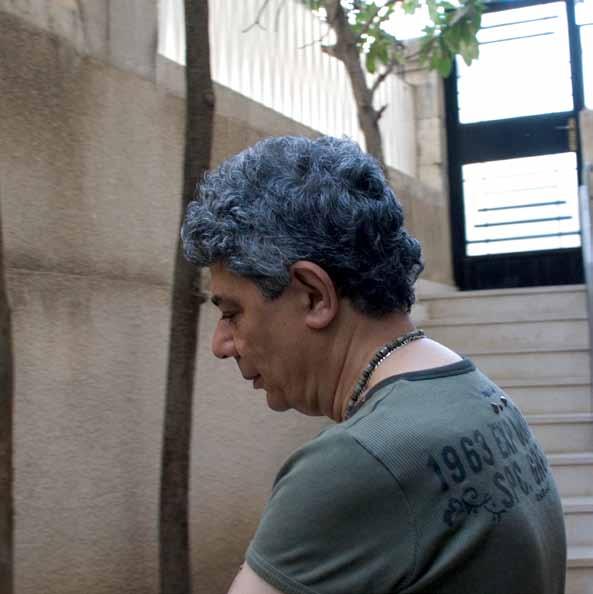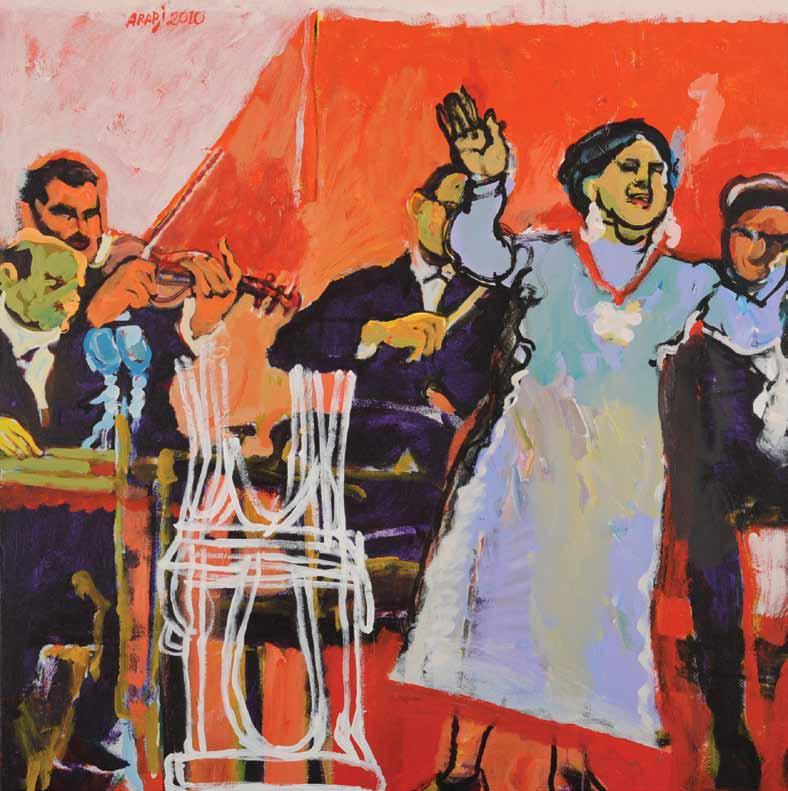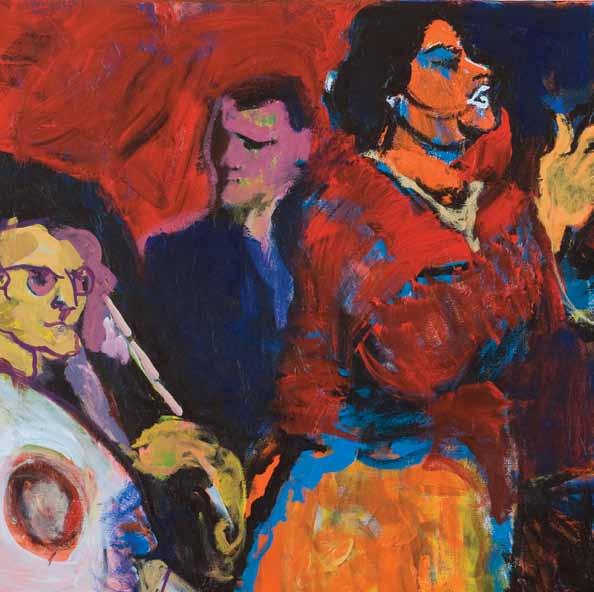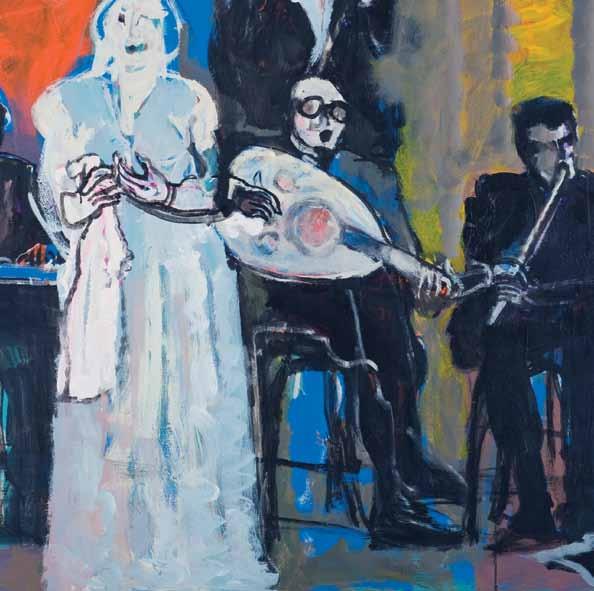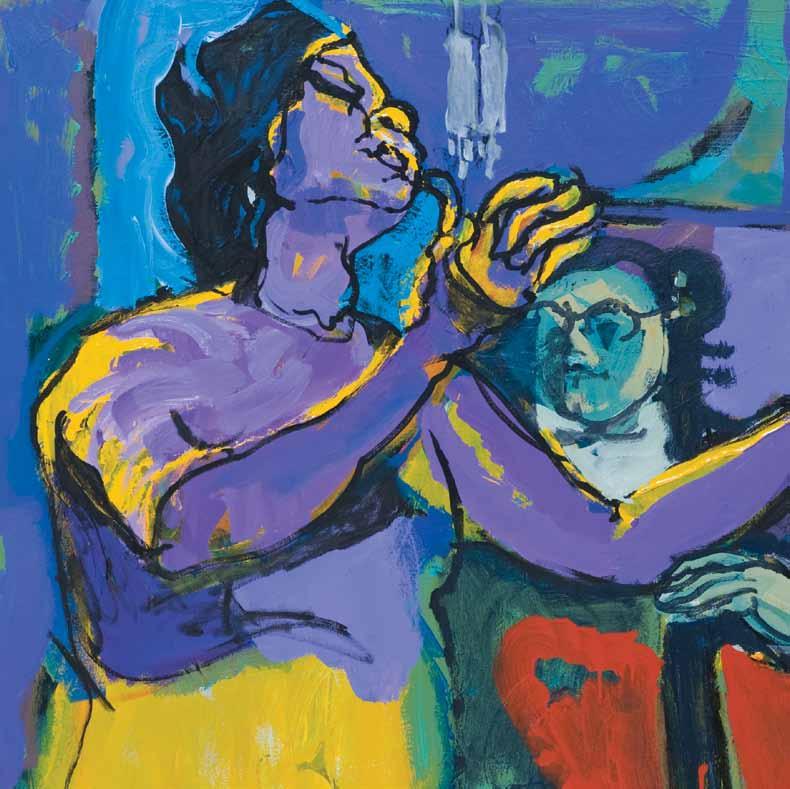Asaad Arabi NostAlgiA
© All rights reserved 2011
ayyam gallery
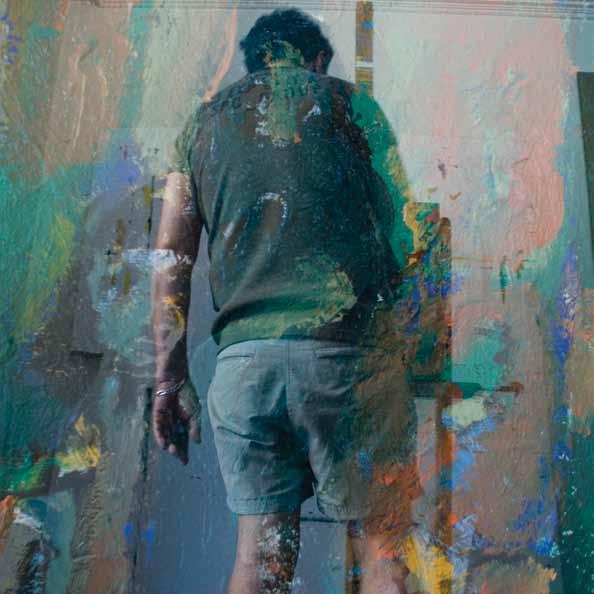
Umm Kulthum’s Burning Desire for the Absolute: The Conflict Between Spiritual Listening [Sama’] Traditions in Mysticism and the Aspirations of a National Awakening
Umm Kulthum, The Shining Star of Ecstasy (1898 – 1975)
1 – Preamble: Umm Kulthum, Ecstasy and Spiritual Listening
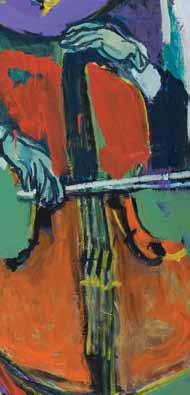
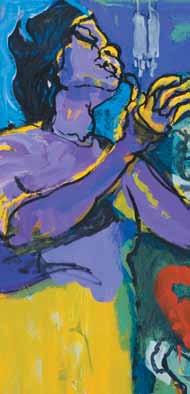
It is important to start by providing some background information on the spiritual appetence [dhawq] and gnosis [‘irfan] which lie behind the ritual and spiritual characteristics of Umm Kulthum – al-Sunbati duo; it is particularly necessary to survey the established canon of religious chant ceremonies [inshad] that are specific to members of Sufi orders, and to review the basis for some of their concepts, which have been neglected by specialists for fear of confusing authenticity and fundamentalism. Here is a sample: spiritual listening [sama’], cantors of traditional poems (qawwal), sessions of invocation of the Presence [hadra] and the Urdu language (which combines three languages: Arabic, Pahlavi, Turkish, and occasionally Pakistani Hindi, and is the language of Nusrat Fateh Ali Khan, the Sabri brothers and others). These different forms were founded as early as the 14th century and blossomed in the 16th century, at the time of the Safavid, Ottoman and Mughal empires that followed the Abbasids and Seljuks, who themselves preceded the Mamluks and Ayyubids, to name but a few.
These lyrical and musical traditions date back to the first centuries of Islam, that is, the time of Ibrahim al-Mawlisi (during the period of the Caliph Harun al Rashid) and his disciple Ziryab
10
who lived in Cordoba and added a fifth string to the lute; more specifically, they date back to the publication of two books, Avicenna’s “Al-musiqa al-kabir” [The Great Book of Music], and Abu al-Faraj al Isfahani’s “Kitab al-aghani” [The Book of Songs]. The absence or paucity of notation in this type of music is due to the nature itself of the hadra, in other words, the reliance on intuition or internal illumination specific to Sufi al-sama’ music, as can be seen from the scores written by composers such as al-Saydawi al-Dimashqi. Similarly, Al-Sunbati used to write the modalities of the overall line of the melody and the chords, but relied on oral transmission for his choice of embellishments, details and free improvisations.
The dynamism of the sama’s states of ecstasy and lyricism in the mystical experience, and their capacity to evolve, are confirmed by the correlation between its seventeen melodic modes (maqam) and celestial bodies, and their constellations (incidentally, in Ziryab’s time there were as many modes as days in the year).This was the basis for the sama’ culture and the ritual dhikr ceremonies which took place in al-qarda’a. These were described in detail in the second volume of Abu Hamid al-Ghazali’s “Ihya’ ‘ulum al-din” [Revival of Religious Sciences] under the title of “Adab al-sama’ wa al-wajd” [The Culture of Spiritual Listening and Ecstasy]. Unfortunately, our traditional music archive has all but disappeared and only a few traces remain, miraculously rescued from the claws of destruction, censorship, fanaticism and so on.
The presence of “Transcendence” [tanzih] goes beyond the effect produced by the text, to the extent that concept and anthropomorphism [tashbih] fuse in the singer’s or cantor’s [qawwal] ecstasy [munshid], intoxicating singer [mutrib] and musician so that the level of spiritual bliss rises together with the fusion of concepts. This is the reason why the name “Brotherhood of Appetence” [jama’at al-dhawq] and of esoteric knowledge [al-irfan] is given to sama’ ensembles and orchestras. This appetence correlates with excellence in faith and behaviour [ihsan], and together they are linked to solitude [tafrid] and surpassing oneself [tajrid].
Sama’ is a treasure considered to be the source for different maqam [melodic modes], nawba [nouba] and wasla, which emerged from the rhythms of Arabic poetry and its prosody and metres from the tenth century onwards; al-Sunbati was later to firmly establish their conventions, which were then maintained by the Nahda [the Arab Awakening] masters in Cairo and Aleppo. The way was paved by numerous melodies: the call to prayer [adhan], the phrase ‘God is Greatest’ / Allahu-Akbar [takbir], the phrase ‘There is no God but God’ / La-Ilaha-illa-Allah [tahlil], recitatives [dawr], celebrations of the birth of the Prophet [mawlid], hymns praising the Prophet [mada’ih], songs suggesting sleepless nights [layali], popular ballads [qudud], songs originating in Andalusia [muwashshah] and improvised dialectal songs [zajal]. It can be postulated that their main sources
were the phrases used to glorify God [tasbih] and the invocation of divine Names [dhikr], which morphed from silent, individual prayer into spoken, rhythmic prayer.
Al-Ghazali and al-Quraychi viewed sama’s impact as similar to the effects of curative theriac and the sweetness of cane sugar, the reed used to manufacture the flute [nay]. However, this very same theriac can prove poisonous for novices experiencing ecstasy. Indeed, countless disciples have lost their lives in the middle of a public ceremony during such experiences! Beginners are initiated into sama’ through training, disciples by experiencing particular states [hal], and the qawwal through individual prayer and by surpassing themselves. Sama’ was thus identified with submission, obedience and contemplation by al-Ghazali, while al-Bistami considered that “the one who is indifferent to music is deaf, and the one who is deaf has no faith in his heart”. This sheds light on Mawlana Jalal al-Din al-Rumi’s [the Master of the Mawlawi order] words: “al- sama’ is the creaking of the gates of Heaven”.
The qawwal is the opposite of a storyteller, since he is both a singer and a musician, and is gifted with the refinement of mystical sama’ traditions. He has an inexhaustible capacity for memorising tunes and refined poems, whose rich textures he summons as appropriate, together with the other musicians in the orchestra, according to the situation and the type of ecstatic ceremony. He sings aloud while holding his instrument tight, following the rhythm of his heartbeat, in harmony with the quivers of his breath, sighs and blissful moans. Incidentally, the Arabs of old drew their inspiration for the curves of an oud’s resonance chamber from the shape of doves’ breasts.
The word hafla [assembly, celebration, ceremony], which comes from the term mahfil [assembly or meeting place], spread in Egypt during the Nahda period. This word implies conventions, rituals, subtleties, mortification and endurance which gradually lead one to the desire for melodic and rhythmic ecstasy [wajd]. The interpretations of these rites and their different levels vary according to different brotherhoods [tariqa] and their doctrines, but this was how Umm Kulthum and alSunbati trained their memory.
In the twenties, before meeting al-Sunbati, Umm Kulthum started her career with recitative chants; she sang Abduh al-Hamuli’s “Araka ‘asiyya al-dam‘ shimatuka al-sabru” [I see you holding back your tears, because you’re endurance itself] which she had learnt from Abu al-‘Ala Muhammad. She mistakenly thought that this song had been set to music by the latter, but with this error having triggered a scandal in the press, she became more exacting and careful when checking her sources. From the thirties onwards, she was to abandon hymnal singing [dawr], after singing alMaslub’s muwashshah “Lamma bada yatathanna” [When he started to dance], recording instead
12
the tariqa of the Sufi sheikh al-Badawi in 1932 (the date of the inauguration of radio broadcasting), by singing dhikr extracts by al-Laythi.
The “tarab” [melody, moving song] is a late notion dating back to the Nahda that refers to states of ecstasy. It works by intensifying the rapture and confusion emerging from the melody because it focuses on the spirituality of the taqsim [musical modes] and their ever-changing states (unlike today’s repetitive singing). Thus the same line of text can be sung over and over again following subtle nuances in the melody, or conversely the tune might remain the same while sections of the poem or some minute parts of words are altered.
The intensity of Umm Kulthum’s spirituality never ceased to burn throughout her life. She dedicated her talent, delicate sensibility and the subtlety of her voice to enabling the tidal waves of her “passionate, existential, ecstatic” desires to gush out. The echoes of her experience left their mark on Arabic singing throughout the twentieth century. Her death, which left me bereft in 1975, thrust the whole world into a long grieving period. A Lebanese poet presented her as “the last of the divas, as it is said of Muhammad that he was the seal of the prophets” [Khatimat al-mutribat kama kana Muhammad khatam al-anbiya’]. Ahmad Rami, her passionate lover, immediately composed a fervent lament, a few lines of which I will quote here:
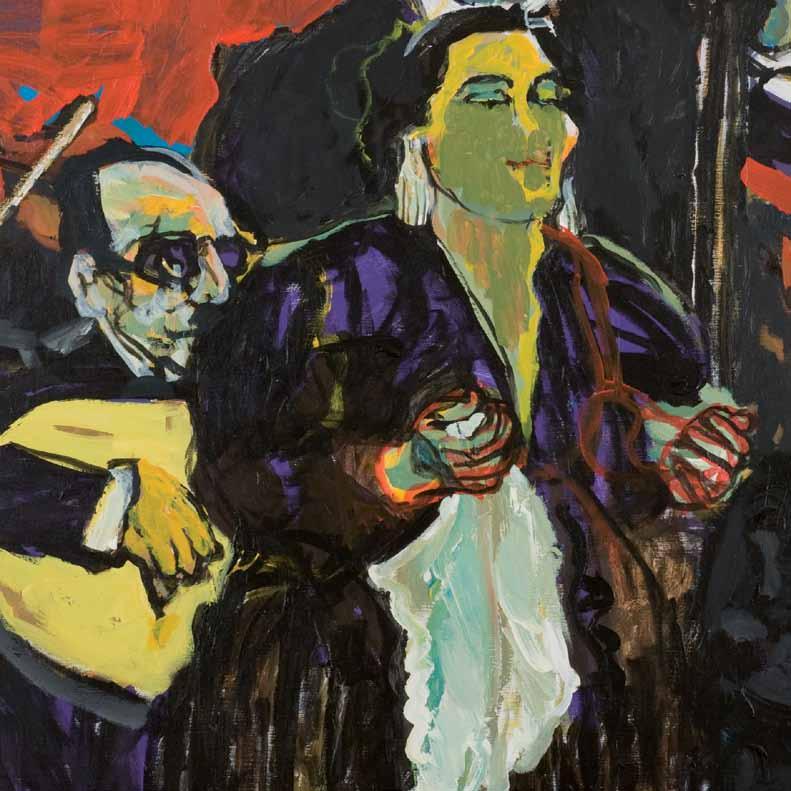
It never occurred to me that I would cry for her After all the moving melodies that I composed for her. I used to listen to her sing and I was full of joy, Today I can hear myself moan as I cry for her. You are the most radiant pearl of the arts, Glory to God, who created the universe and who created her.
2 - Foreword
I am probably not the first person to be inspired by this topic, our musical memory recalling Umm Kulthum’s golden voice and the melodies emerging from al-Sunbati’s oud in equal measure. The persisting strength of this spiritual twinning came from their affinity in taste. A third protagonist joined them: the poet Ahmad Rami. An alliance based on words, melodies and voice which intimately bound them was thus built. And nearly four decades after her death, Umm Kulthum is still present.
This framework was supported by elite musicians who were incomparable virtuosos, including the following greats: first, Muhammad al-Qasabji, composer and oud player; second, Muhammad Abduh Salih, qanun player and conductor of the orchestra [al-takht]; then the shy flute player [nay]
13
Sayyid Salim, Ahmad al-Hifnawi, the first violinist, and Ahmad al-Azma, the double bass player. As for the percussionist Ibrahim Afifi, he was considered the most skilful derbouka player after he left Munira al-Mahdiyya’s orchestra for that of Umm Kulthum’s with Hasan Anwar. This sample does not in any way aim at devaluing the other musicians who vied with one another in talent, most particularly the percussionists, the trio of cello players and the string ensemble (violins).
Umm Kulthum gathered around her the most eminent poets, among whom Ahmad Chawqi, Ahmad Rami, Bayram al-Tunusi and so on, as well as the most skillful composers, beginning with Sheikh Abu al-‘Ala Muhammad, Zakariyya Ahmad and al-Qasabji—all before al-Sunbati’s ship drew alongside the fertile banks of composition. She was supported by well-to-do families in Cairo, such as the ‘Abd al-‘Aziz family, and the two kings of the period: Fuad and Faruq. She garnered similar support during the period of the republican Revolution, particularly during the time of the leader Gamal Abdel Nasser. Umm Kulthum was also supported by the subsequent series of reformists, as she was and remains today the cultural symbol of the liberal Nahda. The memories and heritage of the prodigious composers at the end of the nineteenth century converged in her, and, as we shall see, in spite of a selective façade, her popularity was rooted in all social classes. All are allocated a share of the compositional space in my Umm Kulthum-inspired canvases, which attempt to depict the ecstatic vocal atmosphere through lines, colours, and visual language.
Her repertoire is reminiscent of the nostalgic “ardour of desires” aiming at surpassing an ancient musical cultural glory that can be traced back to al-Mawsili in Baghdad, Ziryab in Cordoba and the circle of the founders of the Nahda, from Almaz and Abduh al-Hamuli to Sayyid Darwish, without neglecting Uthman and Salih ‘Abd al-Hayy. Generation after generation, these everlasting “burning desires” are still attached to the umbilical cord of sama’s mystical “mad love” (as described by alGhazali in Adab al-sama‘ wa al-wajd).
Religious singers such as “al-Tihami” (of the Shadhiliyya tariqa), or again the ensemble of sheikh al-Tuni and his son (of the Qadiriyya tariqa in Upper Egypt) are all but forgotten in today’s radio and satellite TV programmes. This decline corroborates Ibn Khaldun’s predictions. In the fourteenth century he forecast the most important trends likely to affect the taste of city dwellers and wrote in his Muqaddima [Prolegomena]: “the decline of the art of singing is the first sign of the crumbling and retreat of civilisation.”
The deterioration of our music has been postponed by the heritage of the Umm Kulthum – alSunbati – Rami trio, which is still alive today, together with the members of its refined orchestra and a series of composers, from Abu al-Ala and Zakariyya Ahmad, to al-Qasabji and al-Sunbati.
This constellation breathed life into popular musical taste and was subsequently rewarded as it deserved, including through recognition in several museums and sculptures by al-Kawmi and Adam Hunayn. This was an opportunity for visual arts to highlight the rebirth of a distinction between authenticity and fundamentalism, renewal and hybridization, without falling into relapse (the cult of the past) or unilateral Westernisation. I will now proceed to an aesthetic, musical and visual study of Umm Kulthum’s career.
3 - Gnostic, Intuitive, Sama’ and Ecstatic Dimensions:
We should not neglect Umm Kulthum’s religious upbringing and background in her Delta village, starting with the fact that she was called Umm Kulthum in reference to the name of the Prophet’s third daughter. Her father, “al-Baltaji”, worked in the great mosque as its imam, muezzin, preacher and Koran reciter. He bequeathed his religious sensibility to his talented daughter who, after completing her studies in a Koranic school, started to work with him dressed as a boy (to avoid revealing her real gender). This enabled her to take part in religious recitation [tawashih] ceremonies [hadra], in celebrations of the birth of the Prophet [mawlid] and in circles of invocation of divine Names [dhikr]. She learnt Koranic suras and verses by heart in order to become a professional Koran reader and reciter, according to the rules of tajwid [codified reading]. The reputation of her exceptional voice first struck the ears of people from neighbouring villages before reaching those of wealthy Cairenes, such as the Abd al-Aziz family. After twelve years of Sufi chants during which she was made thurifer of the Prophet, she reached a fundamental turn in her career. Sheikh Abu al-Ala Muhammad, a disciple of Abdu al-Hamuli, was her first composer and he was responsible for training her. He remained with her in Cairo from 1922 to 1927, the year of his death. He was an imam, a muezzin, a poet and a composer. For her he composed the accompaniment to Abduh al-Hamuli’s dawr “Wa haqqika anta al-muna wa al-talab” [By you I swear, you are my only desire, you are my only quest]. She was adopted by King Fuad and after him by his son, King Faruq, who continued to venerate her. Her patriotic feelings towards Egypt then started to outweigh her religious feelings, leading her to sing “Misr al-lati fi khatiri wa fi dami” [Egypt, which is in my soul and in my blood]. While Muhammad Najib banned her songs with the eruption of the Revolution in 1952, Abdel Nasser then rehabilitated them, saying to Najib, “Why don’t you prevent the Pyramids from reaching the sky - after all, they too existed when Egypt was a monarchy,” which was the origin of the widespread metaphor of Umm Kulthum as the fourth pyramid. Her songs thus made a strong comeback on the radio, where she started broadcasting in 1934 and continued until 1973. She had her film debut in 1935 with Widad (one of five films featuring her). On the first Thursday of every month, she gave and broadcast a concert. It was meant to last for an hour, but could extend over five hours, during which she would sing from one
16
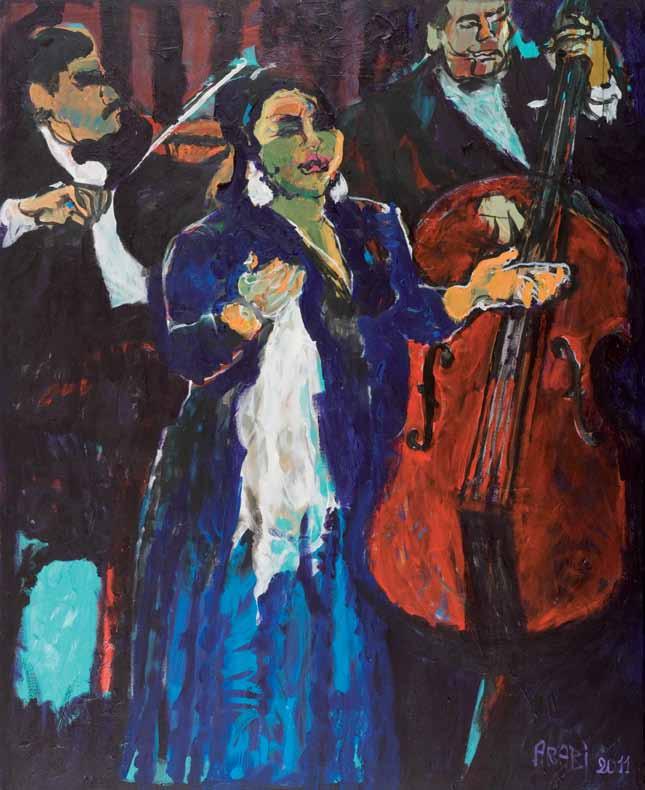
17 The Night, and the Beat of Time 162 X 130 cm. Acrylic on Canvas 2011
to three wasla (one to three variations). Later, she gave two recitals over two days, for example in the Olympia hall in Paris, each of which lasted until three o’clock in the morning. Earlier, in the thirties, she had sung in various concert halls before performing at al-Azbakiyya, then al-Zamalik, followed by the Opera, and so on.
The golden age of the “princess of the Belle Epoque”, whose voice spanned seventeen maqam, took place between 1935 and 1960. This period was initiated by her encounters with Zakariyya Ahmad and al-Qasabji, and ended with al-Sunbati and the poet Ahmad Rami. She set the rhythm of the Nahda period between the mid-twenties and the mid-seventies. The most beautiful songs that she sang were perhaps the eighty or so songs that were composed by her spiritual twin Riyad al-Sunbati and which were in great part written by the poet Ahmad Rami in the purest literary language, bringing her back to the linguistic perfection of the Koran and Sufi poems.
Undoubtedly the first turning point that had an influence on the coherence of her sung melodies was when she recruited two Azharite sheikhs, Zakariyya Ahmad and Muhammad al-Qasabji, who were counted among the greatest composers and musicians of the Nahda period. They transmitted the traditions of pillars of the musical reawakening such as Abduh al-Hamuli and Sayyid Darwish, who followed the kings of Sufi chant, religious tawshih, dhikr, mawlid, Koran reading and tajwid, all of this long before Riyad al-Sunbati (the youngest both in age and in spirit) turned her into the sultana of singing during the Belle Epoque. In the middle of the century, he composed the most beautiful, most spiritual and most distinguished melodies for her, particularly those accompanying classical poems [qasida]. It should not be forgotten that, in spite of his long experience, Wadi alSafi needed to rehearse the melody of “Hal ra’a al-hubbu sukara mithlana” [Has love ever seen anyone as intoxicated as us] several times, and the same is true of Sheikh Ahmad al-Tuni. Sunbati’s melodies, whose style and method represent the apogee of ecstasy, have influenced everybody, including Abd al-Wahhab himself.
Al-Sunbati (1906-1981), known as the al-Mansouria nightingale, had learnt the mastery of the dawr, muwashshah, ibtihal [litanies] and mawlid from his father, and committed the Koran to memory before joining the Cairo conservatory as a student where he played the oud. In 1928, thanks to his sparkling talent, he was soon appointed as a lecturer. When Sayyid Darwish heard him play, he attempted to convince his father, saying he should take him under his wing and associate himself with him. This took place in 1922, the year of the death of the latter. But the father found an excuse not to let Sunbati go because he needed to keep him in his group. In spite of the originality of his style and method, his music also received the imprint of the Nahda group
traditions. We can notice al-Qasabji’s influence on the composition of his 1954 song “Agharu min nasmati al-janub” [I envy the breath of the South wind]. Al-Sunbati’s Sufism enriched Umm Kulthum’s musical sensibility, which was spiritually close to her musical and family background. It can be said that his compositional mastery complemented the strong power of his partner’s voice. In this balanced, complementary relationship, each played his/her role, and when one was missing, the other faltered, in spite of a wealth of other singers and composers. Indeed, when she sang for another composer she was not able to reach the same impressive level; similarly, the compositions that he wrote for others did not reach the same degree of perfection. As established earlier, they were linked by similarities in terms of socio-familial background. His father was a Koran reciter and a munshid in dhikr and mawlid circles. Sunbati worked with him for a while before joining Abd al-Wahhab’s ensemble as a lute player between 1933 and 1934. In 1935, he wrote his first song for Umm Kulthum: “Ala baladi al-mahbub waddini” [Take me to the land of the beloved]. He drew his melodies from the prosody of Arabic poetry. This is how he established his supremacy in the field of the qasida, which requires a high degree of refinement, from the point of view of both language and scansion. An example of this was the emphasis on the articulation point of individual letters, which confirmed his deep knowledge of the style of Koranic language. Shawqi’s 1960 poem “Qasidat al-Nil” [The Nile Poem] arguably had the strongest impact on the setting to music of the qasida and founded its method. Later came al-Atlal [The ruins], Aqbal allayl [Night falls], Min ajli ‘aynayk [For the love of your eyes]. The talented poet Ahmad Rami seems to have devoted himself to Umm Kulthum and al-Sunbati and wrote one hundred and thirty eight songs and poems, that is, about half of Umm Kulthum’s songs.
The Umm Kulthum – al-Sunbati duo coalesced within the blurred edges of Sufi singing, which they moulded according to norms inspired by the rhythms and maqam of mystical chants. They favoured the use of choirs as well as precise rhythms that better suited the atmosphere of dhikr and religious chant circles [tawashih] by resorting to the “bayati” maqam, which is close to tajwid [codified recitation of the Koran] [the huzam maqam].
The most expressive example is probably the 1972 song “al-Qalb yi’chaq kulli jamil” [The heart loves all beauty], written by Bayram al-Tunusi; others are “Wulida al-Huda” [The Way of Salvation is born/the Prophet is born] in 1949; Muhammad Iqbal’s “Hadith al-ruh” [The words of the soul] in 1967; qasidas such as “Rabi‘a al-‘Adawiyya” in 1957; Ahmad Rami’s “Aqbal al-layl” [Night falls], written before he translated The Rubayyat of Omar Khayyam from the Persian in 1949; and “al-Atlal” [The ruins].
She also sang nine songs by Ahmad Chawqi, two of which belonged to the Sufi repertoire: “Salu
20
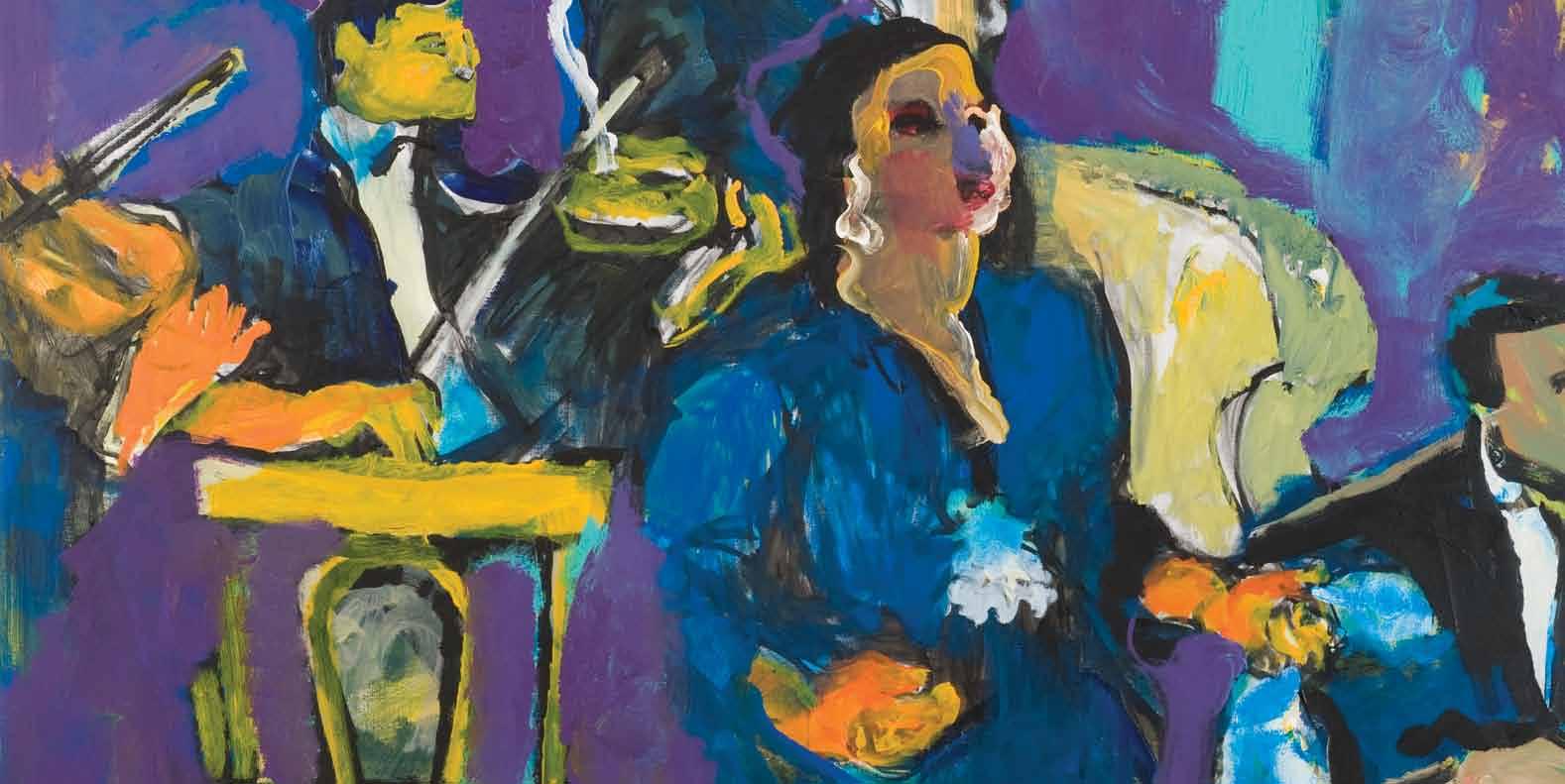
qalbi” [Ask my heart] and “Nahj al-Burda” [The way of the cloak [the Prophet]] in 1946. It is said that most of Umm Kulthum’s songs, and certainly the most successful, were composed by alSunbati. There might be as many as one hundred and seven of them. While regretting his only film, he preferred to remain isolated, and in his solitude, he turned over the same Sufi symbols in his mind, calling his oud, the companion of his long hours, “the gazelle” [al-Ghazal]. I am currently making a portrait of al-Sunbati playing on his gazelle, dressed in his house clothes, in a state of ecstasy, away from Umm Kulthum…
In her own space, Umm Kulthum seemed to be a night creature. Her evening concerts used to last for one to three hours (until the first light of dawn), and there were one to three wasla as well, in addition to for her two concerts at the Olympia in Paris in 1967, which each lasted until three o’clock in the morning. These were sleepless nights in which her passionate sighs and layali were not unlike Umar al-Khayyam’s lack of sleep, as described in the Ruba‘iyyat she sang: “Ma atala annawmu ‘umuran wa-la qassara fi-l-a‘mari tul as-sahar” [Never does sleep prolong life, but sleepless nights do not shorten life either]. She cried over the chimera of platonic love, which is so pure that it remains out of reach, veiled with an eternal sadness equal to that of Electra or al-Khansa, an infinite sadness which, at the height of emotion, either turns into tears or into smiles—the frail boat of her moans reaching the banks of a perpetual “ecstasy”. In the burning rise which took her from the material to the spiritual, she became internal rapture, well beyond Umar al-Khayyam’s vain musings. Indeed, she was a being transfigured by an intimate link with Mawlana Jalal al-Din al-Rumi’s passion, the Master of the Mawlawiyya [whirling dervishes] to whom she was much closer than al-Shadhili, Abd al-Qadir, al-Rifa‘i or al-Naqshbandi.
It is not by chance that the famous dancer Maurice Bejart attempted to create a choreographed theme halfway between Umm Kulthum’s Sufism and Mawlana’s doctrine. We can only decipher the structure of Umm Kulthum and al-Sunbati’s Sufi songs by referring to Jalal al-Din al-Rumi’s wisdom, as his was the path linking word, melody, and heavenly music. One of his disciples indeed claimed the trees of paradise bear bells which chime spiritual melodies. Once it happened that someone lost consciousness after listening to music. Having been brought round by his frightened companions, he said, “I was in paradise but you did not notice it,” implying that he had been intoxicated by a Sufi melody but that they had woken him up. This explains Jalal al-Din al-Rumi’s words: “Many paths lead to God. I have chosen that of music and dance” (referring to music as a secret and intuitive mode). Al-Rumi was the model for Sufi composition, and al-Sunbati emulated him. To speak with Mawlana or about him, to report his words or to converse with him, all this amounts to saying: Presence [hadra], nirvana, passion induced unconsciousness, beatitude and theophanic ecstasy [tajalli]. These are all spiritual states, instances of subtle, intimate, Gnostic,
passionate, existential and ecstatic mortification, which God uses to enlighten the hearts of the chosen few and seal those of the masses by blinding their sight and judgment, by making them deaf and obstructing their capacity to hear [sama’], thus keeping them away from spiritual virtue, contemplation, beauty and the witnessing of God. Praise to God who alone knows, through the wisdom of the seen and the hidden, when he gives the choice and when he forces.
The structure of al-Sunbati’s melodies, which were divided into three parts, degrees, or wasla, is based on modulation mechanisms which put musical ecstasy within reach. This brings to mind the definition of ecstasy in al-Sulami’s “Tabaqat”, “It is as if one surrendered to the blue depths of the ocean without, at the same time, wishing to be saved from drowning”. This was the meaning of a spiritual state, ecstasy, revelation and illumination for al-Sunbati and Jalal al-Din al-Rumi, which explains why both appreciated isolation as a way of purifying themselves from the sins and the din of the everyday world, which kills silence and the opportunity for contemplation and the refining of melodies.
Umm Kulthum was a diva who seemed suffused with an aura both magical (Pharaonic) and Gnostic. Her towering, upright stature (in spite of her modest size) was reminiscent of an Italian opera singer’s—not coincidentally, she interpreted the opera Aida with al-Sunbati, in which her leanings towards the Nahda were concealed beneath a Pharaonic appearance. On several occasions, I have painted her with Nefertiti’s head because of the similarity of their hairstyles: a white comb planted in her ebony hair brought up in a wide sweep and tied back in a bun. This was a sign of the imperial charisma, which led some to call her the “Sultana of the Belle Époque”. Her involvement was symptomatic of a concentration of power reaching the level of tyranny, as well as a relentless seriousness. She sharply scolded any musician who committed an error during rehearsals and she placed musicians on stage according to her immediate needs: behind her stood the flautist and al-Qasabji, the lute player (who was not allowed to compose songs because he had committed the blunder of taking an interest in Asmahan’s melodies), while the qanun player received implicit instructions to guide the others. The size of this orchestra was not fixed, but there were never less than eighteen and not more than thirty members. She never disclosed what she was going to sing during her concerts or recording sessions. Her work was sacralised to the extent that it cannot be assessed. Her strong personality, the gracefulness of her face, and the tips of her fingers, which were straight from the charm of the Thousand and One Nights, are one aspect of her particular rituals.
She was theatrical and lively, moving in a wide space, going back and forth along with applause and religious ovations. Her voluminous white earrings waltzed in harmony with the swinging of her ivory silk handkerchief, which she in turn pulled and let go, because in her intoxication, this was
24
how she released tension; she was majestically and ceremoniously clad in a dress embroidered with precious gems, with a shiny white necklace matching her earrings. She favoured turquoise dresses—the colour of Islam—and this was also the colour of the large ring that she never took off, having inherited it from her mother. As for the necklace, it was often crescent-shaped, an Islamic symbol, or star-shaped, its many colours twinkling round her neck. Her intense expressiveness showed in the way she moved the fingers of her left hand. Her whole being vibrated, moving back and forth in space to the pulsating beat of the melodic phrase. Her face, which exuded purity and innocence as well as an overwhelming femininity, expressed both the tolerance of ascetics and the sternness of Pharaohs.
In short, she was endowed with magnetic power, unfailing self-possession and a face of Egyptian beauty reminiscent of the Alexandria Girls in Mahmud Said’s portraits. She slowly brought her audience of connoisseurs to feel the languor of tarab, of bliss and timeless ecstasy. Her eyes closed, she seemed to withdraw into herself until intoxication. There, in between maqams, her ecstasy and rapture intensified, as did her flight away from the melody and the score. Al-Sunbati’s melodic style provided her with margins of ebb and flow that suited her intuitive nature, made up of melody, songs, and music. Their single common desire was to draw alongside the banks of ecstasy.
The “Lady” used to greet the audience with great distinction before sitting down on a cane chair that was characteristic of traditional popular crafts, identical to those also used by her ensemble. A little before the end of the musical prelude, after a discreet sign to the orchestra, she stood up and started singing in a moderate voice, before gaining in vitality and progressively attaining the trance stage. The musicians in Umm Kulthum’s orchestra were organised into two levels separated by the step typical of oriental architecture, which made it possible for her to organise them according to the score. Her seat was a little high, which enabled her to tap out the beat with her foot while waiting to sing. Once standing, she discreetly whispered directions to members of the orchestra, either in person, or through the mediation of the conductor who was the qanun player. The arrangement of musicians indicated the degree of importance she attached to them, the first five being the most eminent, the most important, the most gifted, and the closest to her. She thus shared her stardom with select musicians and when one (for instance the qanun player or the first violin placed near him) completed his solo work, he would stand up to bow to the audience.
I will remind you that I have depicted her seat in most of my canvases, either as forming part of her, either upside down in a far away corner, symbolising al-Qasabji’s chair which she kept in its
place after he died, depositing his upside down oud in its hollow.
When I paint from memory, some symbolic details elude me. For example, I did not draw her crescent-shaped brooch in spite of the sharp shape and colour of the original, because I prefer to linger on spiritual rather than descriptive elements.
4 - The Renaissance Project and the Distinction Between Renewal and Hybridity
In spite of Umm Kulthum and al-Sunbati’s long shared allegiance to religious musical education, the study of their archived repertoire shows they were keen to move away from the hymnal character of dervish chants and dhikr circles. They indeed noticed the intellectual and ideological difference between authenticity and fundamentalism. Her patriotic feelings (which kept rising from the period of the monarchy to the age of the republic) were to triumph over religious leanings. Their collaboration enabled them to invest in the creative and fluid inventiveness of the notion of ‘taste’ in the Sufi heritage, and they became pillars, not to say symbols, of the cultural doctrine (Nahda), which appeared at the end of the nineteenth century, shaking the dust of the Ottoman period, with its inertia and degradation. Imagine Umm Kulthum singing a song such as “Misr al-lati fi khatiri wa fi dami” at the time of the monarchy or after 1952; the songs that were considered as an inherent element of the hymnal heritage, like the ones quoted above, such as “al-qalb yi‘chaq kulli jamil”, express the universal values of love and passion much more than those of a backward religiousness.
Attitudes as well as behaviours revealed this desire for openness. Not coincidentally, al-Sunbati was referred to as “effendi”, rather than Azharite, the title used for the two sheikhs Zakariyya Ahmad and al-Qasabji. This coincided with him making the radio recording orchestra rehearse his compositions, and replacing the traditional caftan and turban with a fez and western suit.
Umm Kulthum’s evident attempts to free herself from the seals of backwardness started with her strong and free personality and her refusal to wear the veil, encompassing her indifference towards rumours about Ahmad Rami’s love for her. Once more, she encouraged other women to liberate themselves (following Qasim Amin’s legacy) even to the extent of public clashes. One such instance occurred during her visit to Libya in 1967, when she advised women to take off their veil [burqu’], saying to them: “society expects a lot from our role”. You only have to examine Umm Kulthum’s audience as visible in her recorded concerts, even in the period preceding the fifties, to see, not only her subtle and refined taste, but also her obvious liberation compared to prevailing backwardness and fanaticism. She appeared before her audience as an opera singer adorned in jewellery (particularly diamonds) and armed with the fascinating smile of Egyptian women. I have
26
also already mentioned that she had previously sung opera in the manner of Verdi in “Aida”. It can be said that the strongest sign of the Nahda’s trademark openness was the spirit of conciliation towards the other, particularly his/her language. Let me remind you that Ahmad Rami took it upon himself to teach Umm Kulthum French as he himself had spent several years studying at the Sorbonne in Paris. She continued her French studies to the extent that she startled her friends on the occasion of her two concerts at the Olympia in Paris in 1967 by sending a formal tribute to President Charles de Gaulle in a telegram written in French. His reply was the now famous telegram in which he told her that the pounding which had seized his heart when he heard her voice paralleled the delicious shiver of the French people.
Ahmad Rami also translated Umar al-Khayyam’s Ruba‘iyyat from the Persian, and the song Umm Kulthum extracted from this was one of her masterpieces. He was also one of the actors in the refinement of her Arabic language. He shared al-Sunbati’s interest in the literary beauty of the Koran as applied to the art of the qasida, while drawing his inspiration for his melodies from Arabic prosody. In this context, we can name nine songs by Ahmad Chawqi, first and foremost “The Nile”.
Al-Sunbati can undoubtedly be considered as one of the pillars of the Nahda amid the series of founders of modern composition, starting with al-Maslub, Uthman and Darwish, together with Abd al-Wahhab, Zakariyya Ahmad and al-Qasabji. They were the ones who discarded the tradition according to which women specialised in short, light songs [taqtuqa] and men in dawr. They enabled dawr to mutate into a medley of qasida, muwashshah and mawwal [a prelude on a slow mode], by relying on the different branches of melodic theories (varying according to the different maqam: rast, bayati, sikah, hijaz, saba, jiharkah, iraq, zanjaran, etc.)
No distance separated text and melody. Indeed, when poets were slow to provide poems, Zakariyya Ahmad himself composed the lyrics to his songs. In contrast, Ahmad Rami, who was a fine connoisseur of musical maqam, reproached Umm Kulthum for being partial to the maqam’s abundance of ornamentation, which could prove detrimental to the unity of the melody.
It is a well known fact that Umm Kulthum was to sing al-Busiri’s poem “al-Burda” (the most laudatory panegyric of the Prophet]. She changed her mind however, as this poem was extremely widespread in Cairo’s Sufi circles, dhikr, and mawlid. She opted instead for a selection of verses from Ahmad Chawqi’s poem “Nahj al-Burda” and asked al-Sunbati to set them to music, which he did.
Umm Kulthum had no pretensions about her position in the Nahda. It was an integral part of her intellectual breathing process, but she did not prejudice the strength of her early religious
education. Her wide audience called her “Thuma” in reference to the heroine of one of Tawfiq al-Hakim’s plays (he was one of the most prominent symbols of the Nahda) who always kept in touch with Umm Kulthum although he was the epitome of misogyny. Needless to say, Umm Kulthum’s position on the Nahda’s intellectual scene was without equal. This explains why Nagib Mahfuz was to name one of his daughters after her. Her role as a forerunner of the Nahda can therefore only be accurately assessed by leafing through the list of her contemporaries, whether they be men of letters, such as al-Hakim but also al-Aqqad, Taha Husayn, Rami and Chawqi; musicians, such as Abduh al-Hamuli and Munira al-Mahdiyya; al-Rayhani theatre playwrights, such as Marie Munib and Muhammad al-Qusari; dancers such as Carioca and Samia Jamal, with their innovative dancing style; or visual art pioneers such as Raghib Ayyad and Mahmud Said. The Nahda started at the end of the nineteenth century, when Muhammad Uthman and Abduh alHamuli discovered the phonograph, which had been imported from Istanbul shortly before 1900, with records starting to become widespread in 1903. Ten years later, Umm Kulthum started singing Salama Hijazi’s Sufi invocations and Abduh al-Hamuli’s song “Araka ‘asiyya al-dam” (adapted by Abu al-‘Ala Muhammad). However, it was the songs celebrating her homeland that bear witness to her patriotic and national chord, particularly those that she sang after the 1952 revolution and during Abdel Nasser’s period. Radio broadcasting, which dated back to the period of the monarchy (1932), transformed itself during the Republic to gain the name of “Sawt al-‘Arab” [The voice of Arabs], as it was widely broadcast.
Her taste for national anthems became more deeply rooted in 1967, the year of defeat, which she managed to turn into a victory thanks to a tour of several Arab countries, such as Tunisia and Sudan, where she gave concerts, a tour that ended with two other concerts at the Olympia, in Paris. After Abdel Nasser’s early death, her distress was deep and she announced a three-month mourning period during which she would abstain from singing.
Her twin, al-Sunbati, spiritually won over the composers of his time but he was at the same time, by the constant renewal of his output, an undeniable supporter of the Nahda. He found inspiration for his tunes in two-hemistichal rhyming poetry and prosody, unlike al-Qasabji, who did not like to set literary language to music, or to write scores for his tunes except for their general structure. Al-Sunbati gained recognition as a precursor as early as the fifties in spite of his young age, when he attempted to transform taqtuqa into what was going to replace it: the sung dawr.
He similarly rejected the unconditional divorce between the horizontal melodic structure typical of oriental music and the reliance on the orchestra of its western counterpart. This was in evidence in the thirty-eight pieces of instrumental music that he composed and which have all been lost except
28
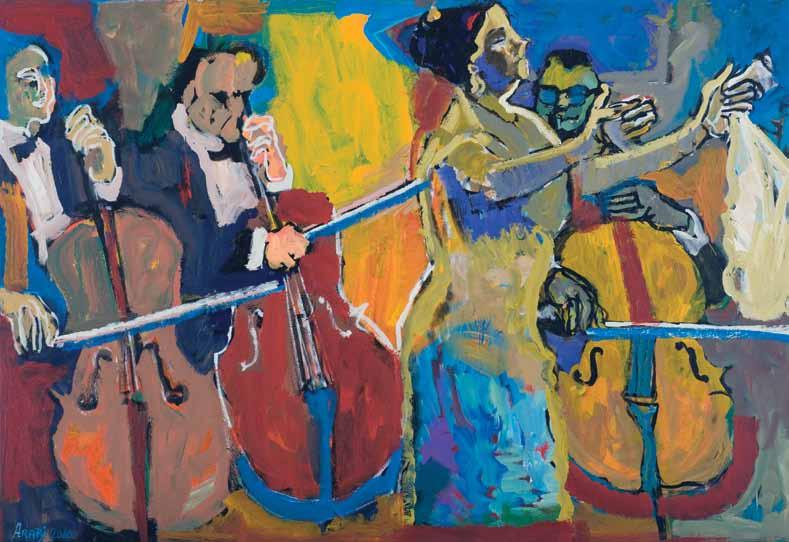
29
The Cello Trio 130 X 190 cm. Acrylic on Canvas 2010
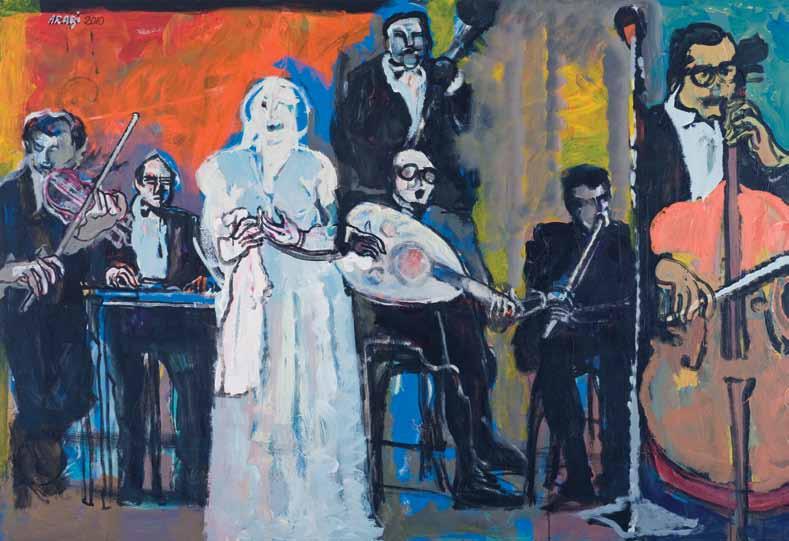
31
The Big Five 130 X 190 cm. Acrylic on Canvas 2010
for two, which were recorded when broadcast. Similarly, Umm Kulthum appreciated western music, as can be seen by her agreeing to play the role of Aida in Muhammad al-Qasabji and Ahmad Rami’s opera imitated from that of the Italian composer Verdi, which was performed the day of the opening of the Suez Canal in the presence of the Khedive. But it can be said she did not like imitation as she claimed on several occasions that: “Western music is sublime, but it does not attain ecstasy”.
It has to be acknowledged, however, that Umm Kulthum’s orchestra suffered from the introduction of some oddly shaped and odd-sounding instruments which did not suit the texture of oriental music, such as the electric piano, the accordion, the electric guitar and the saxophone, which drowned the subtle sounds of the oud and other string instruments. The violin was tuned one tone higher to harmonise with oriental music, which is why it was called Western violin [oud Rumi], that was also true of the instruments derived from the double bass, such as the cello. Umm Kulthum had, since the thirties, resisted calls to sing to Abd al-Wahhab’s melodies, in spite of the latter’s genius, specifically because she worried her voice might adapt to the register that is particular to modern instruments. It is known that Abdel Nasser had requested both of them to collaborate, if only on a single song, as they owed him a lot. Although Umm Kulthum (reluctantly) agreed, it took a year before she finally agreed to sing “Inta Omri” [You are my life] in 1964. She had already started to collaborate with other modern composers. We do not know who is to be credited for hybridising Umm Kulthum’s orchestra, since some members also performed al-Sunbati’s songs. It is claimed that the musical cast was imposed by Umm Kulthum, which led to a courteous disagreement between her and al-Sunbati. He apparently screamed to her face on the radio: “Do you want to mark my melodies with your stamp as well?” What is certain in any case is that Abd al-Wahhab declared that he had cut the umbilical chord between “religious litanies and composition” since the thirties, which clearly constituted a call for facile westernisation (which is not to deny his fundamental original authenticity). Let us concretely examine Abd al-Wahhab’s melodies and those of others outside al-Sunbati and Umm Kulthum’s circle. Some differences are obvious. It is also clear that Abd al-Wahhab and Umm Kulthum’s most successful composition was the song “A-ghadan alqak” [Shall I see you tomorrow?], which she sang at the end of her life and can be attributed to al-Sunbati if the process of gradually approaching ecstasy was not inverted. It might be necessary, in order to give al-Sunbati his due, not to accept any compromise whatsoever. In the sixties, the greatest Arab architect, Hasan Fathi, solved the problem of the confusion between modernity and hybridity by criticising the servile imitation of western architecture for taking into account neither the local natural environment nor the climate, comparing it to a “Sudanese dressed as Louis XIV “ (cf. his book: “Architecture on the side of the people”).
The path to renewal is only possible through balanced cultural interactions, not through imitation
and cultural invasion or unilateral globalisation. We can only communicate with the arts of Alaska or of the faraway Maldives Islands by exchanging tastes and mutual knowledge. Incidentally, in the context of the exchange of musical instruments and the proliferation of a whole family of string instruments, it occurs to me that the British, when they invaded what is now Pakistan, imposed the harmonium (a kind of accordion which is placed on the ground and played while sitting down). For decades this instrument suffered from its uprooting before being adopted by the mystical qawwal and being integrated into the local sama’ traditions. As time went by, Britain forgot about it, and after many modifications, it became a Pakistani instrument. It is today considered the basis of Nusrat Fatih Ali Khan’s orchestra. It is sometimes played solo to set the main melodic line before percussions and the zither intervene, sometimes with the ensemble. These days, this Sufi singer is one of the virtuosos among spiritual musicians. Central Asian music relies on the shash maqam system, which uses a variety of rhythms in order to intensify emotion, and not on the monotony of rhythm, as is the case for Arabic music and the Arabic recitation of litanies (such as the religious and secular tawashih). Thus from its beginnings as a colonial instrument, the harmonium has become a universal instrument, or rather the instrument of a renewal that relies on openness to the other without abandoning cultural specificity.
It is important to review the characteristics of Arabic music and to understand how they differ from those of Western music in order to grasp the fine line between renewal and hybridising (Westernisation). It is well-known that Arabic music is melodic and horizontal, since the heart and intuition are at the core of the composition. Composition and singing, whether solo or chorally, are one. It is written as a single line without taking percussions into account. This is why the oriental orchestra or the Sufi sama’ ensemble are limited to a simple choice of instruments, whatever their number. Thus the nay may be central, or the oud, or even the qanun; the daff [tambourine] and derbouka’s role is to accompany them. As for the jawza [buzuq] [a smaller string instrument than the oud], it is played solo. Each melody is partly hadra, partly rapture, and partly spiritual atmosphere, in ever-changing combinations. This is the part that cannot be written because it varies; it can start from left to right, or the opposite, without a finale, because its opening is similar to the gradual taqsim of unveiling or illumination. In Umm Kulthum’s orchestra or the Nahda more generally, a few string instruments were added that suited the ensemble, such as the violin or the cello. This music can be said to be two-dimensional, like the miniatures in manuscripts.
Western music by contrast is three dimensional. Its bases were established by Bach’s works which were intimately linked to the polyphonic organ use in churches. It is based on the simultaneous dialogue of a single instrument with several others, which is called counterpoint or philharmonics. This is why it is written on several parallel lines, within a somewhat egalitarian orchestrated
34
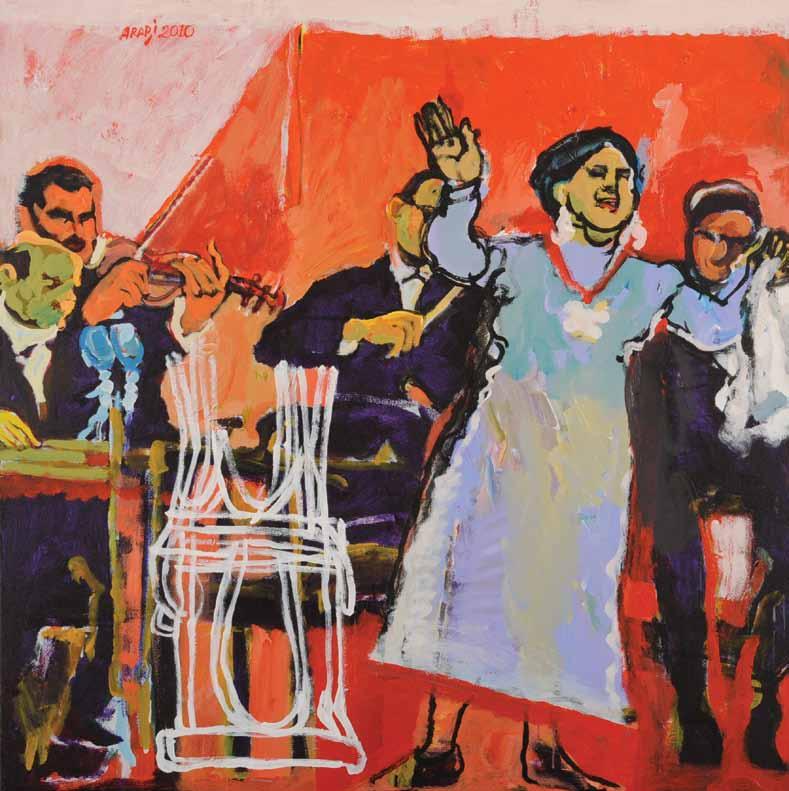
35
The Absent Chief 140 X 140 cm. Acrylic on Canvas 2010
dialogue in which different instruments—wind instruments, brass instruments, percussions and string instruments—share roles. Mahler’s music involved up to a thousand musicians, while Stravinsky’s and contemporary music have morphed into a cubist relation between the structure of surfaces and the different pitches of simultaneous sounds ranging from noises and percussions to vocal landscapes, etc. The varying interpretations brought by individual conductors such as tempo modifications, vibrating or high-pitched expressive tunes (tragic), etc. stand in contrast to the hadra of the first category (the category of individual or intuitive inspiration). The hadra corresponds to the Andalusian saying: “Beautiful music enters the ear without asking for permission”. The former seems to take the shape of a pyramid-shaped gradation divided into three movements where allegro and lento alternate. This is a quick overview of the two genres, but it does not mean that one can free oneself from traditional rules, because the system of the concerto is based on the predominance of a single instrument dialoguing with the orchestra, while chamber music is satisfied with four to eight instruments. Often in the music of Moroccan (Andalusian) litanic phrases, the orchestra can accommodate up to thirty or forty musicians. In the Shadhiliyya, Qadiriyya, etc. hadra, the tahlil of the audience mixes with that of the musicians to form a dancing group, which is reminiscent of the collective hand clap of sailors in Gulf countries. At this stage, it is important to draw a distinction between elite music and popular music, because we are concerned with the first genre here, since we are talking about Umm Kulthum and her ensemble.
To conclude, it is important to distinguish between two-dimensional scores which rely on the wealth and subtlety of the conversion of a single musical note up to more than half a tone on the musical scale (which is why the instruments are called quarter-tone instruments, even if in Ziryab’s time they reached the eighth of a tone, depending on the virtuosity of the oud player); and on the other hand, the piano, which is an instrument originally conceived to play a note at times affected by a half-tone (sharp or flat), the same being true of the accordion. This was the source of the problem encountered by Nusrat Fatih Ali Khan and his father when playing the harmonium. However, Indian musical traditions (which are the same in Pakistan) have turned the percussion instrument into a compensation instrument. In any case, zither equals oud, qanun or santoor in terms of their importance and central position in creating a spiritual atmosphere; this is at least true for the raga, a musical genre in which Shankar and his daughter Anoushka specialised. Having said that, the mix between Indian music and Western music has also produced decadent and ridiculous films, which can be found in the international markets of globalisation. It seems that our modernised music is in the process of enduring the same fate, that is, the mixing of subtle maqam with the rhythms of the samba, the bolero, the waltz, rap, rock-n-roll, etc—all of this under the guise of modernisation. It is important when discussing this topic to aim for evolution,
not degradation, as some believe for example that it might be desirable to restrict the existing seventeen maqam to eleven or seven. This extremely important topic was discussed during the last conference on Arabic music held in Cairo in 1932, during the time of King Fuad.
5 - Return to the Starting Point:
Muhammad al-Qasabji, Umm Kulthum, Farmer (the greatest Arabic music specialist) participated in this international conference, as well as, notably, the Hungarian composer Bela Bartok, the greatest contemporary composer of international fame who died in the 1940s in Budapest. AlQasabji went to Aleppo to experience its bubbling musical culture up close as he had heard so much about it. When asked why he only composed songs for Umm Kulthum, he replied: “I suffer from deafness when it comes to anything that is not Umm Kulthum’s voice”. It seems that the discussion that took place between him, Umm Kulthum and Bela Bartok (the leader of the listening section), had a great influence on contemporary musical processes initiated by Bartok’s works, more particularly his piano works. It gave him the impetus to gather thousands of Middle Eastern melodies (from Turkey/Anatolia, Northern Syria and the Balkans) and to insert them in his Hungarian archive that was influenced by Ottoman music. His music exhibits an extremely complex and highly modernist harmonisation between the heritage of (popular) horizontal music and (elitist) philharmonic music. It is thought that Bartok’s research has had a more significant impact than that of his Russian contemporary, Stravinsky, due to his return to the norms of pyramidal, horizontal music and his violation of the various traditional rules of classical music. Among his most famous compositions, his arrangement for two pianos with only a percussion accompaniment stands out and confirms his rhythmic originality. Haven’t I told you that renewal is the power to influence and to be influenced?
It is now time to point out the power that Umm Kulthum exerted on the famous contemporary choreographer Maurice Bejart, who died a few years ago. A love for Mawlana Jalal al-Din alRumi united them both. Bejart, a Frenchman, submitted himself to the words of the master of the Mawlawiyya who said, “Many paths lead to God; I have chosen that of dance and music”. Thus Bejart, after retiring as an internationally famous ballet dancer, turned to the spiritual dimension of dance (and particularly Sufi dancing). He had an intense relationship of spiritual passion with Umm Kulthum, especially after he settled down in Lausanne (Switzerland) with his company, escaping from the hell of the Paris mafias and lobbies. They knew each other personally, and he devoted as much space as possible to her, that is as many as three wasla, in his first international dance programmes, some of which were banned in Beirut because several dancers
38
had bare torsos. This prompted me to devote my previous exhibition to him and his work, and to what in this work had been subjected to religious censorship. In this exhibition, “The Masks of the Body”, I borrowed his style to depict limbs and bodies freed from terrestrial gravity, and allow them to move lightly in the emptiness of a surreal world where space is leaf, wall or mirror.
In the last choreography performed before his death and entitled “Eighty days around the world”, he still considered Umm Kulthum as a spiritual symbol. He attempted to gather a range of cultures and mystical choreographies from around the world, from Vivaldi to Ancient Greece and from Latin America to Umm Kulthum. He choreographed the song “Ta’iban tajri dumu‘i nadaman” [I have repented and my tears ooze regret], which I believe is part of the repertoire of Rabi‘a al-‘Adawiyya that was set to music by al-Sunbati, and which was performed in several theatres, more particularly in Paris, and recorded as a DVD, which is now only available in video libraries. There has been such demand for it that it is now out of stock or extremely difficult to find.
I would like to add that I am not alone in reviving in my paintings the memory of the one who was such an exceptional being and that I am joined by millions in my nostalgia and respect for her. However, from the visual point of view, I am perhaps the closest to her metaphysical anguish, which oscillates between the spiritual and the religious. I resemble her in my zeal to extract greatness from the charm of the past and glorify the masters buried in mausoleums, qarda‘a and khanqah [convents]. She is like Nagib Mahfuz, Zakariyya Tamir, Jamal al-Ghitani, al-Sa‘dani, Idris, Saïd al-‘Adawi and al-Jazzar, and her passionate outpourings are intended for them, for a certain elite, as well as for those who resemble them in their degree of spiritual appetence. They constitute her vast audience, living only from day to day, with her as their spiritual nourishment. It is then understandable why all social classes meet around her music.
The pairing of my work as a painter with Umm Kulthum’s music and style goes beyond this magical collective nostalgia. It is possible that behind my passion there is a harmonious parallelism and a desire for fusion between perspicacity and sama’ (in the field of intuition) according to al-Ghazali’s definition of perspicacity and al-Suhrawardi’s of sama’. Similarly, Paul Klee and Kupka claimed that the spiritual dimension of the canvas comes from its fusion with music or in other terms, that it emanates from the sense associated with seeing and hearing, that is, from the heart.
I have reached a point beyond the incandescence of international artists of Bela Bartok and Maurice Bejart’s calibre generated by the ardour of her repertoire, as in “Wa lastu bi-l-musaddiq fika qawlan” [I do not believe what I have been told about you]. This led me to spend nine years of unceasing toil as a researcher at the Sorbonne (in the Aesthetics and Art department),
haunted by this intense unity. My doctoral thesis was entitled: “The Relationship Between Music and Painting in Islamic art”. Completing this research involved spending a whole year comparing Arab-Muslim spiritual music and its melodic characteristics and the spiritual creation systems ruling the miniatures adorning manuscripts and the flowery patterns of carpets and kilims.
In 1957 (when I was at secondary school), I spent a year at the music conservatory in Damascus. I remember applying myself to playing “Awwidti ‘ayni” [I got my eyes used to it), which marked the start of al-Sunbati and Umm Kulthum’s magical influence. I have been convinced ever since that if I had not been a painter, I would have become a musician. After this point, my collection of rare musical pieces grew, including some by Umm Kulthum, and sama’ has become a fundamental part of my daily musical activity, together with reading and the attending of exhibitions. The intensive research that I made a lot of effort to publish in French and Arabic reveals the intensity of this link and what little time I had left for painting.
For the last two years or so, I have found myself, as if by chance, listening to Umm Kulthum every day on one of the satellite channels while drawing in ink in a sweet and serene atmosphere not devoid, however, of a tinge of absurdity. I mainly draw the musicians that formed the “Lady’s” orchestra, starting with al-Qasabji’s oud and the main cello. I ignored missing details until my Cairo exhibition when I was able to correct them in situ: the nay player grasping his air cylinder, unaware of terrestrial gravity; perpendicular lines of seats; then the violin player; finally the head of the qanun player more than his instrument. It did not take me long to understand that I was revolving around my visual prey, Umm Kulthum, attracted by the magnificence of her dance, which luxuriantly illuminated space. Even if I did not like all her songs equally, I still disciplined my tastes without prejudice, by privileging everything that had been composed by al-Sunbati, followed by Zakariyya Ahmad and finally al-Qasabji. I cannot tolerate any of the others, I have to say it frankly, because al-Sunbati’s style (that is, the movement of passion) is closest to my individual painting style. I had to uproot Umm Kulthum’s world, including the intensity of her national and patriotic sensibility, from the intoxication of the serene and spiritually balanced Belle Époque, into today’s world of blatant, aggressive and absurd modernity, which bears the stigma and the echoes of the failures of globalisation. Then I had to communicate on canvas the memory and intense emotion, which verges on obsession, of my interpretative inspiration, immersed as I was in the sound of colour and line. What I have just explained does not in any sense constitute a musical divagation because my canvas suffers from the same problems, ambiguities and the same conflict around the question “which Umm Kulthum is this all about?”she whose music and singing inhabit my soul.
Asaad Arabi, Paris 2011
40
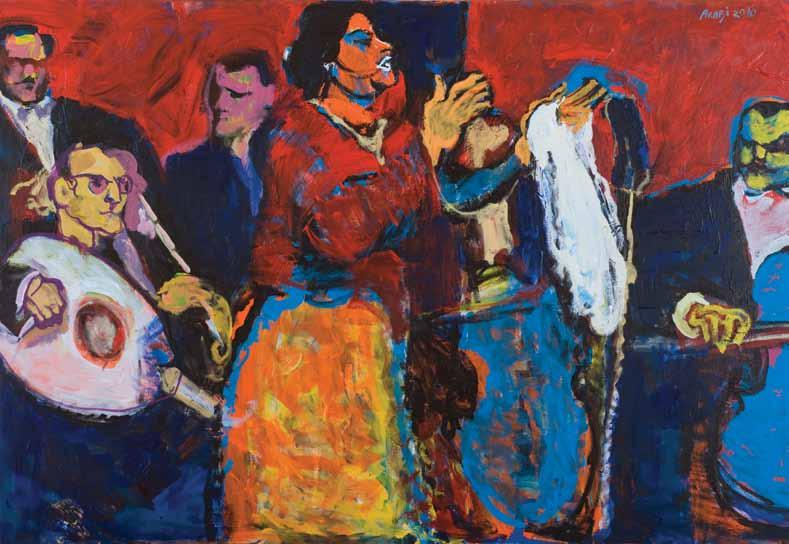
41 Musical Trance 130 X 190 cm. Acrylic on Canvas 2010
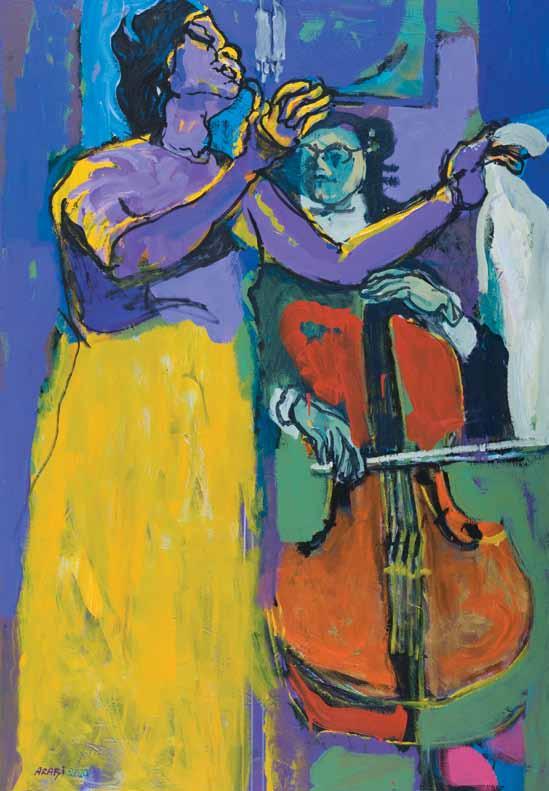
43
Hal Ra’a Al-Hubbu Sukara Mithlana (Has Love Known Desire Like Us) 190 X 130 cm. Acrylic on Canvas 2010
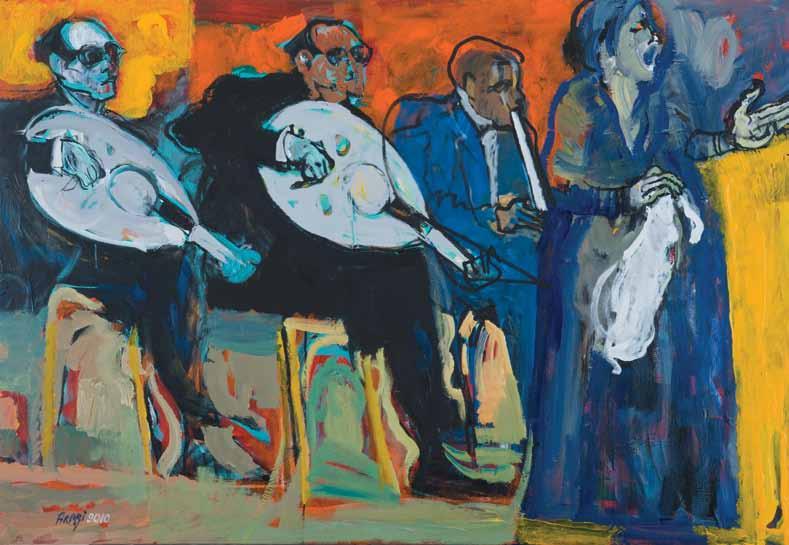
45
Mohammad Al-Qasabji + Mohammad Al-Qasabji 130 X 190 cm. Acrylic on Canvas 2010
L’ardent désir d’absolu chez Um Kulthûm
Conflit entre les traditions de l’audition spirituelle (samaï)
mystique et les aspirations d’une renaissance nationale
Um Kulthûm, Astre de l’extase (1898 – 1975)

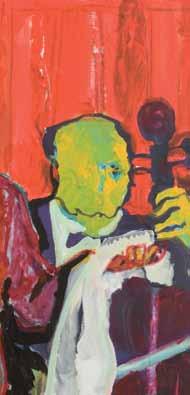
1 - Préambule : Astre de l’extase et de l’audition spirituelle : Il est nécessaire de réviser le fond pédagogique de l’appétence spirituelle (dhawq) et de la gnose (‘irfân), qui se situe derrière les caractéristiques spirituelles rituelles du duo : « Um Kulthûm
- al-Sunbâtî », notamment les canons des cérémonies de chants religieux (inchâd) des membres des ordres soufis, et les bases de certains de leurs concepts que les spécialistes évitent de mentionner de peur de confondre authenticité et fondamentalisme. Citons parmi eux la liste suivante de variétés : l’audition spirituelle (samaï), les chantres de poèmes traditionnels (qawwâl), les séances d’invocation de la Présence (hadra) et la langue urdu au sein de laquelle trois langues se sont amalgamées : l’arabe, le pahlavi, le turc et parfois l’indo-pakistanais (langue de Nusrat Fatih Ali Khan, des frères Sabrî, et d’autres). Ces différentes sortes furent fondées dès le quatorzième siècle et prospérèrent au seizième, époque des empires safavide, ottoman et mongol qui succédèrent à l’ère des Abbassides et des Seljukides, laquelle précéda les Mamelouks, les Ayyoubides, et quelques autres.
Ces traditions lyriques et musicales remontent à celles des premiers siècles, c’est-à-dire au temps d’Ibrâhîm al-Mawsilî (époque du calife Hârûn al-Rachîd) et de son disciple Ziryâb qui vécut à Cordoue et ajouta au luth sa cinquième corde, ou plus
48
exactement, à l’apparition des deux ouvrages : « Al-mûsîqâ al-kabîr » (Le grand livre de la musique) d’Avicenne et « Kitâb al-aghânî » (Le livre des chants) d’Abû al-Faraj al-Isfahânî. L’absence (ou la déficience) de la notation de cette musique est due à la nature même de la hadra qui est intuition ou illumination intérieure propre à la musique soufie al-samaï, comme le prouvent les partitions de compositeurs tels al-Saydâwî al-Dimachqî. Al-Sunbâtî notait les modalités de la structure générale de la mélodie et des accords en s’appuyant dans ses ornementations, ses détails et ses libres improvisations sur la transmission orale.
Ce qui affirme le dynamisme et les capacités d’évolution des extases et des états lyriques du samaï dans l’expérience mystique, c’est l’association de ses dix-sept stations (maqâm) avec les corps célestes et leurs constellations (du temps de Ziryâb elles étaient aussi nombreuses que les jours de l’année), et c’est ce qui a fondé la culture du samaï et des cérémonies rituelles du dhikr qui se déroulaient au sein d’ (al-qardâ‘a). Ceci est commenté en détail dans le deuxième tome de « Ihyâ’ ‘ulûm al-dîn » (Revivification des sciences de la religion) d’Abû Hâmid al-Ghazâlî sous le titre de « Adâb al-samâ‘ wa al-wajd » (Culture de l’audition spirituelle et de l’extase). Malheureusement, de nos archives de musique traditionnelle qui ont presque complètement disparu, il ne reste que quelques traces épargnées par miracle des griffes de la destruction, de la dissimulation, du fanatisme, etc.
La présence de la « Transcendance » (tanzîh) va au-delà de l’effet exercé par le texte, au point que se réalise la fusion du concept et de l’anthropomorphisme (tachbîh) dans l’extase du déclamateur (munchid), du chantre (qawwâl), du chanteur enivrant (mutrib) ou du musicien, de sorte que le niveau de la délectation spirituelle monte à mesure que fusionnent les concepts. C’est la raison pour laquelle on donne le nom de « confrérie de l’appétence spirituelle » (jamâ‘at al-dhawq) et de la connaissance ésotérique (al-‘irfân) aux groupes et orchestres de samaï. Cette appétence s’associe à l’excellence dans la foi et le comportement (ihsân), et l’union est liée à l’esseulement (tafrîd) et au dépassement de soi (tajrîd).
On considère que les trésors du samaï sont depuis le dixième siècle la source d’où ont émané les différents maqâm (modes), nawba (nouba) et wasla, qui ont débuté avec les cadences des mètres prosodiques de la poésie arabe – dont al-Sunbâtî allait plus tard fixer solidement les conventions – et qui ont continué ensuite chez les maîtres de la Nahda (la Renaissance arabe) entre Le Caire et Alep. Cette voie fut tracée grâce aux multiples mélodies de l’appel à la prière (adhân), de la formule : Dieu est Grand : Allâhu-Akbar (takbîr), de la formule : Dieu est Unique : Lâ-Ilâha-illâ-Allâh (tahlîl), des récitatifs (dawr), de la célébration de la naissance du Prophète (mawlid), des hymnes à la louange du Prophète (madâ’ih), des chants qui évoquent les nuits d’insomnie (layâlî), des ballades populaires (qudûd), des chants d’origine andalouse (muwachchah) et des chants dialectaux improvisés (zajal). On peut avancer
que leurs sources essentielles sont les formules de glorification de Dieu (tasbîh) et d’invocation des Noms divins (dhikr), qui de prière muette intime se transforment en prière proférée et cadencée.
Al-Ghazâlî et al-Quraychî considèrent que le samaï possède un impact qui ressemble à l’effet de la thériaque curative et à la douceur du sucre de canne, ce roseau dont est tirée la flûte (nây). Cependant, cette thériaque peut se transformer en poison pour les néophytes qui font l’expérience de l’extase, car combien de disciples ont perdu la vie lors de ces expériences en pleines cérémonies publiques ! Le débutant s’initie au samaï par l’apprentissage, le disciple par l’expérience des états (hâl), et le qawwâl par des oraisons intimes et le dépassement de soi. C’est ainsi que le samaï est lié chez al-Ghazâlî à la soumission, à l’obéissance et au recueillement, tandis qu’al-Bistâmî voit que « celui qui est insensible à la musique est dépourvu d’ouïe, et celui qui est dépourvu d’ouïe, son cœur ne possède pas la foi ». D’où l’expression de Mawlânâ Jalâl al-Dîn al-Rûmî (maître de l’ordre Mawlawî) : « al- samaï, c’est le crissement des portes du Paradis ».
Quant au qawwâl, il représente l’opposé du conteur, car il est à la fois chanteur et musicien, doté de la finesse des traditions mystiques du samaï. Il a une mémoire intarissable d’airs et de poèmes raffinés, dont il convoque la richesse, selon les cas, avec les autres musiciens de l’orchestre, au gré des circonstances et des cérémonies extatiques. Il chante à haute voix en étreignant son instrument au rythme des palpitations de son cœur, en harmonie avec les frémissements de sa respiration, avec ses soupirs et ses gémissements de félicité. Ceci nous rappelle qu’on rapporte que les Arabes anciens se sont inspirés, pour le galbe du « ‘ûd » et de sa caisse de résonance, de la forme de la poitrine des colombes.
Le terme mahfil [assemblée, lieu de réunion] est à l’origine du mot hafla [assemblée, célébration, cérémonie] qui s’est répandu en Egypte à l’époque de la Nahda. Ce terme requiert des conventions, des rituels, des subtilités, des mortifications, des endurances qui peu à peu amènent au désir de l’extase (wajd) mélodique et rythmique. Les interprétations de ces rites et de leurs échelons diffèrent selon la confrérie (tarîqa) et sa doctrine. C’est ainsi que s’est faite l’éducation mémorielle du duo Um Kulthûm – al-Sunbâtî.
Dans les années vingt, et avant de faire la connaissance d’al-Sunbâtî, elle commença son itinéraire par des chants récitatifs et chanta « Arâka ‘asiyya al-dam‘ chîmatuka al-sabru » (Je vois que tu retiens tes pleurs, car tu es toute endurance) de ‘Abduh al-Hamûlî qui lui fut enseignée par Abû al‘Alâ Muhammad. Elle crut par erreur que cette chanson avait été mise en musique par ce dernier, mais après avoir déclenché par cette erreur un scandale dans la presse, elle devint plus rigoureuse et plus méfiante dans sa documentation. A partir des années trente, elle allait abandonner le chant
50
hymnique (dawr), après avoir chanté « Lammâ badâ yatathannâ » (Lorsqu’il a commencé à danser) muwachchah d’al-Maslûb, pour enregistrer en 1932 (date de l’inauguration de la radiodiffusion) la tarîqa du cheikh soufi al-Badawî, en chantant des passages de dhikr d’al-Laythî.
Quant au « tarab » [mélodie, chant émouvant], c’est une notion tardive qui date de la Nahda et qui traduit les états de l’extase, multipliant le ravissement et la confusion qui émanent de la mélodie, en se concentrant sur la spiritualité des taqsîm (modes musicaux) et de leurs états qui ne se répètent jamais (au contraire de la rumination répandue de nos jours), avec la possibilité de reprendre une même phrase du texte selon les nuances subtiles des mélodies, ou vice-versa, l’air restant invariable tandis que ce sont les paroles du poème ou certaines particules imperceptibles des mots qui changent.
L’ardeur de la flamme spirituelle d’Um Kulthûm ne s’est jamais calmée tout au long de sa vie. Elle a voué son talent et la délicate sensibilité de la subtilité de sa voix à faire jaillir les océans de ses désirs « passionnels – existentiels – extatiques ». Les échos de son expérience n’ont cessé de marquer de leur empreinte le chant arabe du vingtième siècle. Sa disparition, qui nous a éprouvés en 1975, a depuis plongé le monde entier dans un deuil prolongé. Un poète libanais l’a présentée comme « la dernière des divas, comme on dit de Muhammad qu’il était le sceau des prophètes » (Khâtimat almutribât kamâ kâna Muhammad khâtam al-anbiyâ’). Ahmad Râmî, l’ardent amoureux, lui composa aussitôt une fervente élégie, dont je cite quelques vers :

Il ne m’est jamais venu à l’esprit que je la pleurerais Après toutes les émouvantes mélodies que je lui ai composées. Je l’écoutais chanter et je me réjouissais, Aujourd’hui je m’entends gémir en la pleurant. Ô perle de l’art, vous en êtes la plus resplendissante, Gloire à Dieu, qui a créé l’univers et qui l’a créée.
2 - Avant-propos
Sans doute ne suis-je pas le premier à être inspiré par ce sujet, dont les évocations de la mémoire musicale se partagent la voix d’or d’Um Kulthûm et les mélodies du ‘ûd d’al-Sunbâtî. La perpétuité de ce jumelage spirituel s’appuie sur l’alliance de leurs goûts. A eux s’est joint un troisième protagoniste : le poète Ahmad Râmî. C’est ainsi qu’à partir des mots, des mélodies et de la voix s’est formée une alliance qui les unissait intimement. Et quelque quatre décennies après sa mort, Um Kulthûm est encore là.
Cette trame était épaulée par une élite de musiciens incomparablement virtuoses, parmi lesquels on peut citer les cinq grands suivants : le premier d’entre eux est Muhammad al-Qasabjî, compositeur
et joueur de ‘ûd. Le second est Muhammad ‘Abduh Sâlih, joueur de qânûn et chef de l’orchestre (al-takht). Vient ensuite le timide joueur de flûte (nây), Sayyid Sâlim, puis Ahmad al-Hifnâwî, premier violon, et Ahmad al-‘Azma, contrebassiste. Quant au percussionniste Ibrâhîm ‘Afîfî, on le considère comme le plus habile joueur de derbouka, depuis son départ de l’orchestre de Munîra al-Mahdiyya pour celui d’Um Kulthûm avec Hasan Anwar. Ce choix ne dévalorise en rien les talents dans lesquels rivalisaient les autres, notamment les percussionnistes, le trio de violoncellistes et l’ensemble à cordes (violons).
Um Kulthûm avait rassemblé les poètes les plus éminents, parmi lesquels Ahmad Chawqî, Ahmad Râmî, Bayram al-Tûnusî, etc. ainsi que les compositeurs les plus brillants, à commencer par le Cheikh Abû al-‘Alâ Muhammad, Zakariyyâ Ahmad, al-Qasabjî, tout ceci avant que n’aborde aux rives fécondes de la composition la nef d’al-Sunbâtî. Elle fut aussi soutenue par les familles aisées du Caire, comme la famille ‘Abd al-‘Azîz, et les deux rois de cette époque : Fuâd et Fârûq. Il en fut de même à l’époque de la Révolution républicaine, notamment au temps du leader ‘Abd alNâser. Ce soutien s’est poursuivi avec le cortège des réformistes, eu égard au fait qu’Um Kulthûm a été et ne cesse d’être jusqu’à présent le symbole culturel de la Nahda libérale, qui concentre la mémoire et le patrimoine des compositeurs prodigieux de la fin du dix-neuvième siècle, et comme nous allons le voir, au seinmême d’une apparence sélective, sa popularité était enracinée dans toutes les classes sociales. Tous se partagent la topographie des compositions des toiles autour d’Um Kulthûm, essayant de retisser le climat extatique vocal par le biais des traits, des couleurs et du langage plastique.
Son répertoire rappelle « l’ardeur des désirs » nostalgiques visant une ancienne gloire culturelle musicale qui pourrait remonter jusqu’à al-Mawsilî à Bagdad, jusqu’à Ziryâb à Cordoue et jusqu’au cercle des tenants de la Nahda, à commencer par Almaz et ‘Abduh al-Hamûlî, jusqu’à Sayyid Darwîch, en passant par
52
‘Uthmân et Sâlih ‘Abd al-Hayy. Ces « désirs ardents » et sans fin, génération après génération, sont reliés au cordon ombilical du « fol amour » mystique du samaï (comme l’avait expliqué al-Ghazâlî dans Adâb al-samâ‘ wa al-wajd). Tous les chanteurs religieux sont aujourd’hui négligés dans les programmes de la radio et des chaînes satellitaires, comme par exemple « al-Tihâmî » (de la tarîqa Châdhiliyya), ou bien le groupe du cheikh al-Tûnî et son fils (de la tarîqa Qâdiriyya en HauteEgypte). Cette dégradation correspond à la prédiction d’Ibn Khaldûn qui, depuis le quatorzième siècle, a sonné le tocsin avertisseur des symptômes avant-coureurs les plus importants qui peuvent affecter le goût des citadins. Il dit dans sa Muqaddima (Prolégomènes) : « Le dépérissement de l’art du chant est le premier signe du dérèglement et du recul de la civilisation. »
Ce qui a retardé la détérioration de notre musique, c’est le patrimoine du trio Um Kulthûm – alSunbâtî – Râmî, encore vivant de nos jours, ainsi que celui des membres de son orchestre raffiné et du cortège de compositeurs, d’Abû al-‘Alâ et Zakariyyâ Ahmad, à al-Qasabjî et al-Sunbâtî. Cette constellation qui a réanimé le goût musical commun a été gratifiée comme elle le méritait : plusieurs musées, des sculptures d’al-Kawmî et de Adam Hunayn, et ce fut là une occasion pour que les arts plastiques ré-illuminent la renaissance d’une distinction entre authenticité et fondamentalisme, entre rénovation et hybridation, et ne confondent pas rechute (culte du passé) et occidentalisation unilatérale. Ceci exige de procéder à un examen esthétique, musical et plastique.
3 - Les dimensions gnostique – intuitive – samaï – extatique :
Il ne faut pas oublier l’éducation et le milieu religieux d’Um Kulthûm dans son village du Delta, à commencer par le fait qu’elle a été appelée Um Kulthûm en référence au nom de la troisième fille du Prophète. Son père, « al-Baltaji », était l’imam, le muezzin, le prédicateur et le récitateur du Coran de la grande mosquée. Il légua sa sensibilité religieuse à sa talentueuse fille qui, après avoir achevé ses études dans une école coranique, commença à travailler avec lui tout en s’habillant en garçon (pour ne pas révéler son vrai sexe), participant ainsi aux cérémonies (hadra) de récitations religieuses (tawâchîh), de célébrations de la naissance du Prophète (mawlid) et aux cercles d’invocation des Noms divins (dhikr). Elle avait appris par cœur les sourates et les versets coraniques pour devenir professionnelle de la lecture et de la récitation du Coran, conformément aux règles du tajwîd (lecture codifiée). La réputation de sa voix exceptionnelle frappa d’abord l’ouïe des gens des villages avoisinants, pour parvenir plus tard à celle de riches cairotes, comme la famille ‘Abd al-‘Azîz. Après douze ans de chants soufis durant lesquels elle fut dénommée thuriféraire du Prophète, on arrive à un tournant fondamental dans sa carrière. Le cheikh Abû al-‘Alâ Muhammad, disciple de ‘Abduh al-Hamûlî, fut son premier compositeur, et ce fut lui qui allait s’occuper de son apprentissage. Il demeura avec elle au Caire de 1922 à 1927, année de son décès. Il était imam, muezzin, poète et
compositeur. Il a composé pour elle le dawr de ‘Abduh al-Hamûlî « Wa haqqika anta al-munâ wa al-talab » (Par toi j’en fais serment, tu es tout mon désir, tu es toute ma quête). Elle fut adoptée par le roi Fuâd et après lui par son fils, le roi Fârûq, qui continua à la vénérer. Son sentiment patriotique à l’égard de l’Egypte commença à triompher de celui du religieux et c’est ainsi qu’elle chanta « Misr al-latî fî khâtirî wa fî damî » (L’Egypte qui est dans mon âme et dans mon sang). Lorsqu’avec l’avènement de la Révolution en 1952 Muhammad Najib interdira ses chansons, ‘Abd al-Nâser allait les réhabiliter en disant à Najib : « Pourquoi n’empêcheriez-vous pas les Pyramides de percer le ciel, elles aussi existaient du temps de la royauté », d’où la métaphore répandue qu’Um Kulthûm représentait la quatrième pyramide. Ses chants revinrent donc en force à la radio, où elle débuta en 1934 jusqu’en 1973. Elle fit ses débuts au cinéma en 1935 avec le film Widâd (l’un des cinq qu’elle a réalisés). Un concert diffusé était donné les premiers jeudis de chaque mois. Il durait une heure, mais pouvait s’étendre sur plus de cinq heures, au cours desquelles elle chantait de une à trois wasla (variation de un à trois). Plus tard, elle donna par exemple dans la salle de l’Olympia à Paris deux récitals sur deux jours, qui se prolongèrent chacun jusqu’à trois heures du matin. Auparavant, dans les années trente, elle s’était déplacée d’une salle à l’autre avant de s’installer dans celle d’alAzbakiyya, puis celle d’al-Zamâlik, et ensuite celle de l’Opéra, etc.
L’âge d’or de la « princesse de la belle époque », dont l’étendue de la voix couvrait les dix-sept maqâm, se situe entre 1935 et 1960. Cette période débuta par ses rencontres avec Zakariyyâ Ahmad et al-Qasabjî, et finit avec al-Sunbâtî et le poète Ahmad Râmî.
Elle avait réglé à son rythme la période de la Nahda entre le milieu des années vingt et le milieu des années soixante-dix. Les plus belles chansons qu’elle avait chantées sont peut-être les quelque quatre-vingts qui furent composées par son jumeau spirituel Riyâd al-Sunbâtî et dont la plupart furent écrites par le poète Ahmad Râmî dans la fine fleur de la langue littéraire qui la ramenait à la perfection linguistique du Coran et aux poèmes soufis.
Nul doute que le premier tournant qui influa sur la cohérence de ses airs chantés a commencé grâce à l’engagement des deux cheikhs azharites Zakariyyâ Ahmad et Muhammad al-Qasabjî, rangés parmi les grands compositeurs et musiciens de l’époque de la Nahda. Ils avaient transmis les traditions de ceux qui formaient les pôles de la renaissance musicale, de ‘Abduh al-Hamûlî à Sayyid Darwîch, lesquels avaient succédé aux rois du chant soufi, du tawchîh religieux, du dhikr, du mawlid, de la lecture du Coran et du tajwîd, ceci avant que Riyâd al-Sunbâtî (le plus juvénile en esprit aussi bien qu’en âge) fasse d’elle la sultane du chant de la belle époque. Il lui composa au milieu du siècle les airs les plus beaux, les plus spirituels et les plus distingués, en particulier pour des poèmes classiques (qasîda). Notons que, malgré son expérience, Wadî‘ al-Sâfî a dû répéter à plusieurs reprises l’air de
54
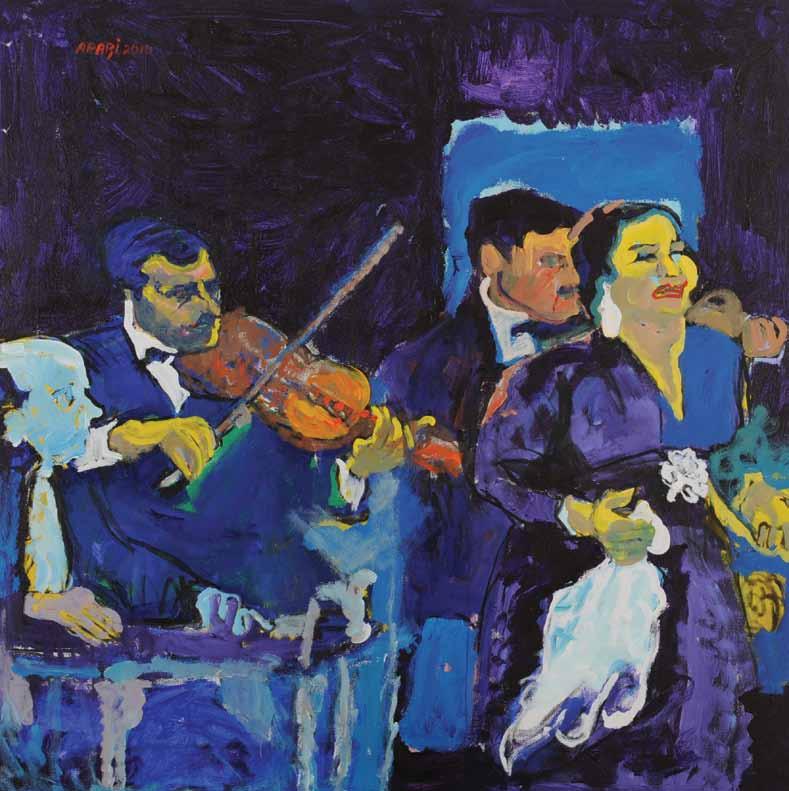
55 Oh
My Heart 140 X 140 cm. Acrylic on Canvas 2010
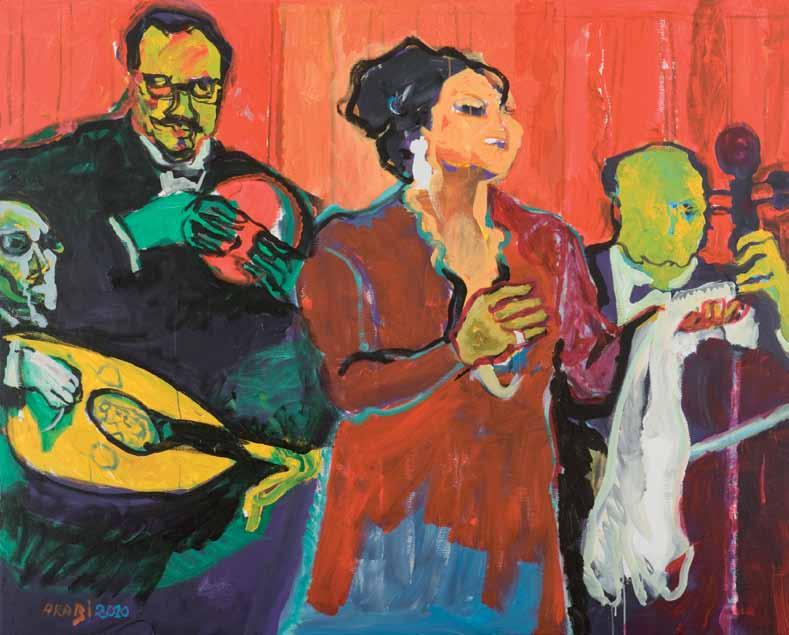
57
Maqam with Red Sonority 130 X 162 cm. Acrylic on Canvas 2010
« Hal ra’â al-hubbu sukârâ mithlanâ » (L’amour a-t-il jamais vu d’aussi ivres que nous), ainsi que le cheikh Ahmad al-Tûnî. Ses mélodies dont le style et la méthode représentent l’apogée de l’extase ont influencé tout le monde, y compris ‘Abd al-Wahhâb lui-même.
Al-Sunbâtî (1906-1981), appelé le rossignol d’al-Mansûra, avait acquis de son père la maîtrise du dawr, du muwachchah, du ibtihâl (litanie) et du mawlid, et il avait mémorisé le Coran avant de rejoindre le conservatoire du Caire comme étudiant. Il y joua du ‘ûd, mais en 1928, grâce au rayonnement de son talent, il y fut rapidement nommé professeur. Dès que Sayyid Darwîch l’eut entendu, il insista auprès de son père pour le prendre sous son aile et se l’associer. C’était en 1922, l’année du décès de ce dernier. Mais le père s’excusa car il avait besoin de le garder dans son groupe. Malgré la particularité de sa méthode et la singularité de son style, sa musique reçut à son tour l’empreinte des traditions du groupe de la Nahda. On remarquera l’influence d’al-Qasabjî sur la composition de sa chanson de 1954 « Aghâru min nasmati al-janûb » (Je suis jaloux du souffle de l’autan). Le soufisme d’al-Sunbâtî a enrichi une oreille qui lui était spirituellement proche, celle d’Um Kulthûm issue du même milieu musical et familial. On peut dire que sa maîtrise dans la composition parachevait l’emprise puissante de la voix de sa partenaire. Dans cette complémentarité équilibrée, chacun avait son rôle, et lorsque l’un des deux faisait défaut, l’autre chancelait, malgré l’abondance des chanteurs et des compositeurs. Car, quand elle chantait pour un autre compositeur, elle n’atteignait pas au même niveau étincelant, et les compositions qu’il réalisait pour d’autres n’arrivaient pas à la même perfection. Comme je l’ai dit plus haut, ils étaient reliés par la similitude de leurs situations socio-familiales. Son père était récitateur du Coran et munchid dans les cercles de dhikr et de mawlid. Il travailla un moment avec lui avant de devenir luthiste dans le groupe de ‘Abd al-Wahhâb, entre 1933 et 1934. En 1935, sa première chanson pour Um Kulthûm fut : « ‘Alâ baladi al-mahbûb waddînî » (Au pays du bien-aimé emmène-moi). Il puisait ses mélodies dans la prosodie de la poésie arabe, et c’est ainsi qu’il avait affirmé sa suprématie dans le domaine de la qasîda qui demande un niveau raffiné, tant du point de vue de la langue que de la scansion, soulignant par exemple les points d’articulation des lettres, ce qui confirmait leur profonde connaissance du style de la langue coranique. Ce fut peut-être le poème de Chawqî en 1960 « Qasîdat al-Nîl » (Le poème du Nil) qui marqua éminemment la mise en musique de la qasîda et qui en fonda la méthode. Ensuite se succédèrent al-Atlâl (Les ruines), Aqbal al-layl (La nuit tombe), Min ajli ‘aynayk (Pour l’amour de tes yeux). Le poète de génie Ahmad Râmî semble s’être consacré au duo Um Kulthûm – al-Sunbâtî. Il écrivit cent trente huit chansons et poèmes, environ la moitié des chants d’Um Kulthûm.
Le duo Um Kulthûm – al-Sunbâtî fit alliance au niveau des contours indécis de la chanson soufie, qu’il modela selon des normes inspirées des rythmes et des maqâm des chants mystiques. Il favorisa l’usage de la chorale ainsi que la précision des cadences qui s’accordent mieux avec l’ambiance des
cercles de dhikr et des chants religieux (tawâchîh) en utilisant le maqâm « bayâtî » proche du tajwîd (récitation codifiée du Coran) (le maqâm huzâm).
L’exemple le plus expressif est peut-être la chanson « al-Qalb yi’chaq kulli jamîl » (Le cœur aime toute beauté) de 1972, écrite par Bayram al-Tûnusî, précédée de « Wulida al-Hudâ » (La voie du Salut est née [le Prophète est né]) en 1949, puis « Hadîth al-rûh » (Les propos de l’âme) en 1967 de Muhammad Iqbâl, ensuite les qasîdas de « Râbi‘a al-‘Adawiyya » en 1957, « Aqbal al-layl » (La nuit tombe) de Ahmad Râmî, avant qu’il ne traduise du persan « Rubâ‘iyyât al-Khayyâm » (Les quatrains de Khayyâm) en 1949, suivi de « al-Atlâl » (Les ruines).
Quant à Ahmad Chawqî, elle chanta de lui neuf chansons, parmi lesquelles deux faisaient partie du répertoire soufi : « Salû qalbî » (Interrogez mon cœur) et « Nahj al-Burda » (La voie du Manteau [du Prophète]) en 1946. On dit que la plupart des chansons d’Um Kulthûm, et les plus réussies, furent composées par al-Sunbâtî. Elles peuvent atteindre le nombre de cent sept. Tout en regrettant son film unique, il préférait s’isoler en ressassant dans sa solitude les mêmes symboles soufis, et il nommait son ‘ûd, le compagnon de ses longues heures : « la gazelle » (al-Ghazâl). Je suis en train de réaliser un portrait d’al-Sunbâtî jouant sur sa gazelle, vêtu de sa tenue d’intérieur, en état d’extase, loin d’Um Kulthûm…
Dans l’espace qui lui était propre, Um Kulthûm semblait être une créature nocturne. Les soirées de ses concerts duraient entre une et trois heures (jusqu’aux premières lueurs de l’aube), et il y avait également entre une et trois wasla, comme ce fut le cas pour les deux concerts donnés au théâtre de l’Olympia à Paris en 1967, lesquels se prolongèrent chacun jusqu’à trois heures du matin. C’étaient des nuits d’insomnie dont les ardents soupirs et les layâlî ressembleraient plutôt à l’abstinence de sommeil de ‘Umar al-Khayyâm, lorsqu’elle chanta ses Rubâ‘iyyât : « Mâ atâla annawmu ‘umuran wa-lâ qassara fî-l-a‘mâri tûl as-sahar » (Jamais le sommeil n’a prolongé la durée d’une vie, mais celle-ci ne fut point raccourcie non plus par les longues veillées). Elle pleura sur la chimère des amours platoniques si pures qu’elles en sont hors de portée, voilées d’une tristesse éternelle parallèle à celles d’Electre et d’al-Khansâ’, de cette infinie tristesse qui, au plus fort de l’émoi, se fait tantôt larmes, tantôt sourires. C’est l’esquif de ses plaintes abordant les rivages d’une perpétuelle « extase ». Dans la brûlante ascension qui la portait du matériel au spirituel, elle n’était que transports intérieurs, bien au-delà des vanités qui furent celles de ‘Umar al-Khayyâm. Plus encore, elle fut cet être transfiguré par l’intimité de son lien avec la passion de Mawlânâ Jalâl al-Dîn al-Rûmî, le Maître de la Mawlawiyya (derviches tourneurs), et cela bien plus qu’avec celles d’alChâdhilî, de ‘Abd al-Qâdir, d’al-Rifâ‘î et d’al-Naqchbandî.
60
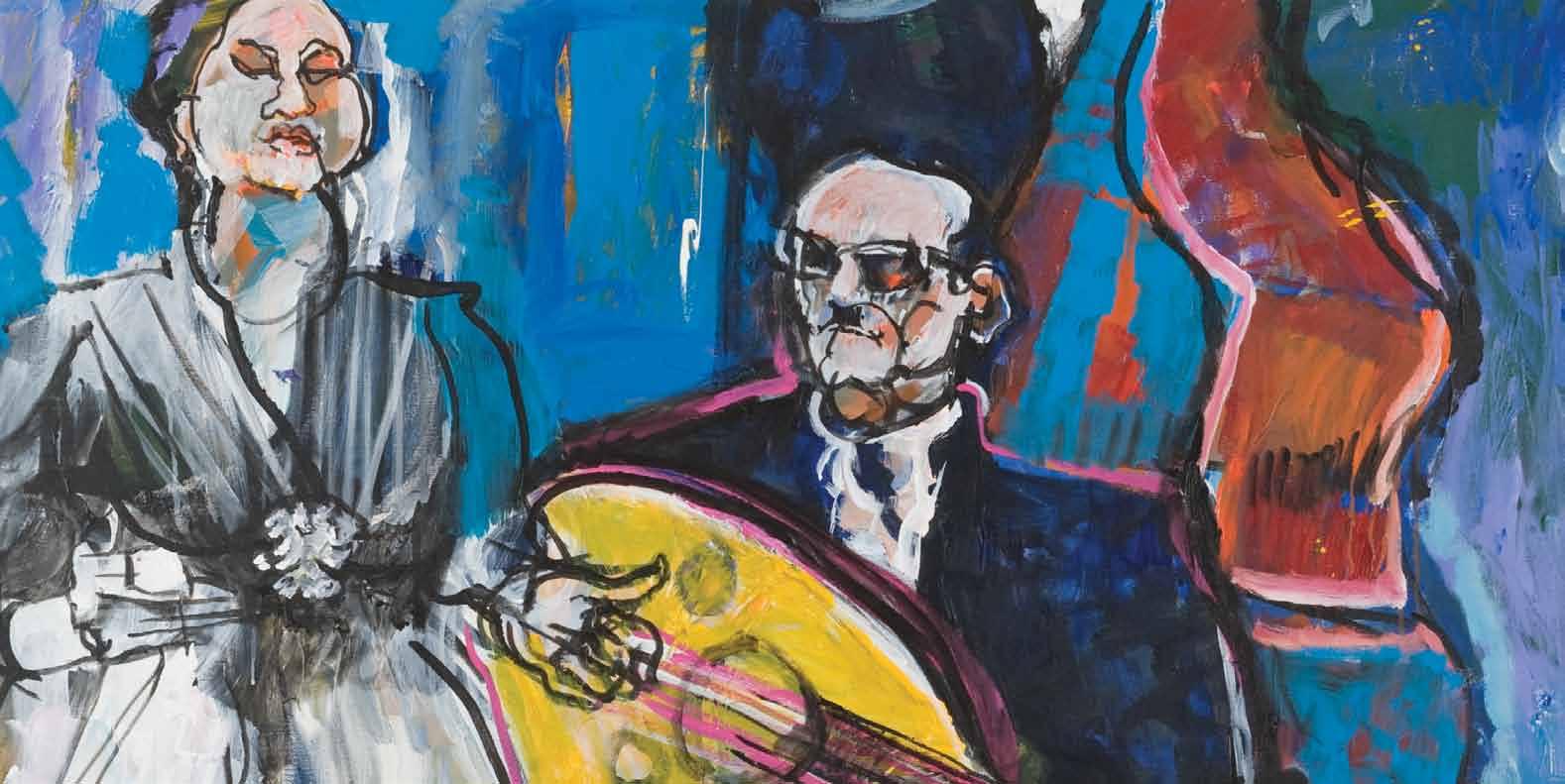
Ce n’est pas sans raison que le célèbre danseur Maurice Béjart essaya de créer un thème chorégraphique oscillant entre le soufisme d’Um Kulthûm et la doctrine de Mawlânâ. On ne peut décrypter le secret de la structure du chant soufi du duo Um-Kulthûm – al-Sunbâtî qu’en se référant à la sagesse de Jalâl al-Dîn al-Rûmî qui est cette voie où se conjuguent parole, mélodie et musique paradisiaque. Ceci fut commenté par l’un de ses disciples pour qui les arbres du paradis portent des carillons insufflant la musique spirituelle. Il advient une fois que quelqu’un perdit connaissance à la suite d’une audition. Après avoir été ranimé par ses compagnons effrayés, il leur dit : « J’étais au paradis mais vous ne vous en êtes pas aperçus », voulant dire par là qu’une mélodie soufie l’avait enivré, et qu’ils l’en avaient réveillé. Ceci explique les propos de Jalâl al-Dîn al-Rûmî : « Maintes voies conduisent vers Dieu, moi, j’ai choisi celle de la danse et de la musique» (laissant entendre par là le mode secret et intuitif de la musique). Al-Rûmî fut le modèle de la composition soufie, et c’est lui que copia al-Sunbâtî. Parler avec Mawlânâ ou à propos de lui, rapporter ses paroles ou s’entretenir de lui, cela revient à dire : Présence (hadra), nirvana, Cavallia ?, inconscience due à la passion, à la béatitude et à l’extase de la théophanie (tajallî). Ce sont tous des états spirituels, des mortifications subtiles intimes, gnostiques, passionnelles – existentielles – extatiques, par lesquelles Dieu illumine les cœurs de ses élus et scelle ceux de la masse en rendant aveugles leur vue et leur faculté de discernement, en rendant sourdes leur ouïe comme leur faculté d’audition (samaï), les écartant ainsi de la vertu spirituelle, de la contemplation, de la beauté et du témoignage rendu à Dieu. Louange à Dieu qui seul sait, par la sagesse de l’apparent et du caché, quand il donne le choix ou quand il oblige.
La structure de la mélodie chez al-Sunbâtî est fondée sur un mécanisme de modulation qui permet d’atteindre à l’extase musicale. Il divise donc la chanson en trois temps, échelons ou wasla. Il me vient à l’esprit la définition de l’extase dans les « Tabaqât » d’al-Sulamî qui dit : « C’est comme si quelqu’un se livrait aux profondeurs bleues de l’océan sans pour autant souhaiter être délivré de la noyade. » C’est le sens de l’état spirituel, de l’extase, de la révélation et de l’illumination chez alSunbâtî et Jalâl al-Dîn al-Rûmî, raisons pour lesquelles tous les deux apprécient l’isolement afin de se purifier des vices et du vacarme du monde quotidien qui assassine le silence, occasion pour la contemplation et la purification des mélodies.
Notre diva semble imprégnée de codes à la fois magiques (pharaoniques) et gnostiques. L’éminence de sa stature dressée (malgré la modestie de sa taille) est plutôt celle d’une cantatrice d’opéra italienne, et ce ne fut pas pure coïncidence si elle réalisa avec al-Sunbâtî l’opéra Aïda où son penchant pour la Nahda se dissimulait sous une apparence pharaonique. (J’ai peint à plusieurs reprises son portrait avec la tête de Néfertiti à cause de la ressemblance de leurs coiffures, le peigne blanc planté dans l’ébène de sa chevelure amplement relevée et ramassée en arrière, signe de ce
charisme impérial qui incita à la dénommer : « Sultane de la belle époque »). Son engagement révèle une centralisation du pouvoir portée jusqu’à la tyrannie, comme aussi un sérieux impitoyable. Elle rabrouait sévèrement le musicien qui commettait une faute lors des répétitions, et elle disposait les musiciens sur les planches en fonction de ses besoins immédiats : derrière elle se plaçaient le flûtiste et le luthiste al-Qasabjî (interdit de composer pour avoir commis la maladresse de s’être intéressé aux mélodies d’Asmahân), tandis que le joueur de qânûn recevait implicitement les ordres pour guider les autres. Le nombre des membres de cet orchestre n’était jamais fixe : pas moins de dix-huit et pas plus de trente. Elle ne révélait d’aucune manière ce qu’elle allait chanter lors de ses concerts ou de ses enregistrements. Son œuvre est si sacralisée qu’elle n’a pu être évaluée. Sa forte personnalité, la grâce de son visage et les bouts de ses doigts issus du charme des Mille et une nuits sont une partie de son cérémonial singulier.
Elle était théâtrale et entraînante, se mouvant dans un vaste espace, avançant et reculant au gré des acclamations et des ovations en termes religieux. Ses volumineuses boucles d’oreille blanches valsaient harmonieusement avec le balancement de son mouchoir de soie ivoire qu’elle étirait et relâchait car, enchantée comme elle l’était (elle atténuait ainsi sa tension), habillée majestueusement et solennellement d’une robe brodée de pierres précieuses, avec en particulier un collier blanc brillant accordé à ses boucles d’oreille. La couleur turquoise (couleur de l’Islam) prédominait dans ses robes, ainsi que la grosse bague qu’elle n’ôtait jamais, l’ayant héritée de sa mère. Quant au collier, il avait souvent la forme d’un croissant, emblème islamique, ou d’une d’étoile scintillant de toutes ses couleurs.
L’intensité de son expressivité transparaissait dans le mouvement des doigts de sa main gauche. Elle vibrait de tout son être, reculant et avançant dans l’espace au rythme de la palpitation de la phrase mélodique. Son visage, qui révélait la pureté et l’innocence, ainsi qu’une féminité envahissante, exprimait à la fois la tolérance des ascètes et la sévérité des Pharaons.
Bref, elle possédait un pouvoir magnétique, un aplomb sans faille et un visage à la beauté égyptienne, comme dans les portraits des Filles d’Alexandrie dans les toiles de Mahmûd Saïd. Elle amenait peu à peu son public de connaisseurs à éprouver la langueur du tarab, de la félicité et de l’extase hors du temps. Les yeux fermés, elle semblait plongée au fond d’elle-même jusqu’à l’enivrement. Là s’accentuaient son extase et ses transports entre les maqâm, ainsi que sa migration loin de la mélodie et de la partition. Car le style mélodique d’al-Sunbâtî lui offrait des marges de flux et de reflux qui s’accordaient à sa nature intuitive, comme si nous assistions à quelque genre de mélodies, de chants et de musique. Tous deux étaient seulement régis par le désir d’aborder aux rives de l’extase.
64
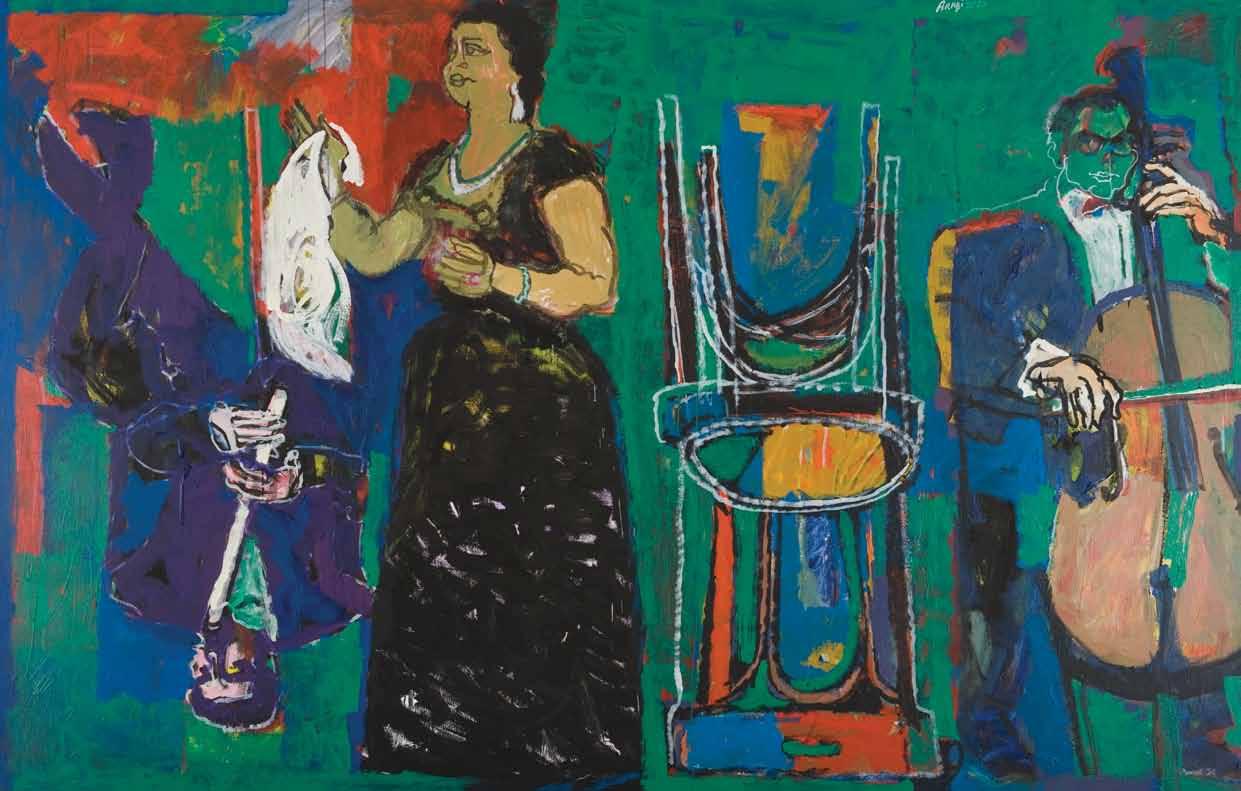
The Absent Oud Chair 190 X 300 cm. Acrylic on Canvas 2010
La « Dame » avait coutume de saluer le public avec une grande distinction avant de s’asseoir sur un siège canné caractéristique de l’artisanat populaire traditionnel, identique à ceux qui étaient aussi utilisés par son orchestre. Un peu avant la fin du prélude musical, après avoir discrètement fait signe à l’orchestre, elle se mettait debout pour commencer à chanter à voix modérée, pour ensuite monter en vitalité et atteindre progressivement à la transe. Les musiciens de l’orchestre d’Um Kulthûm se rangeaient sur deux niveaux que séparait ce dénivellement propre à l’architecture orientale, ce qui rendait possible de les classer en fonction de la partition. Son siège s’élevait quelque peu au-dessus du sol, ce qui lui permettait de battre la cadence avec ses pieds en attendant de chanter. Une fois debout, elle faisait ses remarques aux membres de l’orchestre en chuchotant discrètement, soit elle-même directement, soit par l’entremise du chef d’orchestre qui était le joueur de qânûn. La disposition des musiciens indiquait le degré d’importance qu’elle leur prêtait, les cinq premiers étant les plus éminents, les plus importants et les plus virtuoses, et les plus proches d’elle. Elle partageait de cette façon son vedettariat avec certains musiciens, et lorsque l’un d’eux (le joueur de qânûn ou le premier violon placé près de lui) avait terminé son jeu en soliste, il se levait pour saluer le public.
Il convient de rappeler que son siège est représenté dans la plupart des toiles, soit qu’il apparaisse comme faisant partie d’elle-même, soit qu’il soit retourné au loin dans un coin, symbole de celui d’alQasabjî qu’elle conserva à sa place après son décès, déposant au creux de la chaise son ‘ûd retourné.
Lorsque je peints de mémoire, certains détails symboliques m’échappent. Par exemple, je n’ai pas dessiné la broche en forme de croissant malgré la netteté de la forme et de la couleur de l’original, car c’est sur l’aspect spirituel plus que sur l’aspect descriptif que j’insiste.
4 - Le projet de renaissance et la distinction entre renouvellement et hybridation :
Malgré l’adhésion partagée depuis toujours du duo Um Kulthûm – al-Sunbâtî à l’éducation musicale religieuse, l’examen des archives de leurs répertoires montre qu’ils ont voulu s’éloigner du caractère hymnique des chants des derviches et des cercles de dhikr. Ils avaient en effet relevé la différence intellectuelle et idéologique entre l’authenticité et le fondamentalisme. Le sentiment patriotique (qui monta progressivement de l’époque de la royauté à celle de la république) allait triompher du religieux. Leur collaboration leur a permis d’investir dans l’inventivité créative et évolutive de la notion de « goût » dans le patrimoine soufi, et ils devinrent des piliers, voire des emblèmes, à l‘appui de la doctrine culturelle (Nahda) qui avait vu le jour à la fin du dix-neuvième siècle, secouant la poussière de l’inertie et de la dégradation de l’époque ottomane. Imaginons Um Kulthûm en train de chanter une chanson comme « Misr al-latî fî khâtirî wa fî damî » soit à l’époque de la royauté,
soit à partir de 1952 : les chansons considérées comme une composante inhérente au patrimoine hymnique, à l’instar de celles citées auparavant comme « al-qalb yi‘chaq kulli jamîl », expriment les valeurs universelles de l’amour et de la passion bien plus que celles du religieux passéiste.
Les attitudes comme les comportements révèlent cette aspiration à l’ouverture. Ce n’est pas sans raison que le titre d’azharite qui était propre aux cheikhs Zakariyyâ Ahmad et al-Qasabjî est devenu chez al-Sunbâtî, lorsqu’il faisait répéter ses compositions à l’orchestre de la radiodiffusion, l’appellation d’ « effendi », et qu’il remplaça le caftan et le turban traditionnels par le fez et le costume occidental.
Les tentatives d’Um Kulthûm pour s’émanciper des sceaux de l’arriération étaient manifestes, à commencer par sa personnalité forte et libre et son refus de porter le voile, ainsi que son indifférence envers ce qui se disait à propos de l’amour qu’Ahmad Râmî lui portait. Plus encore, elle encourageait les femmes à s’émanciper (legs de Qâsim Amîn) et ceci parfois jusqu’à des heurts publics. C’est ce qui arriva au cours de sa visite en Libye en 1967, lorsqu’elle conseilla aux femmes d’ôter leur voile (burqu‘), leur disant : « la société attend beaucoup de notre rôle ». Il suffit d’observer le public d’Um Kulthûm visible dans ses concerts enregistrés, et ceci même pour la période d’avant les années cinquante, pour voir apparaître, non seulement son goût subtil et raffiné, mais aussi son affranchissement marqué par rapport à l’arriération et au fanatisme. Elle-même se présentait devant son public en cantatrice d’opéra toute parée de bijoux (surtout de diamants) et armée du fascinant sourire des égyptiennes. On a signalé qu’elle avait déjà chanté l’opéra à la manière de Verdi dans « Aïda ».
On peut dire que le signe le plus fort de l’ouverture propre à la Nahda fut l’esprit de conciliation à l’égard de l’autre, et en particulier de sa langue. Rappelons comment Ahmad Râmî se chargea de lui apprendre la langue française (il avait lui-même étudié plusieurs années à Paris, à la Sorbonne). Elle poursuivit ses lectures en français au point qu’elle surprit ses amis en 1967 lors de ses deux concerts à l’Olympia à Paris en envoyant un télégramme d’hommage officiel en langue française au président Charles de Gaulle, auquel il répondit par le fameux télégramme dans lequel il lui disait que la palpitation qui s’était emparée de son cœur au son de sa voix s’accordait avec le frémissement harmonieux qui était celui du peuple français.
Rappelons-nous que Ahmad Râmî a lui-même traduit du persan les Rubâ‘iyyât de ‘Umar al-Khayyâm dont le chant qu’en tira Um Kulthûm fut l’un de ses chefs-d’œuvre. Il fut aussi l’un des facteurs du raffinement de sa langue arabe. De même, il partagea avec al-Sunbâtî le même intérêt pour la beauté littéraire du Coran appliquée à l’art de la qasîda, tout en s’inspirant pour les mélodies de la prosodie arabe. Dans ce registre, on peut citer neuf chansons de Ahmad Chawqî, dont la première est « Le Nil ».
68
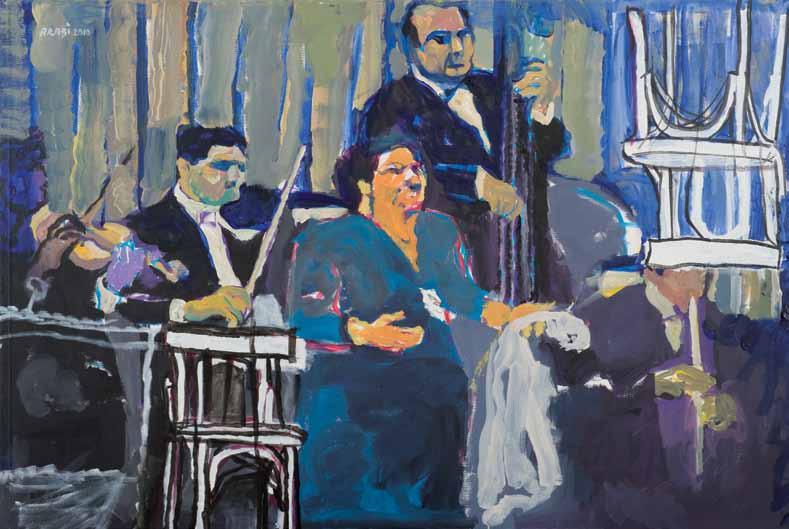
69
Chair of the Absent (Al-Qasabji) and Chair of the Present (Al-Sett) 130 X 195 cm. Acrylic on Canvas 2010
Il est certain qu’on peut considérer al-Sunbâtî comme l’un des piliers de la Nahda parmi le cortège des fondateurs de la composition moderne, à commencer par al-Maslûb, ‘Uthmân et Darwîch, parallèlement à ‘Abd al-Wahhâb, Zakariyyâ Ahmad et al-Qasabjî. C’est eux qui ont changé cette tradition selon laquelle les femmes étaient spécialisées dans les chants courts et légers (taqtûqa) et les hommes dans les dawr. C’est grâce à eux que le dawr s’est mué en un pot-pourri de qasîda, de muwachchah, de mawwâl (prélude sur un mode lent), en s’appuyant sur les théories mélodiques dans leurs différentes branches (variant entre les différents maqâm : rast, bayâtî, sikah, hijaz, saba, jiharkah, iraq, zanjaran, etc.)
Il n’y avait aucune distance entre le texte et la mélodie. En effet, lorsque les poètes tardaient à fournir leurs poèmes, Zakariyyâ Ahmad composait lui-même les paroles de ses chansons. Par contre, Ahmad Râmî, en fin connaisseur des maqâm musicaux, reprochait à Um Kulthûm d’affectionner le foisonnement des maqâm, ce qui pouvait nuire à l’unité de la mélodie.
Il est bien connu qu’Um Kulthûm aurait dû chanter le poème d’al-Bûsîrî « al-Burda » (panégyrique le plus élogieux qui soit du Prophète). Toutefois, elle se ravisa à cause du fait que ce poème était très communément répandu dans les cercles soufis, les dhikr et les mawlid du Caire. Elle préféra opter pour un choix de vers du poème d’Ahmad Chawqî « Nahj al-Burda » et demanda à al-Sunbâtî de les mettre en musique, ce qui fut fait.
Um Kulthoum n’avait pas de prétention au sujet de sa position dans la Nahda. Cette dernière faisait quotidiennement partie de sa respiration intellectuelle, sans préjudice de la force de sa précoce éducation religieuse. Et si son large public l’a dénommée « Thûma », ce fut en référence au nom de l’héroïne d’une des pièces de Tawfîq al-Hakîm (l’un des plus éminents symboles de la Nahda) qui était toujours en contact avec Um Kulthûm (bien qu’il fut le misogyne par excellence). Il va sans dire que la position d’Um Kulthûm dans le milieu intellectuel de la Nahda était incomparable. C’est ainsi que Najîb Mahfûz allait donner son prénom à l’une de ses filles. Par conséquent, on ne peut évaluer son rôle précurseur dans la Nahda qu’en parcourant le cortège de ses contemporains, soit parmi les gens de lettres, car avec al-Hakîm il y avait aussi al-‘Aqqâd, Tâha Husayn, Râmî et Chawqî, soit parmi les musiciens comme ‘Abduh al-Hamûlî et Munîra al-Mahdiyya, ou parmi les dramaturges du théâtre d’al-Rayhânî tels Marie Munîb et Muhammad al-Qusarî, côte à côte avec la danse inventive de danseuses comme Carioca et Sâmia Jamâl, et les pionniers des arts plastiques comme Râghib ‘Ayyâd et Mahmûd Saïd. On sait que la Nahda a commencé à la fin du dix-neuvième siècle, lorsque Muhammad ‘Uthmân et ‘Abduh al-Hamûlî découvrirent le phonographe qui avait été importé d’Istanbul avant 1900, les disques commençant à se répandre en 1903. Une décennie après, Um Kulthûm commença à chanter les invocations soufies de Salâma Hijâzî et la chanson
« Arâka ‘asiyya al-dam‘ » de ‘Abduh al-Hamûlî (adaptée par Abû al-‘Alâ Muhammad). Cependant, ses chansons qui célèbrent la patrie prouvèrent sa sensibilité patriotique et nationale, notamment après la révolution de 1952 et à l’époque de ‘Abd al-Nâser. La radiodiffusion qui avait de longtemps été fondée à l’époque de la royauté (1932), se transforma sous la République pour porter le nom de « Sawt al-‘Arab » (La voix des Arabes) ; elle fut largement diffusée.
En 1967, année de la défaite, son penchant pour les hymnes nationaux s’enracina, et elle parvint à transformer cette défaite en victoire grâce à une tournée effectuée dans plusieurs pays arabes, comme la Tunisie et le Soudan, où elle donna des concerts, tournée qui s’acheva par deux autres concerts à l’Olympia, à Paris. Après la mort précoce de ‘Abd al-Nâser, sa détresse se fit profonde et elle annonça un deuil de trois mois durant lesquels elle s’abstiendrait de chanter.
Quant à son jumeau al-Sunbâtî, il l’emportait spirituellement sur les compositeurs de son époque tout en étant, par sa production renouvelée, un incontestable partisan de la Nahda. Alors qu’il trouvait l’inspiration de ses mélodies dans la poésie rimée à deux hémistiches et la prosodie, alQasabjî, quant à lui, n’aimait pas mettre en musique la langue littéraire, ni écrire les partitions de ses airs (à la seule exception de la structure générale). Al-Sunbâtî fut reconnu en tant que précurseur dès les années cinquante (malgré son jeune âge), lorsqu’il tenta de transformer la taqtûqa dans ce qui allait lui être substitué : le dawr chanté.
Il refusait pour autant le divorce inconditionnel entre la structure mélodique horizontale propre à la musique orientale et son homologue occidental (qui s’appuie sur l’orchestre). Ce fut le cas lorsqu’il composa trente huit morceaux de musique instrumentale (qui sont tous perdus à l’exception des deux qui furent enregistrés par la radiodiffusion). D’ailleurs Um Kulthûm estimait la musique occidentale, comme le montre son accord pour jouer le rôle de Aïda dans l’opéra de Muhammad al-Qasabjî et Ahmad Râmî imité de celui du compositeur italien Verdi, lequel fut donné le jour de l’inauguration du canal de Suez en présence du Khédive. Si je dis qu’elle n’aimait pas imiter, c’est qu’elle avait affirmé dans diverses occasions que : « la musique occidentale est sublime mais elle n’atteint pas à l’extase ».
Il faut quand même reconnaître que l’orchestre d’Um Kulthûm souffrit de l’introduction de certains instruments à la forme et au son étranges et peu en accord avec les goûts de la musique orientale, comme le piano électrique, l’accordéon, la guitare électrique et le saxophone, ce qui nuisit à la subtilité du ‘ûd et des autre instruments à cordes (le violon fut accordé un ton au-dessus afin qu’il soit en harmonie avec la musique orientale, et c’est pourquoi on l’a appelé le violon occidental [‘ûd rûmî], et ce fut aussi le cas des dérivés de la contrebasse, comme le violoncelle). Si, depuis les
72
années trente, Um Kulthûm refusait de chanter les mélodies de ‘Abd al-Wahhâb, malgré le génie de ce dernier, c’est qu’elle craignait que sa voix n’entre dans le registre propre aux instruments modernes. On sait que ‘Abd al-Nâser leur avait demandé à tous les deux, qui étaient ses obligés, de collaborer, fût-ce pour une seule chanson. Malgré l’acceptation d’Um Kulthûm (à son corps défendant), ce ne fut qu’un an après, en 1964, qu’elle accepta de chanter « Inta ‘umrî » (Tu es ma vie). Elle avait déjà commencé à collaborer avec d’autres compositeurs modernes. Nous ne savons pas à qui attribuer la responsabilité de l’hybridation de l’orchestre d’Um Kulthûm, puisque certains d’entre eux s’associaient aussi aux chansons d’al-Sunbâtî. On dit qu’Um Kulthûm leur avait imposé la distribution musicale, ce qui aboutit à un différend courtois entre elle et al-Sunbâtî. On rapporte qu’il lui cria un jour à la figure, à la radio : « Est-ce que tu veux aussi marquer mes mélodies de ton sceau ? » Mais ce qui est certain, c’est que ‘Abd al-Wahhâb avait déclaré depuis les années trente qu’il avait coupé le cordon ombilical entre « les litanies religieuses et la composition », ce qui constituait clairement un appel à une occidentalisation facile, malgré son authenticité originaire fondamentale. Examinons concrètement les mélodies de ‘Abd al-Wahhâb et des autres hors du cercle d’al-Sunbâtî et d’Um Kulthûm. Il est aisé de distinguer certaines différences, et que la composition la plus réussie de ‘Abd al-Wahhâb et d’Um Kulthûm fut la chanson « A-ghadan alqâk » (Te verraije demain ?) qu’elle chanta à la fin de sa vie, et qu’on pourrait attribuer à al-Sunbâtî si le procédé d’approche progressive de l’extase ne se trouvait inversé. Peut-être est-il nécessaire, afin de rendre son dû à al-Sunbâtî, de n’accepter aucun compromis que ce soit. Depuis les années soixante, le plus grand architecte arabe, Hasan Fathî, a réglé le problème de la confusion entre le modernisme et l’hybridation en critiquant l’imitation servile de l’architecture occidentale qui ne tient compte ni de l’environnement naturel ni du climat, la comparant à « un soudanais vêtu comme Louis XIV » (cf. son livre : « L’architecture avec le peuple »).
La renaissance n’est possible que par la voie des échanges culturels équilibrés, et nullement par la voie de l’imitation ou de l’invasion culturelle de la mondialisation unilatérale. Nous ne pouvons pas communiquer avec les arts de l’Alaska ou des lointaines îles Maldives, si ce n’est en échangeant goûts et connaissances réciproques. Dans le domaine aussi de l’échange des instruments de musique et de celui de la prolifération de toute une lignée d’instruments à cordes, il me vient à l’esprit que les Anglais, lorsqu’ils ont envahi le Pakistan, ont imposé l’harmonium (genre d’accordéon qu’on pose au sol et dont on joue assis). Cet instrument a souffert durant des décennies de son dépaysement avant qu’il ne soit adopté par les qawwâl mystiques et qu’il ne s’intègre dans les traditions du samaï qui étaient les leurs. Avec le temps, l’Angleterre l’a oublié, et au gré de maintes modifications, il est devenu un instrument pakistanais. Il est aujourd’hui considéré comme la base même de l’orchestre de Nusrat Fatih Ali Khan. Il est utilisé tantôt en solo pour la mélodie principale avant
qu’interviennent les percussions et la cithare, tantôt avec l’ensemble. De nos jours, ce chanteur soufi fait partie des plus virtuoses des musiciens spirituels étant donné que la musique de l’Asie centrale s’appuie sur le système du shash maqâm, aux rythmes variés afin d’intensifier l’émotion, et non pas sur la monotonie du rythme, comme c’est le cas dans la musique et la récitation des litanies arabes (comme les tawâchîh religieux ou profanes). Ainsi, d’un instrument colonialiste, l’harmonium est devenu un instrument universel, ou plutôt celui de cette renaissance qui s’appuie sur l’ouverture à l’autre sans pour autant abandonner toute spécificité culturelle.
Nous devons revoir les caractéristiques de la musique arabe et sa divergence d’avec celles de la musique occidentale afin de saisir les limites entre la rénovation et l’hybridation (l’occidentalisation). Il est bien connu que la musique arabe est mélodique et horizontale, du fait qu’elle se fonde sur le mouvement du cœur et l’alliance de l’intuition au sein même de la composition. Celle-ci se confond avec le chant qu’il soit en solo ou en chœur. Elle s’écrit sur une seule ligne sans tenir compte des percussions. C’est pour cela que l’orchestre oriental ou celui du samaï soufi se cantonne dans la plus grande simplicité quant au choix des instruments, quel que soit leur nombre. Ainsi, le nây peut être central, ou aussi le ‘ûd, ou même le qânûn ; le daff (tambourin) et la derbouka se contentent de les accompagner. Quant au jawza (buzuq) [instrument à cordes plus petit que le ‘ûd], il se joue en solo. Dans chaque cas, il y a une partie de hadra, de ravissement et d’ambiance spirituelle qui ne sont jamais les mêmes. C’est la partie qui ne peut être notée car elle est variable ; elle peut commencer de la gauche à la droite, ou le contraire, sans final, parce que son ouverture ressemble aux taqsîm graduels du dévoilement et de l’illumination. Dans l’orchestre d’Um Kulthûm ou de la Nahda en général, se sont ajoutés quelques instruments à cordes réconciliés avec l’orchestre comme le violon et le violoncelle. On dit que c’est une musique à deux dimensions comme les miniatures des manuscrits.
La musique occidentale se situe du côté opposé tridimensionnel. Ses fondements ont commencé avec les œuvres de Bach, liées à l’orgue polyphonique en usage dans les églises. Elle s’appuie sur le dialogue simultané, soit d’un seul instrument, soit de plusieurs, ce qu’on appelle contrepoint ou philharmonie. C’est pourquoi elle est notée sur plusieurs lignes parallèles, à l’intérieur d’un dialogue orchestral en quelque sorte égalitaire dans lequel les différents instruments se partagent les rôles : les instruments à vent, les cuivres, les percussions et les instruments à cordes. Ils ont atteint chez Mahler le nombre de mille instrumentistes, tandis qu’avec Stravinski et la musique contemporaine, ils se sont métamorphosés en un rapport cubiste entre la structure des surfaces et les registres de voix simultanées allant des bruits sonores et des percussions jusqu’aux étendues vocales, etc. Aux hadra du premier genre (genre de l’inspiration intime ou intuitive) s’opposent les différentes interprétations des chefs d’orchestre, comme les modifications de tempos et autres :
74
airs d’expression aigüe ou vibrante (tragique), etc. Le premier correspond au dicton andalou : « La belle musique pénètre l’oreille sans en demander la permission ». Le deuxième semble prendre la forme d’une gradation pyramidale divisée en trois mouvements où alternent allegro et lento. Ceci est un tableau schématique des deux genres, mais cela ne signifie pas qu’on s’affranchisse des règles traditionnelles, car le système du concerto s’appuie sur la prédominance d’un seul instrument concertant avec l’orchestre, tandis que la musique de chambre se contente de quatre ou huit instruments. Souvent, dans la musique des formules litaniques marocaine (andalouse), l’orchestre peut s’accroître jusqu’à compter trente ou quarante instrumentistes. Quant aux hadra Châdhiliyya, Qâdiriyya, etc. le tahlîl du public se confond avec celui des musiciens pour former un seul bloc de danse, qui ressemble au claquement de mains collectif des marins dans les pays du Golfe. Il est nécessaire de distinguer à cette étape entre la musique d’élite et la musique populaire, car il est bien question ici du premier genre, puisque nous parlons d’Um Kulthûm et de son orchestre.
En conclusion, il faut distinguer entre les partitions bidimensionnelles qui s’appuient sur la richesse et la subtilité de la conversion d’une seule note musicale jusqu’à plus d’un demi-ton dans la gamme (c’est pourquoi on les appelle instruments de quart de ton, mais du temps de Ziryâb, elles ont atteint un huitième de ton, ceci dépendant de la virtuosité du luthiste), et entre le piano qui est un instrument conçu à l’origine pour jouer une note affectée parfois d’un demi-ton (dièse ou bémol), et il en va de même de l’accordéon. C’est en ceci que réside le problème que rencontrèrent Nusrat Fatih Ali Khan et son père en jouant de l’harmonium. Cependant, les traditions musicales indiennes (qui sont les mêmes au Pakistan) transforment l’instrument de percussion en instrument de compensation. Quoiqu’il en soit, la cithare égale le ‘ûd, le qânûn ou le santoor quant à l’importance de leur position centrale en ce qui concerne le climat spirituel, ceci au moins dans le domaine du râga, genre de musique dans laquelle s’étaient spécialisés Shankar et sa fille Anoushka. Ceci dit, le mélange entre la musique indienne et la musique occidentale a produit des films décadents et ridicules qu’on retrouve sur les marchés mondiaux de la globalisation. Il semble que notre musique modernisée soit en train de subir le même sort, sort du mélange des subtils maqâm avec les cadences de la samba, du boléro, de la valse, du rap, du rock-n-roll, etc., ceci sous prétexte de modernisation. Il est important de débattre de ce sujet dans l’intention d’évoluer et non de dégrader, certains trouvant par exemple qu’il serait envisageable de restreindre les dix-sept maqâm à onze ou sept. Ce sujet extrêmement important fut discuté au dernier colloque sur la musique arabe, au Caire, en 1932, à l’époque du roi Fuâd.
5- Retour au départ :
A ce colloque mondial participèrent Muhammad al-Qasabjî, Um Kulthûm, Farmer (le plus grand spécialiste de la musique arabe), et notamment le hongrois Béla Bartók, le plus grand compositeur
mondial contemporain, mort dans les années quarante à Budapest. Le premier se rendit à Alep pour connaître de près son bouillonnement musical, tellement il en avait entendu parler. A la question de savoir pourquoi il ne composait que pour Um Kulthûm, il répondit : « Je suis affligé de surdité pour tout ce qui n’est pas la voix d’Um Kulthûm ». Il semble que la discussion qui a eu lieu entre lui et Um Kulthûm d’une part, et Béla Bartók (chef de la section d’audition) d’autre part, a eu une grande influence sur le processus de la musique contemporaine, celle qui commence avec les œuvres de Bartók, en particulier celles pour piano. Ceci l’incita à recueillir des milliers de mélodies moyenorientales (Turquie/Anatolie, Nord de la Syrie, Balkans) pour les insérer dans ses archives hongroises influencées par la musique ottomane. On rencontre ici une harmonisation très complexe et très moderniste entre le patrimoine de la musique horizontale (populaire) et la musique philharmonique (élitiste). On estime que les recherches de Bartók ont eu plus d’effet que celles de son contemporain russe Stravinski, ceci à cause de son retour aux normes de la musique horizontale pyramidale et de sa violation des diverses règles traditionnelles de la musique classique. Parmi ses plus fameux essais, on relève son arrangement pour deux pianos avec uniquement accompagnement de percussions, ce qui confirme sa singularité rythmique. Ne vous ai-je pas dit que la renaissance est ce pouvoir d’influencer et de se laisser influencer ?
A cette occasion, il ne faut pas manquer de souligner le pouvoir qu’Um Kulthûm avait exercé sur le fameux chorégraphe contemporain, Maurice Béjart, mort il ya quelques années. C’est l’amour de Mawlânâ Jalâl al-Dîn al-Rûmî qui les a réunis. Béjart, ce français, s’est soumis à la parole du maître de la Mawlawiyya qui avait dit : « Maintes voies conduisent vers Dieu, moi, j’ai choisi celle de la danse et de la musique».
Ainsi Béjart, après avoir été un danseur de ballet mondialement célèbre, s‘est orienté vers la dimension spirituelle de la danse (et spécialement la danse soufie). Il avait avec Um Kulthûm une relation de fusion et de passion spirituelles, tout particulièrement après s’être installé avec son groupe à Lausanne (Suisse), fuyant l’enfer des mafias et des lobbies parisiens. Ils se connaissaient personnellement, et il lui a consacré le plus d’espace possible, jusqu’à trois wasla, dans ses premiers programmes internationaux de danse, dont quelques-uns furent interdits à Beyrouth parce que certains danseurs étaient torse nu. C’est pourquoi ma dernière exposition lui a été dédiée, à lui, à son œuvre et à ce qui en elle avait subi la censure religieuse. Dans cette exposition « Les masques du corps », j’ai fait mien son style pour affranchir de la pesanteur terrestre les membres et les corps offerts à la vue, se mouvant avec légèreté dans la vacuité d’un monde irréel, où l’espace est feuille, mur ou miroir.
Dans la dernière chorégraphie qu’il fit avant sa mort et qui était intitulée « Quatre-vingts jours autour
76
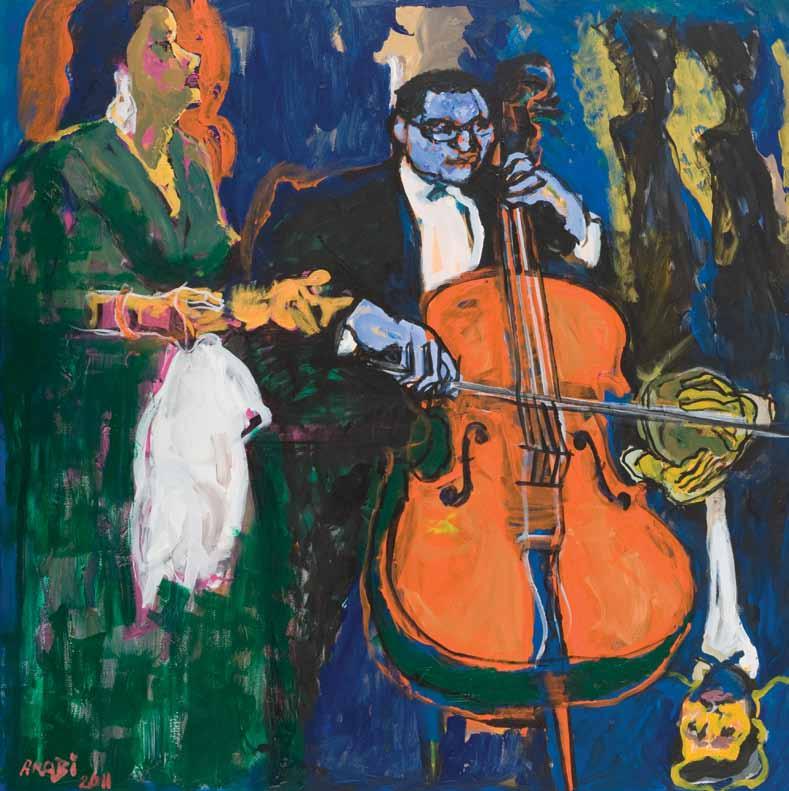
77 Upside Down Tambour 150 X 150
Acrylic on
2011
cm.
Canvas
du monde », il a continué à la considérer comme un symbole spirituel. Il a essayé de rassembler un choix de cultures de chorégraphies mystiques du monde entier de Vivaldi à la Grèce ancienne, à l’Amérique Latine et à Um Kulthûm, réalisant une chorégraphie à partir de la chanson « Tâ’iban tajrî dumû‘î nadaman » (Je me suis repenti et de mes larmes sourd le regret), qui à mon avis fait partie du répertoire de Râbi‘a al-‘Adawiyya qui fut mis en musique par al-Sunbâtî, et qui fut représenté dans plusieurs théâtres, en particulier à Paris, et enregistré en DVD dans les vidéothèques. Il a été à ce point demandé qu’il est épuisé ou difficile à trouver. Je dirai encore que je ne suis pas le seul à faire revivre dans ma peinture la mémoire de celle qui fut une telle exception et dans la nostalgie et le respect de laquelle me rejoignent des millions de personnes. Toutefois, sur le plan plastique, je suis peut-être le plus proche de son angoisse métaphysique oscillant entre le spirituel et le religieux. Je lui ressemble dans son zèle à sortir des éminences du charme du passé et glorifier les maîtres ensevelis dans les mausolées, les qardâ‘a et les khânqâh (couvents). Elle est semblable à Najîb Mahfûz, Zakariyyâ Tâmir, Jamâl al-Ghîtânî, al-Sa‘danî, Idrîs, Saïd al-‘Adawî et al-Jazzâr, et ses épanchements passionnels leurs sont destinés, à eux et à une certaine élite, ainsi qu’à ceux qui leur ressemblent par le niveau de leur appétence spirituelle. Ils constituent son vaste public, vivant seulement au jour le jour, et dont elle est la nourriture spirituelle. Nous comprenons alors pourquoi toutes les couches sociales se retrouvent autour de son art.
Le jumelage de ma peinture avec la musique et le style d’Um Kulthûm dépasse cette nostalgie collective magique. Il se peut que derrière cet engagement il y ait un parallélisme harmonieux et un désir de fusion entre la perspicacité et le samaï (du domaine de l’intuition) selon les définitions d’alGhazâlî pour la perspicacité et d’al-Suhrawardî pour le samaï. Ceci tout comme Paul Klee et Kupka qui professent que la dimension spirituelle de la toile provient de sa fusion avec la musique ou, en d’autres termes, qu’elle émane du sens associé à l’ouïe et à la vue, c’est-à-dire du cœur.
Ceci va même jusqu’à dépasser l’incandescence d’artistes mondiaux du niveau de Béla Bartók et de Maurice Béjart par l’ardeur de son répertoire enflammé « Wa lastu bi-l-musaddiq fika qawlan » (Je ne crois pas ce qu’on me dit de toi). Ceci m’a même amené à consacrer neuf ans de travail incessant comme chercheur à la Sorbonne (section de l’esthétique et de l’art), hanté que j’étais par cet accord fusionnel. La thèse de mon doctorat d’état était intitulée : « Le rapport entre la musique et la peinture dans l’art islamique. » J’ai été obligé, pour que cette recherche aboutisse, de consacrer une année entière de travail à étudier la musique spirituelle arabo-musulmane et ses caractéristiques mélodiques comparées aux systèmes de création spirituelle des miniatures des manuscrits et des fleurages et dessins des tapis et kilims.
En 1957 (j’étais dans le secondaire), j’ai passé une année scolaire au conservatoire de musique de
Damas. Je me rappelle m’être appliqué à jouer « ‘Awwidti ‘aynî » (J’ai habitué mes yeux), et ce fut le début de l’influence magique d’al-Sunbâtî et d’Um Kulthûm. Depuis ce temps là, j’ai été convaincu que si je n’étais pas peintre j’aurais été musicien. A la suite de cela, ma collection de morceaux musicaux rares, y compris ceux d’Um Kulthûm, s’est amplifiée, et le samâ’ est devenu une partie fondamentale de mon activité musicale quotidienne, en concurrence avec la lecture et la visite des expositions. Quant aux recherches intenses pour lesquelles j’ai fait beaucoup d’efforts afin qu’elles soient publiées en langue française et en langue arabe, elles révélaient l’intensité de ce lien et le peu de temps qui me restait pour la peinture.
Depuis environ deux ans, je me retrouvais par hasard chaque jour, comme d’habitude, à écouter Um Kulthûm sur une des chaînes satellitaires, tout en dessinant à l’encre dans la douceur et la sérénité, mais avec un brin d’absurdité. Je dessinais surtout les musiciens qui formaient l’orchestre de la « Dame », à commencer par le ‘ûd d’al-Qasabjî et le violoncelle principal. Les lacunes de détail, je les ai reportées jusqu’à ce que je fasse mon exposition au Caire et que je puisse les corriger sur place : le joueur de nây accroché à son cylindre d’air, ignorant la pesanteur terrestre, et les lignes de sièges perpendiculaires, puis le joueur de violon, et la tête du joueur de qânûn plus que son instrument. J’ai mis peu de temps à comprendre que je tournais autour de ma proie plastique Um Kulthûm, attiré par la magnificence de sa danse qui illuminait l’espace de sa luxuriance. Même si je n’aimais pas également toutes ses chansons, j’ai pourtant ordonné mes goûts sans parti pris en privilégiant tout ce qui avait été composé par al-Sunbâtî, puis en second lieu, Zakariyyâ Ahmad et en dernier al-Qasabjî. Je ne supporte aucun des autres, je le dis sincèrement, car le style d’al-Sunbâtî (le mouvement de la passion) est plus proche de ma peinture intime. Il me fallait transporter le monde d’Um Kulthûm de l’ivresse de la belle époque, sereine et équilibrée spirituellement (y compris l’ardeur de sa sensibilité nationale et patriotique) jusqu’au monde de la modernité provocante, agressive, absurde, et portant les stigmates et les échos des échecs de la mondialisation. Puis il me fallait faire passer dans la toile la mémoire et le registre de l’émotion vers l’obsession parallèle de mon inspiration interprétative, plongé que j’étais dans le son de la couleur et de la ligne. Ce que je viens d’exposer n’est nullement une divagation musicale parce que ma toile souffre des mêmes problèmes et des mêmes ambiguïtés et du même conflit autour de la question : « de quelle Um Kulthûm s’agit-il ? », elle dont la musique et le chant habitent mon âme.
Asaad Arabi, Paris 2011
80
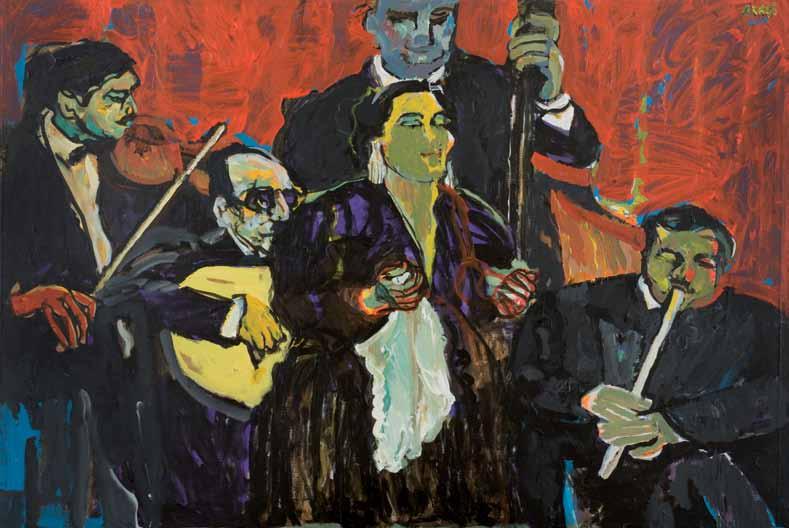
81 Passion 130 X 195
2010
cm. Acrylic on Canvas
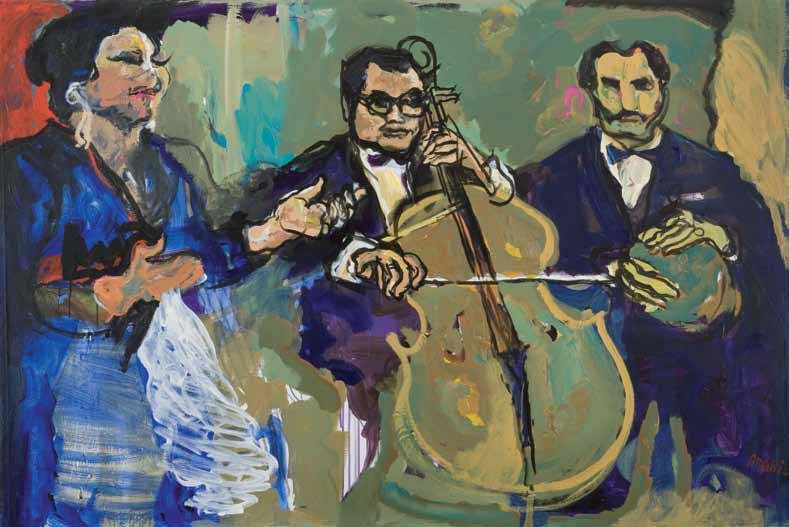
83 Wa La Ana Bilmusaddiqi Fika Qawlan (And I Don›t Believe All What They Say About You) 130 X 195 cm. Acrylic on Canvas 2010
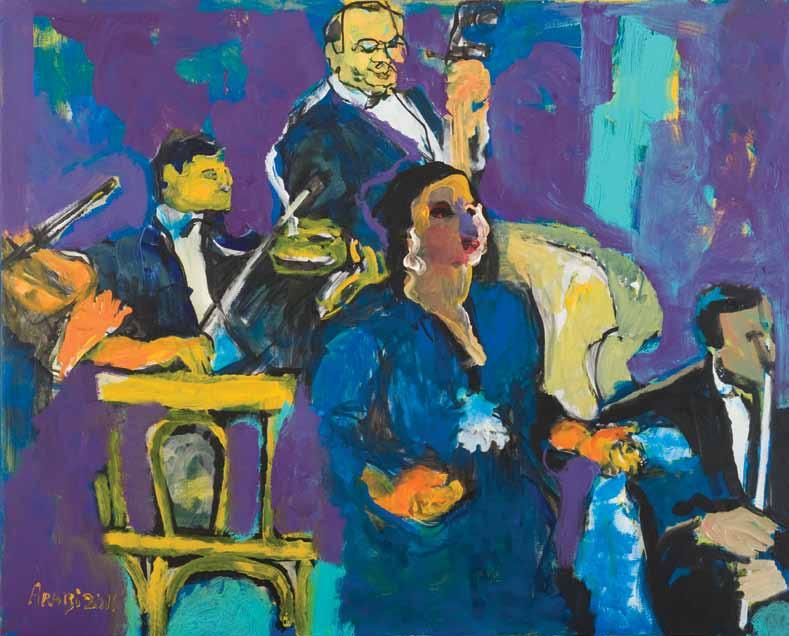
85
Playing on the Bamboo Chair 30 X 162 cm. Acrylic on Canvas 2011

87
The Green Flute 121 X 150 cm. Acrylic on Canvas 2011
س�يروم« وهو ةبيرق تاونس� ذنم فيوت رس�اعم س�قار بركأا ىلع يرثأاتلا في موثلك مأا ةطلس� ةبس�انلما هذه في انتوفي نأا بجي لا نم يرثك« روكذلما ةيولولما بحاس� لوقل نعذأا دق يس�نرفلا راجيب ناكو ،يمورلا نيدلا للاج انلاوم ةبمح امهتعمج .»راجيب .»ىقيس�ولماو س�قرلا قيرط تترخا دقف انأا امأا قلحا لىإا دوقت قرطلا ةقلاع ىلع ناكو )ةيفوس�لا ةس�اخ( س�قرلا في ةيناحورلا لىإا روهس�م يلماع هيلاب س�قار حبس�أا نأا دعب راجيب لوتح اذكهو اناكو .س�يراب تايفامو تايبول ميحج نم ابره ارس�يوس� /نازول في هتقرف عم رقتس�ا نأا دعب ةس�اخ موثلك مأا عم قس�عو نابوذ تويرب في اهنم مس�ق عنم ،تلاس�و ثلاثب لىوألاا ةيلماعلا ةس�قارلا همجارب في تاحاس�لما بحرأا اهل س�رك ،ةيس�خس� ةفرعم ىلع ةيهقفلا تاعونممللو اذه هلمعلو هل ىدهم تويرب في قباس�لا يس�رعم ناك كلذل .ردس�لا ةارع اوناك روكذلا ينس�قارلا نألا في كرحتي ،ةيس�رألاا ةلاقثلا نم يرس�بلا دس�لجاو لس�افلما ريرتح في هتقيرط ترمثتس�ا »دس�لجا ةعنقأا« س�رعلما اذه في .هيف .ةآارم وأا – رادج – ةقرو غارفلا رابتعاب يس�رف حطس�م ىلع ةيبذاج نود غارفلا عمجي نأا لواحي ،»لماعلا لوح اموي نونامث« ناونعب ناكو ،هتافو لبق ،يرخألاا هلمع في ايحور ازمر اهرابتعا ىلع رمتس�او ازجنم موثلك مأا لىإا ةينيتلالا اكيرمأا لىإا ةيمدقلا نانويلا لىإا يدلافيف نم لماعلا نم ةيحورلا س�قرلا تافاقث نم ةقاب ينحلت نم »ةيودعلا ةعبار« نياغأا ةعوممج نمس� اهنأاب نظأا »امدن يعومد يرتج ابئات« ةينغألا ةلاس�ألاا غلاب »فيارغيروك« ردان وأا ذفان هنكلو ةماعلا ةيقيس�ولما تابتكلما في DVD ىلع ةلجس�مو س�يراب في ةس�اخ حرس�م نم ثركأا في تس�رع ،يطابنس�لا .هيلع بلطلا ةدس�ل ينكلو ،ينيلالما عم ريدقتلاو يننلحا اذه ينعمجي »هتحولب« ءانثتس�لاا اذه ىركذ ييحي يذلا ديحولا تس�ل نيأاب ديدج نم لوقأا نم جورلخا نم هتس�امح يواس�ي ابمو نيافرعلاو يقوذلا ثورولما ينب يفيلوتلا يخزبرلا اهس�جاه نم ايليكس�ت مهبرقأا نوكأا دق رمات ايركزو ظوفمح بينج لثم يهف ،تاهاقنالخاو تاعادرقلاو تارازلما تتح ينعباقلا ينملعلما ديجتمو يس�الما رحس� ممق ىلع مهلاثمأاو ةيبس�ن ةبخن لىإاو ءلاؤوه لىإا ةيقوس�لا اهاونج هجتت ،رازلجاو يودعلا ديعس�و س�يردإاو نيدعس�لاو نياطيغلا لامجو انهو ،يحورلا هءاذغ موثلك مأا لاثمأا لثيمو هموي فافك هبس�ي ام س�يعي يذلا س�يرعلا اهروهمج مهف ،ةيحورلا ةقئاذلا ىوتس�م .اهنف لوح فافتللاا ىلع تاقبطلا ىتس� قفاوت ببس� كردن رظانتلا زايحنلاا اذه فلخ نوكي دق ،روحس�لما يعاملجا يننلحا اذه موثلك مأا جهنمو ىقيس�وم عم يتحول ةيمأاوت زواجتت ،نياثلل يدرورهس�لاو لوألال ليازغلا فيرعت قفو )يقوذلا( يعامس�لاو )يقوذلا( ييرس�بلا ينب حس�اترلا ةوبس�و يفيلوتلا نع اهرودس�ب رخآا ىنعبم وأا ،ىقيس�ولما عم اهحس�ارت نم دفي ةحوللا في يحورلا دعبلا نأا في ،اكبوكو يلك لوب نأاس� نيأاس� .)س�دلحا( بلقلا وهو رس�بلاو عمس�لل ةكيرس�لا ةس�الحا كيف قدس�لماب تس�لو« اقوس� قرحتلما اهثوروبم راجيب س�يرومو كوتراب لايب ىوتس�بم ينيلماع يننانف راهس�نا ىتح زواجتت اهنإا س�ووهم )نفلاو لاملجا ملع مس�ق( نوبروس�لا ةعماج في ثحابك بوؤودلا لمعلا في تاونس� عس�ت س�يركت لىإا لس�تل ،»لاوق ىتح تررطس�او ،»يملاس�إلاا نفلا في ريوس�تلاو ىقيس�ولما ينب ةقلاعلا« :ةلودلا هاروتكد ةحورطأا تناكو ،فيلوتلا اذهب ةيملاس�إلاا ةيبرعلا ةيحورلا ىقيس�ولما ةس�اردل لاماك ايس�ارد اماع س�س�خأا نأا هب جرخ يذلا نقتلما يثحبلا س�وبللاب جرخي .ملكلاو ديجاجس�لا زرط س�قر لىإا تاطوطمخ موس�ر نم ةيقوذلا تاعانس�لا مظنب اهتنراقمو ةينحللا اهس�ئاس�خو تدوع« فزعب يتيانع ركذأا ،قس�مد في ىقيس�وملل لياعلا دهعلما في ايس�ارد اماع تيس�ق )ةيوناثلا ةلحرلما في( 1957 ماع تنك تلس�وو ،ايقيس�وم تنكل اماس�ر نكأا لم ول نيأاب ينلحا كلذ ذنم ينقي ينكلم ،يموثلكلا يطابنس�لا رحس�لا يرثأات ةيادب ،»ينيع يقوذلا يطاس�ن نم ايس�اس�أا اءزج عامس�لا حبس�أاو ،موثلك مأا س�خي ام اهيف ابم ةردانلا ةيقيس�ولما يتبتكم تمخس�ت نأا يتعباتم ةفاثك فس�كت ةيبرعلاو ةيس�نرفلا ينتغللاب اهرس�نل تدهج يتلا ةفيثكلا تاس�اردلا امأا ،س�راعلما ةرايزو ةعلاطلما س�فاني يمويلا .ةحولل يغرفت تاقوألا س�فانلما دهلجاو طابترلاا اذه برلحاب مس�رأا ،ايموي تايئاس�فلا ىدحإا ىلع موثلك مأا لىإا عمتس�أا يتداعك انأاو ،نيدجأا نأا ينتنس� نم برقي ام ذنم فداس� وليس�تلاو يجبس�قلا دوع نم ءادتبا »تس�لا« خانم نولكس�ي نيذللا ينيقيس�ولما س�خألااب لوانتأا ،ثبعلا نم ولخت لا ةنيكس�و ةعدب يانلا فزاع مث ،برق نعو ايناديم اهطبس�ألا ةرهاقلا في يس�رعم ميقأا ىتح اهتكرت تانهلاو س�قاونلا هذه لثم .يس�يئرلا ثركأا يجنناقلا س�أارو يتاجنمكلا كانه مث ،ةدماعتلما يس�اركلا طوطخو ةيس�رألاا ةيبذالجا س�كعب حيرلا بوبنأا عم محتللما ،ةبوس�لخا غلابلا غارفلا في اهس�قر ىنغب موثلك مأا ةيليكس�تلا يتس�يرف لوح فلأا نيأا تكردأا ىتح نمزلا لطي لمو .هتلآا نم دمحأا ايركز هيلي يطابنس�لا هنلح ام لك س�يدقتب بس�عت نود يتقئاذ تمس�ح دقف اهيناغأا هاتجا يواس�تلما يرغ يس�امح مغرو يريوس�ت لىإا برقأا )دجولا ةيلآا( يطابنس�لا جهنمف ،ةقفانم نودب اذكه ،مهادع ام لمتحأا لاو ،ام ةجردب يجبس�قلا مث س�بنلا ةوذج نم هيف ابم( ايحور نزاوتلماو لماس�لما ليملجا رس�علا ةنطلس� نم موثلك مأا لماع لقنأا نأا يلع ناك .يلخادلا نم ةحوللا في لوحتلا مث ،ةيلموعلا مئازهلا ءادس�أا تافلمخو ثبعلاو زازفتس�لااو س�يرحتلا ةثادح لىإا )يموقلاو ينطولا ادارطتس�ا هتس�رع ام س�يلو .طلخاو نوللا توس�ب س�مغم يليوأات يماهلتس�ا يزاوم ذاوحتس�ا لىإا ةيفطاعلا ةقيثولاو ةركاذلا اهانغمو اهاقيس�وم ةنكاس�لا »موثلك مأا يأا« لوح عارس�لا س�فن نمو تايلاكس�إلااو لكاس�لما س�فن نم نياعت يتحول نألا ايقيس�وم ؟يحور في

اهبكرم دس�ت اناقيس�وم نأا ودبيو .مويلا ةيلماعلا ةلموعلا قاوس�أا في اهفداس�ن يتلا »ابماس�لا« تاعاقيإا عم ةفيهرلا تاماقلما طلخ يرس�م ،يرس�لما س�فن في يوثادلحا ،ثيدحتلا ىوعد تتح اهاوس�و »لوردنأا كورلا»و »بارلا»و »س�لافلا»و »ويرلوبلا»و لاثم ىري س�عبلا .خس�لما س�يلو ريوطتلا لجأا نم ايرورس� هلوح لدلجا نأا مغر اذه س�قون .ةعبس� وأا رس�ع ىدحإا لىإا رس�ع ةعبس�لا تاماقلما لازتخا ناكمإلااب هنأا 1932 ماع ةرهاقلا في يرخألاا ةيبرعلا ىقيس�ولما رتمؤوم في ةيمهألاا غلابلا عوس�ولما .داؤوف كللما دهع في :ءدب ىلع دوع -5 زربأا( »يرمراف»و موثلك مأاو يجبس�قلا دممح نم لك يلماعلا رتمؤولما اذه في كراس� يلماع راقيس�وم مظعأا »كوتراب لايب« ةس�اخو )ةيبرعلا ىقيس�ولما في س�تمخ راز دقف لوألاا امأا .تس�بادوب في تانيعبرألاا في فيوتلماو ،لس�ألاا يراغنه ،رس�اعم امدنعو ،اهنع هعامس�أا راثأا ام ببس�ل برق نع ةيقيس�ولما اهتكرح ىلع فرعتيل بلح توس� ادع ام لكل ممس�لاب باس�م نيألا« :باجأا موثلك مألا لاإا نحلي لا اذالم لئس� كوتراب لايبو ةهج نم موثلك مأاو هفرط نم ىرج يذلا راولحا نأا ودبيو .»موثلك مأا ىقيس�ولما قايس� ىلع رثألاا غلاب هل ناك ىرخأا ةهج نم )عامتس�لاا مس�ق س�يئر( ام وه .)ونايبلا ةس�اخ( كوتراب ىقيس�وم نم ئدتبت يتلا يه ،ةرس�اعلما ةيلماعلا ايروس� لامس�و لوس�انألاا/ايكرت( طس�وألاا قرس�لا نم نالحألاا فلاآا عمجي نألا هداق انه عقن .ةينامثعلا ىقيس�ولماب رثأاتلما يراغنهلا هفيس�رأا لىإا اهفيس�يل )ناقلبلاو )اهنم ةيبعس�لا( ةيقفألاا ىقيس�ولما ثوروم ينب ةثادلحاو ديقعتلا غلاب فيلوت ىلع نم ايرثأات دس�أا كوتراب براتج برتعت .)اهنم ةيوبخنلا( ةينومراهلفلا ىقيس�ولماو ةيمرهلا ةيقفألاا ىقيس�ولما ماظن لىإا ةدوعلاب كلذو ،يكس�نفاترس�ا يس�ورلا هرس�اعم فيلأاتلا هبراتج رهس�أا نم .ةيكيس�لاكلا ىقيس�ولما في ةيديلقتلا مظاونلا ىتس� قرخو مكبرخأا لمأا .ةيعاقيإلاا هس�ئاس�خ دكؤوي ام وه ،طقف عاقيإلاا عم جودزم ونايب ىلع ؟يرثأاتلاو رثأاتلا ىلع ةردقلا ينعت تناك ةس�هنلا نأا نم س�ماه كانه تلاالحا ىتس� في .لاثم ةلزعنم فزعتف )قزبلا( ةزولجا امأا ،ةكبردلا وأا فدلا مهبحاس�ي نوناقلا وأا دوعلا وأا لىإا راس�يلا نم ئدتبي لوحتم هنألا هطيونت نكيم لا يذلا بنالجا وه ،راركتلا لبقي لا يذلا يحورلا خانلماو ةنطلس�لاو ةرس�لحا امومع يوس�هنلا وأا يموثلكلا تختلا في .يلجتلاو فس�كلا في ةجردتلما ميس�اقتلاب هبس�أا هتيادب نألا ماتخ نود س�كعلاب وأا ينميلا .تاطوطخلما موس�ر لثم نيدعبلا ىقيس�وم اهنأا لاقيو ،وليس�تلاو نامكلا لثم تختلا عم ةلحاس�تلما تايرتولا س�عب تفيس�أا تاوس�ألاا ددعتلما ةس�ينكلا غروأاب طبترلما خاب ناويد نم ادتبا اهس�اس�أا نألا ،داعبألاا يثلاثلا س�كاعلما فرطلا في ةيبرغلا ىقيس�ولما عقت ،نيومراهليفلا وأا ناوبترنوكلاب ىعدي ام وهو تلاآلاا ينب مأا ةدحاولا ةلآلاا في ءاوس� نمازتلما راولحا ىلع ةدمتعم ،)نيوفيلوب( خفنلا تلاآا ينب ام راودألاا هيف تلاآلاا عزوتت يطارقيمد هبس� لياترس�كروأا راوح نمس� ةنمازتم رطس�أا ةدع ىلع طونت يهف كلذل ةرس�اعلما ىقيس�ولماو يكس�نفاترس�ا عم تلوتحو ،فزاع فلأا لىإا رلام ىدل اهددع لس�و ،تايرتولاو عاقيإلاا تلاآاو تايس�احنلاو لباقيو .اهاوس�و ةيتوس� تاحاس�م لىإا عرق لىإا يننط نم ةنمازتلما ةيتوس�لا تامالخاو حوطس�لا جيس�ن ينب ةيبيعكت ةقلاع ليإا ةعرس�لا يريغت رارغ ىلع اترس�كروألاا داوق تلايوأات ينب فلاتخلاا )يس�دلحا وأا يبلقلا يماهلإلاا بنالجا( لوألاا فرطلا تارس�ح :يس�لدنألاا لوقلا لىوألاا ىلع قبطني .هيرغو )يديجاترلا( ييربعتلا هرتوت لىإا ينحللا يربعتلا ةدح نم اهاوس�و )Le tempo( ،ةئيطبلا عم ةعيرس�لا اهيف بوانتت تاكرح ثلاث لىإا ةمس�قم ةيمره ةيناثلا ودبتو »ناذئتس�ا نود ناذآلاا لخدت ناس�لحا ىقيس�ولما« عم اهراوحو ةدحاو ةلآا ةرطيس� ىلع دمتعي وترس�نوكلا ماظنف ديلاقتلا في قلاطإلاا ينعي لا وهو ينفرطلل طس�بلما لودلجا وه )يس�لدنألاا( يبرغلما داس�نإلاا ىقيس�وم في ةقرفلا ددمتت ام ايرثكو ،نامث وأا تلاآا عبرأا ىلع رس�تقت ةرجلحا ىقيس�ومو اترس�كروألاا اولوحتيو ينفزاعلاب نيرس�الحا ليلهت طلتخي اهاوس�و ةيرداقلا وأا ةيلذاس�لا ةرس�لحا تلااح فيو ،افزاع ينعبرأا وأا ينثلاث ىتح لس�تف ةيوبخنلا ىقيس�ولما ينب قيرفتلا نم دب لا انهو .جيللخا لود في ةراحبلل يعاملجا قيفس�تلا لباقت ،ةدحاو ةيس�قر ةيداس�نإا ةلتك لىإا . يموثلكلا تختلاو موثلك مأا انعوس�وم نأا ابم لوألاا عونلا ءازإاب نحنو ،ةيبعس�لا ىقيس�ولماو ةدحاولا ةيقيس�ولما ةملاعلا في لوحتلا ةفاهر ةبوس�خ ىلع دمتعت يتلاو داعبألاا ةيئانثلا ةطونلا ينب ةجيتنلاب طللخا نكيم لا ةراهم بس�ح نمثلا ىتح بايرز دهع في تلس�و اهنكلو ،ةملاع عبرلا تلاآاب ىعدت اذل ملس�لا في ةملاعلا فس�ن نم ثركأا لىإا رمألاا كلذك )لوميبلا وأا زييدلا( اهفس�ن وأا ةملاعلا فزعتل س�اس�ألاا في ةممس�م ونايبلا ةلآا نإاف س�كعلابو .لاثم دوعلا فزاع ديلاقتلا نكل ،موينومراهلا ىلع فزعلا في هدلاوو ناخ ىلع تحاف ترس�ن اهنم ىناع يتلا ةلكس�لما يهو نويدروكوألاا لىإا ةبس�نلاب ةلآاف رمأا نم نكي امهمو .ةس�وعم ةينلح ةلآا ةيئانثلا عاقيإلاا ةلآا نم لعتج )ناتس�كابلا اهيلإا يمتنت يتلا( ةيدنهلا ةيقيس�ولما »اغارلا« ىقيس�وم لامج في لقألاا ىلع ،يحورلا خانلما ىلع ةنميهلما اهتيزكرم في روطنس�لا وأا نوناقلا وأا دوعلا لباقت راتيس�لا ةيرخس�لل ةيرثلما ةيكلاهتس�لاا ملافألاا لىإا ىدأا ةيبرغلاو ةيدنهلا ىقيس�ولما ينب طللخاو .اكس�ونأا هتنباو راكناس� اهب س�تخا يتلا
لوؤوس�لما وه نم يردن لاو .ينثدحلما نم هاوس� عم نواعتت تأادب دق لاس�أا تناك مث 1964 ماع »يرمع تنأا« ينغت نأا لبقت نأا لبق ىلع مهتس�رف موثلك مأا نأاب لاقي ام ،يطابنس�لا نياغأاب اس�يأا نوكراس�ي ءلاؤوه س�عب اندجو اننألا يموثلكلا تختلا ينجهت نع نيالحأا يمثلكت نأا نيديرت له :ةعاذإلاا في ةرم تاذ اههجو في خرس�ي ،هنيبو اهنيب ليبن فلاخ لىإا ىدأا امم يقيس�ولما عيزوتلا داس�نإلاا« ينب ةرس�لا لبح عطق هنأاب تانيعبرألاا ذنم حرس�ي ناك باهولا دبع نأا ديكأا وه ام نكلو ةياورلا نم اديكأا تس�ل ؟ اس�يأا ام لمأاتن ايلمع انوعد .ةليس�ألاا ةيس�يس�أاتلا هتيقادس�م نم مغرلاب ،ناك ام وهو ،لهس�لا بيرغتلل ةحيرس� ةوعد يهو »ءاس�نإلااو دبع هنلح ام حنجا نأاو ةس�اخ يبس�نلا قرفلا فاس�تكا بعس�لا نم س�يل ،موثلك مألا يطابنس�لا جراخ هاوس�و باهولا دبع نلح دجولا لىإا جردتلما لوس�ولا ةيلآا نأا ادع ام ،يطابنس�لل نوكت داكت اهتايح رخاوأا في »كاقلأا ادغأا« ةينغأا يهو موثلك مألا باهولا س�دنهم تانيتس�لا ذنم مس�ح دقل .هقح يطابنس�لا يطعن ىتح طيرفتو ةيوس�ت ةيأاب ثاتركلاا مدع بجاولا نم هلعل ،ةبولقم ةيعيبطلا ةئيبلل يعو نود ايفرح ةلوقنلما ةيبرغلا ةرامعلا ادقتنم ينجهتلاو ثيدحتلا ينب طللخا اذه يحتف نس�ح لوألاا برعلا .)»بعس�لا عم ةرامعلا« هباتك في( »رس�ع عبارلا س�يول بايث في لفري نيادوس�ب« :نوكت ام هبس�أا اهنأاب اهايإا اهبس�م س�قطلاو ،يداحألاا يلموعلا فياقثلا حايتجلاا وأا ديلقتلا قيرط نع س�يلو نزاوتلما يراس�لحا لدابتلا قيرط نع لاإا ةس�هنلا متت نأا نكيم لا لاجلما س�فن في نيرس�حي .لدابتلما فراعتلاو ةقئاذلا لدابتب لاإا ةديعبلا فيدلالما رزج وأا اكس�لاألاا نونفب لس�تن نأا نكيم لاف موينومراهلا ةلآا اوس�رف ناتس�كابلا اورمعتس�ا امدنع زيلكنألاا نأا ةيرتولا اهلاس�نأا راس�تنا لدابتو ةيقيس�ولما تلاآلاا لدابت لوح نولاوقلا اهمس�هي نأا لبق دوقع ةبرغ نم ةلآلاا هذه تناع .)دوعقلا ةلاح في س�رألاا ىلع هب فزعي نويدروكوألاا نم عون( برتعت ،ةيناتس�كاب ةلآا )مكاترلما اهليدعت دعب( مايألاا عم تحبس�أاو اترلكنإا اهتس�نف ،مهيدل يعامس�لا ديلاقت لىإا برعتو ةفوس�تلما انايحأا )راتيس�لاو( عاقيإلاا لخدي نأا لبق يس�يئرلا نحللا فزع ىلع رس�تقت يهف ناخ يلع تحاف ترس�ن ةقرف في مويلا س�اس�ألاا ىلع دمتعت ىطس�ولا ايس�آا ىقيس�وم نأاب املع ينيحورلا ينفزاعلا رهمأا نم مويلا فيوس�لا ينغلما اذه برتعيو ،اهتبحاس�م في لاثم( ينيبرعلا داس�نإلااو ىقيس�ولما في وه امك عاقيإلاا ةدحو ىلع س�يلو لاعفنلاا في ةدايز ةعرس�لا لدبتلما ماقم س�يس�لا ماظن ىلع دمتعت ةيوس�هن ىرحألااب وأا ةيلومس� ةلآا لىإا ةيرامعتس�ا ةلآا نم موينومراهلا ةلآا تلوتح اذكهو .)ةيونيدلاو ةينيدلا حيس�اوتلا .ةيفاقثلا س�ئاس�لخا نع يلختلا نود رخآلاا ىلع حاتفنلاا ينجهتلا نم ديدجتلا دودح كردن ىتح ةيبرغلا ىقيس�ولما س�ئاس�خ عم اهفلاتخاو ةيبرعلا ىقيس�ولما س�ئاس�خ عجارن نأا انيلع في يس�دلحا يعادتلاو يبلقلا راس�لما ىلع دمتعت اهنألا ةيقفألاا وأا ةينحللاب ىعدت ةيبرعلا ىقيس�ولما نأا فورعلما نم ،)بيرغتلا( تابحاس�لما نع لزعبم طونتو دحاو رطس� ىلع بتكت ،يعاملجا مأا هنم يداحألاا ءاوس� ءانغلا عم محتللما وه ،اهفيلأات قايس� يانلا اهيف زكرمتي دق ،تددعت امهم تلاآلاا عاونأا في دهزلا ىلع نادمتعي فيوس�لا يعامس�لا وأا يقرس�لا تختلاف كلذل ،ةيعاقيإلاا ذنم تأادب ةس�هنلا هذه نأا فورعلما نم .ديعس� دوممحو دايع بغار لثم داور ينليليكس�ت بناج لىإا ،لامج ةيماس�و اكويراكل عويس� اهلات ،1900 لبق لوبناتس�إا نم هلقنو فارغونوفلل ليوملحا هدبعو نامثع دممح فاس�تكا عم رس�ع عس�اتلا نرقلا ةياهن يس�ع كارأا« ةينغأاو يزاجلحا ةملاس�ل ةيفوس�لا راكذألاا ينغت نامزلا نم دقع دعب موثلك مأا تأادتبا .1903 ذنم ةناوطس�ألاا ةروث دعب ةس�اخ ةينطولا اهيناغأاب خس�رت يموقلاو ينطولا اهدعب نكلو .)دممح لاعلا وبأا قيرط نع( ليوملحا هدبعل »عمدلا ةعاذإا لىإا يروهملجا دهعلا في تلوتحو 1932 ذنم يكللما دهعلا في كلذ لبق تس�س�ا ةعاذإلااف ،رس�انلا دبع ةترف للاخو 1952 . »برعلا توس�« يه عويس�لا ةعس�او ،»نادوس�لاو س�نوت« لثم ةيبرعلا نادلبلا نم ديدعلا في اهلفامح ةلوجب رس�ن لىإا اهتلوح ،1967 ةيمزه عم ةيموقلا اهتوبس� ترذتج . ءانغ نودب رهس�أا ةثلاث دادلحا تنلعأاف ةركبلما رس�انلا دبع ةافو عم اهنزح فعاس�تو .ايبلموألاا يتلفحب س�يراب في تهتنا ناك يذلا تقولا يفف ،هتاديدتج في ةيوس�هن مهدس�أا نم هرس�ع ينحلم ىلع يحورلا هقوفت ىلع ناكف يطابنس�لا اهمأاوت امأا طيونت لاو ،ىحس�فلا ةيبرعلا ةغللا ينحلت بحي لا يجبس�قلا ناك ،هروحبو نيرطس�لا وذ ىفقلما رعس�لا نازوأا نم هنالحأا مهلتس�ي ةقوطقطلا نم لعجي نأا لواح امدنع )هنس� رغس� ىلع( تانيس�ملخا ذنم يطابنس�لا ةداير زبرت .)ماعلا اهءانب لاإا( هنالحأا .هنع لايدبو ايئانغ ارود ةيبرغلا اهتيرظنو )ءانغلا ىلع ةدمتعلما( ةيقرس�لا ىقيس�وملل ةينحللا ةيقفألاا ةرامعلا ينب قلطلما قلاطلا س�فري ناك امك ةعاذإلاا امهتلجس� ينتنثا ادع ام اهعيمج تعاس�( ءانغ نودب ةفوزعم 38 نلح امدنع كلذو )اترس�كروألاا ىلع ةدمتعلما( )يمار دمحأاو يجبس�قلا دممح( »ةدياع« اربوأا رود اهلوبق ليلدب ةيبرغلا ىقيس�ولما مترتح تناك موثلك مأا نأا مغرو )ةيرس�لما بتح نكت لم لوقأا ،يويدلخا مامأا س�يوس�لا ةانق حاتتفا موي تفزع يتلاو يديرف لياطيإلاا راقيس�وملل »ةدئاع« اربوأا لاونم ىلع .»دجولا لىإا لس�ت لا اهنكلو ةميظع ةيبرغلا ىقيس�ولما« :نأاب ةبس�انم نم ثركأا في اهديكأات ليلدب ديلقتلا ةيقرس�لا ةيقيس�ولما ةقئاذلا نع توس�لاو عبطلا ةبيرغ تلاآا يموثلكلا تختلا فيزاع ةقرف لىإا تبرس�ت هنأاب فاترعلااب انيلع عفري( تايرتولا ةيقبو دوعلا ةفاهر ىلع س�وس� امم نوفس�كاس�لاو يئابرهكلا راتيغلا – نويدروكوألاا – كيتركلإلاا ونايبلا مهو س�ابترنوكلا تاقتس�م نأاس� كلذكو يمورلا نامكلاب س�اس�ألاا في ىمس�ي كلذل ةيقرس�لا ةطونلا عم مغانتي ىتح ةجرد نامكلا ،هتيرقبع مغر ،ىس�خت تناك اهنألاف باهولا دبع نالحأا ينغت نأا تاينيثلاثلا ذنم س�فرت موثلك مأا تناك اذإاو .)وليس�تلا لثم ابم ،باهولا دبع نمو اهنم بلط رس�انلا دبع ميعزلا نأا فرعن انلكو .ةيتلاآلاا ةثادلحا ةمحز في اهتوس� جز نم جارحإلاا نم ةلماك ةنس� عوس�ولما تفوس� دقف ،س�س�م ىلع موثلك مأا لوبق مغرو ،ةدحاو ةينغأا ولو اعم لامعي نأا ،ةبمح ةلاد نم امهيلع كليم
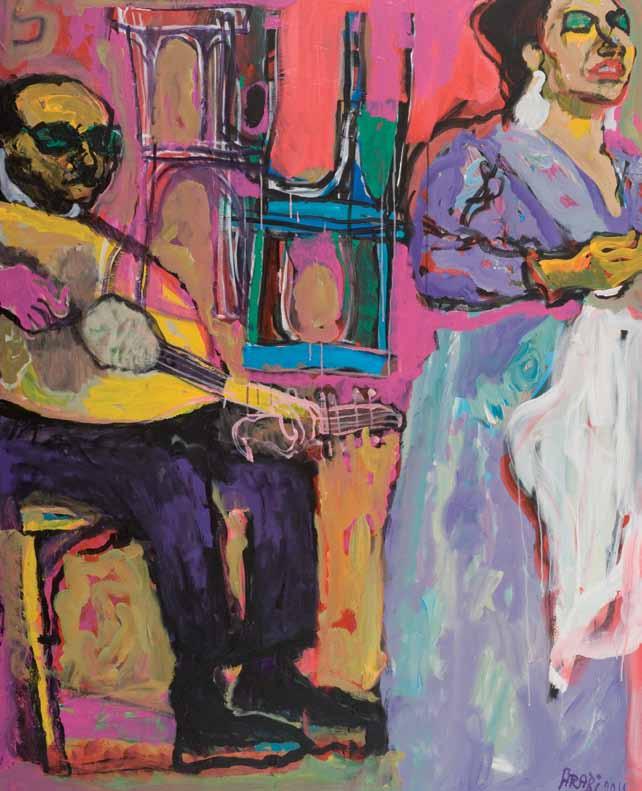
95
Two Chairs for Death 162 X 130 cm. Acrylic on Canvas 2011
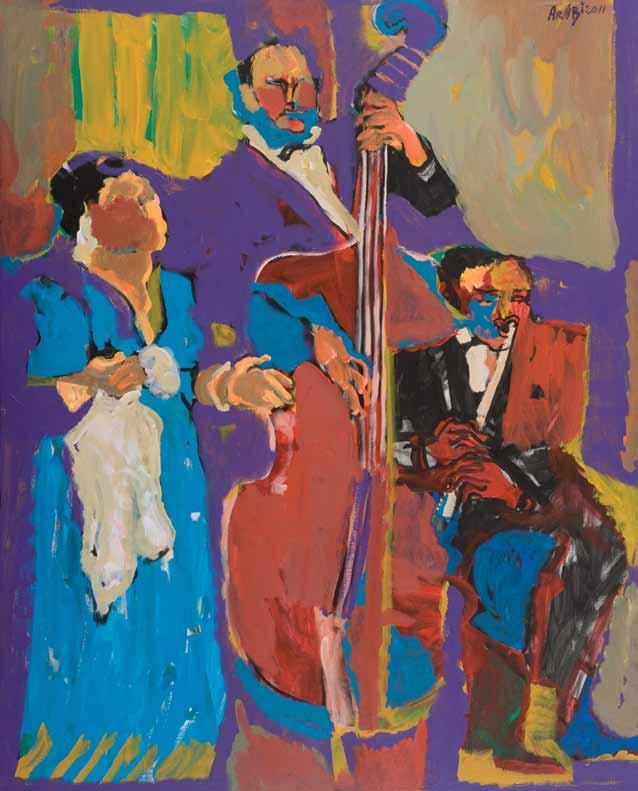
97
Triple Ecstatic 162 X 130 cm. Acrylic on Canvas 2011
.يديرف »ةدئاع« ـب انميت اربوأا تنغ اهنأا لىإا انس�رعت انكو ،ةرحاس� ةيرس�م ةيوثنأا ةماس�تباب ةحلس�م )س�المألاا ةس�اخ( يللحاب ةغللا اهميلعت لىوت يمار دمحأا نأا فيك انركذ ،هتغل ةس�اخ رخآلاا ةفرعم في حماس�تلا وه يوس�هنلا حاتفنلاا تاراس�إا غلبأا لعل ماع اهبحس� تأاجاف ىتح ةيس�نرفلا اهتعلاطم تعباتو )ةدع تاونس� س�يراب في نوبروس�لا ةعماج في هس�فن وه س�رد( ةيس�نرفلا اهيلع در لوغيد لراس� س�يئرلا لىإا ةيس�نرفلاب ةيمس�ر ةيتح فارغلتلاب ةلس�رم س�يراب في ايبلموألاا في اهيتلفح ةماقإا ءانثأا 1967 .»يس�نرفلا بعس�لا س�ملا يذلا يقيس�ولما فيفرلا نم ءزج وه كتوس�ب يبلق ةس�اعترا نإا« :يرهس�لا هفارغلتب دحأا ناك تقولا س�فنبو هنكلو .ةيئانغلا موثلك مأا ةفتح « مايلخا تايعابر« ةيس�رافلا نع هس�فنب مجرت يمار دمحأا نأاب ركذتنل .رعس�لا روحب نم نالحألاا ماهلتس�او ةديس�قلا نفل ةينآارقلا ةحاس�فلاب يطابنس�لا عم همامتهاو ةيبرعلا اهتغل ةيوبخن بابس�أا .»لينلا« نم ءادتبا يقوس� دمحألا نياغأا عس�ت ماقلما اذه في تفرع لىإا س�يوردو نامثعو بولس�لما نم ءادتبا ثيدلحا ينحلتلا يس�س�ؤوم ةبكوك نمس� ايوس�هن ادومع برتعي يطابنس�لا نأا كس� لا لس�فب هنأا لب ،راودألااب لاجرلاو ةقوطقطلاب ءاس�نلا س�س�خت ديلاقتل مهرس�كو يجبس�قلاو دمحأا ايركزو باهولا دبع بناج تاماقم ينب لاوجتلا( ناس�غألاا مث ينحللا بهذلما ىلع دامتعلااب لاولماو حس�ولماو ةديس�قلا نم طيلخ لىإا رودلا لوتح ءلاؤوه .)... خلإا نارنجزلاو قارعلاو هاكراهجو ابس�لاو زاجلحاو اكيس�لاو يتايبلاو تس�رلا ،اهب هديوزت نع ءارعس�لا س�عاقتي امدنع هيناغأا تاملك فلؤوي ناك دمحأا ايركزف نحللاو ةملكلا ينب ةعيطق ةيأا كانه نكي لم .ينحلتلا ةدحوب لخي امم تاماقلما ةيددعتب ةعلوم اهنأاب موثلك مأا مولي ةيقيس�ولما تاماقلماب افراع ناك يمار دمحأا نإاف لباقلمابو كلذ نع تلدع مث )لوس�رلل احدم دئاس�قلا دس�أا( ييرس�وبلل »ةدبرلا« ةديس�ق ينغت نأا ددس�ب تناك موثلك مأا نأا فورعلما نم نم يقوس� دمحأا تايبأا نم ةقاب راتخت نأا تلس�ف ،ةرهاقلا في دلاولماو راكذألااو ةيفوس�لا تاقلح في ةديس�قلا هذه عويس� ببس�ب . ناك اذكهو اهنيحلت يطابنس�لا نم بلطتو »ةدبرلا جهن« ةديس�ق اذإاو ،ةركبلما ةينيدلا اهتيبرت ةوق س�فنبو يمويلا يركفلا اهس�بن نم اءزج تناك اهنألا ةس�هنلا ةديقع لعتفت موثلك مأا نكت لم زربأا دحأا( ميكلحا قيفوت تايحرس�م ىدحإا ةلطب مس�ا نم ةراعتس�م ةينكلا هذهف س�يرعلا اهروهمج نم »ةموث« ىعدت تناك يفقثم طاس�وأا في موثلك مأا ةناكم نأا كيهان )دحاو مقر ةأارلما ودع هنأا مغر( موثلك مأا عم مئاد هؤواقل ناكو )ةس�هنلا زومر لاإا ةدئارلا اهتيوس�هن ةميق ريدقت لياتلاب نكيم لا .هتانب ىدحإا ىلع اهمس�ا ظوفمح بينج قلطأا دقف عراس�ت لا تناك ةس�هنلا ام ينيقيس�ولما نم ،يقوس�و يمارو ينس�ح هطو داقعلا ناك ميكلحا بناج لىإاف ،ءابدألاا نم ءاوس� اهيرس�اعم ةبكوك انلمأات اذإا عدبلما س�قرلا ةحاس�م بناج لىإا ،يرس�قلا دممحو بينم يرام نياحيرلا حرس�لما نمو ،ةيدهلما ةيرنمو ليوملحا هدبع ينب .هبناجب يس�يئرلا نامكلا فزاع وأا نوناقلا فزاع لثم روهملجا ييحيل موقي يدارفنلاا فزعلا بولقم رخآاو ،ةرات موثلك مأا دس�جب اقس�تلم يس�ركلا س�فن تلاالحا نم ديدعلا في تاحوللا نيوكت قناعي هنأا ركذلاب ريدلجا نم لخاد ههجو ىلع هدوع ةلآا ةعس�او هتافو دعب هعقوم ىلع تظفاح يذلا يجبس�قلا يس�رك لىإا ةراس�إا ايلعلا ةيس�قلا ةيوازلا في . يس�ركلا نس�ح هنولو همس�ر حوس�و ىلع للاهلا س�ورب لاثم مس�رأا لم ،ةيزمرلا تاراوس�س�كألاا هذه نم س�عب طقس�ت ةركاذلا نم روس�أا امدنع .يفس�ولا نم ثركأا يحورلا اهخانم مجرتأا نيألا لس�ألاا في : ينجهتلاو ديدجتلا ينب قيرفتلاو يوس�هنلا عورس�لما -4 ةبغرلا فس�كت امهيناغأا فيس�رأا ةعجارم نإاف ةينافرعلا ةيقيس�ولما ةيبترلاب يطابنس�لا – موثلك يئانثلا تبنم قاس�تلا مغر مس�الحا يجولويديإلااو يركفلا قرفلا لىإا هابتنلااب كلذو ،ركذلا تاقلحو يس�يواردلا يداس�نإلاا عباطلا نع يأانلاب ةيدس�قلا للاخ نم اعاطتس�او ،ينيدلا بلاغي )يروهملجا لىإا يكللما دهعلا نم جردتلما( ينطولا س�لحا ذخأاو .ةيلوس�ألااو ةلاس�ألاا ينب ازمر وأا ادومع احبس�يو فيوس�لا ثورولما نع ةيروطتلاو ةقلالخا »قوذلا« موهفم ةيعادبإا ارمثتس�ي نأا كترس�لما امهلمع ةترفلا لهرتو ةينوكس� رابغ س�فنت رس�ع عس�اتلا نرقلا ةياهن ذنم اهتكرح تأادتبا يتلا ةيفاقثلا )ةس�هنلا( ةديقع لىإا فاس�ي نياغألاا نإا لب ،1952 ماع ذنمو يكللما دهعلا ذنم »يمد فيو يرطاخ في يتلا رس�م« لاثم ينغت موثلك مأا ليختنل .ةينامثعلا بلحاو قس�علا في ةيلومس� اميق لمتح »ليمج لك قس�عي بلقلا« :اهركذ رم يتلاك يداس�نإلاا ثورولماب ةلس�لا ةقيثو برتعت يتلا .ةيس�وكنلا ةينافرعلا نم ثركأا يجبس�قلاو دمحأا ايركز ينخيس�لل ةيرهزألاا ةفس�لا نأا ةفدس�لاب س�يلف ،ةيحاتفنلاا ةوبس�لا هذه ةيكولس�لا فقاولما فس�كت يمورلا ةلدبلاو س�وبرطلا ايدترم ةمامعلاو ةبلجا س�ابل ديلاقت اعلاخ »ةيدنفألاا« ةمس� لىإا يطابنس�لا س�اير ىدل تلوتح .هنالحأا ىلع ةعاذإلاا ةقرف بردي ناك امدنع مدعو اهس�ابل روفس�و ةرلحا اهتيس�خس� ةوق نم ءادتبا ،فلختلا رهاظم نم ررحتلا ةلوامح موثلك مأا ةيس�خس� ىلع ارهاظ ناكو ةهباجلما ةجردل )ينمأا مس�اق ثيرو( ررحتلا اذه لىإا وعدت تناك اهنإا لب ،اهمارغ في يمار دمحأا عوقو ةس�ق عويس� نم اهلجخ نم يرثكلا رظتني عمتجلما« نأا لىإا ةهبنم عقبرلا علخب تاديس�لا تحس�ن امدنع 1967 ايبيلل اهترايز للاخ ىرج ام وه ،ةماعلا ةفيهرلا ةيوبخنلا ةقئاذلا طقف س�يل تانيس�ملخا لبق الم ىتح اهتلافح ليجس�ت للاخ نم موثلك مأا روهمج لمأات فس�كي .»انرود ةعس�رم اربوأا ةينغبم هبس�أا روهملجا اذه ىلع لطت تناك اهس�فن يه ،بس�عتلاو فلختلا نم يعامتجلاا ررحتلا اس�يأاو لب ةماعلا

نم مخس�لا اهتماخ لثم هلثم )ملاس�إلاا نول( يزويرفلا نوللا اهبايث ىلع بلغي لكس� ابلاغ ذخأاتف ةدلاقلا امأا ،اهتدلاو نع ثوروم هنألا ادبأا هعلخت لا يذلا زويرفلا .س�قرلا نم ةمنج وأا يملاس�إا للاه عجاتري اهدس�ج لماك جلتخيو ىرس�يلا اهدي لمانأا كولس� في اهيربعت ةوق دتس�ت ةلوفطو ةينارهط اههجو كليم ،ةيقيس�ولما ةلملجا فيفر بس�اني ابم غارفلا في مدقتيو .ةنعارفلا ةبيطقتو داهزلا حماس�ت ينب تقولا س�فن في هيربعت عقي ةيغاط ةثونأاو لثم ةنتفلا يرس�م اس�أار لمحي نزاوتم خوس�رو ةيس�يطانغم ةوق ةجيتنلاب كلتم جيردتلاب دوقت ،ديعس� دوممح تاحول في ةيردنكس�إا يرحب تانب تاهيرتروب ةس�مغم ودبت .ةديدلما ةنطلس�لاو ةطبغلاو برطلا ردخ غولب ىلع بردتلما اهروهمج ينب اهتحايس�و اهحطس� فعاس�تي انهو .ةلامثلا ىتح اهتاذ في ةقراغ يننيعلا س�ماوهب يطابنس�لا ينحلت بولس�أا حمس�ي ،ةطونلاو نحللا نع اهترجهو تاماقلما ءادألااو ءانغلا نم ميس�اقت ءازإاب اننأاكو ةيس�دلحا اهتعيبط بس�انت مدقتو رخأات .دجولا نم باترقلاا في ةبغرلا ىوس� يننثلاا طباوس� مكحي لا يتلاآلاا س�لتج نأا لبق ةيطارقتس�رأا ةءانحناب روهملجا ىلع ةللاطإلااب « تس�لا « تجرد ةيقب كلذكو ،ةعئاس�لا ةيبعس�لا ةعانس�لا نم يجذونم نارزيخ يس�رك ىلع ةقرفلل يرس�ت ىتح ءاهتنلاا ىلع ةيقيس�ولما ةمدقلما فراس�ت نإا ام ،ةقرفلا يس�ارك .جيردتلاب ةنطلس�و ةيويح دادزت ةلهمتم ءانغلا ادبتل ةفقاو موقتو ةظفحتم هءايمإاب ام وه ،ةيقرس� ةبتع امهنيب لس�في ينقباط ىلع يموثلكلا تختلا وفزاع فطس�ي س�رألاا نع ءيس�لا س�عب اهيس�رك عفتري ،ةيقيس�ولما ةطونلا لثم مهبيتترب حمس�ي فقت امدنعو ،اهرود رظتنت يهو عاقيإلاا اعباتت نأا ينتيرغس�لا اهيمدقل حمس�ي ابم دئاق قيرط نع وأا ةرس�ابم ةيفمخ ةس�وس�وب ةقرفلا ءاس�عأا لىإا اهتاظحلام ثبت ،اهيلإا ةبس�نلاب مهتيمهأا بتارت ينفزاعلا بيترت فس�كي ،نوناقلا فزاع وهو ةقرفلا ،اهنم نوبيرقلا مه ،فزعلا في ةلاد دس�ألااو مهألااو زربألاا مه رابكلا ةس�ملخاف نم مهدحأا يهتني امدنعو ينفزاعلا س�عب عم اهتيمونج ةقيرطلا هذهب مس�اقتت ينبذج يأا »نوردت امو ةنلجا في تنك« :مهل لاقف ،هيلع افوخ هباحس� هظقيأاف ةرم تاذ نلح ةبوبيغ مهدحأا باس�أا .ةيحورلا تترخا دقف انأا امأا قلحا لىإا دوقت قرطلا نم يرثك« :يمورلا نيدلا للاج لوق رس�في ام وه ،هنم نيومتظقيأاو فيوس� نلح يطابنس�لا ىدل فيوس�لا فيلأاتلل اجذونم يمورلا ناك .)ةيس�دلحا وأا ةيبلقلا اهتلاح في دس�قي( ،»ىقيس�ولماو س�قرلا قيرط لاوحأا اهلكف ،يلجتلا ةوس�نو ةطبغلاو دجولا نم ةبيغ ،ايلافاكلاو انافيرنلا نم ةرس�ح هنمو هبو هنعو انلاوم في ثيدلحاو فافكب ةماعلا بولق اهب متخو هتس�اخ بولق ىلع اهب للها فس�ك ،ةيدجو – ةيدوجو – ةينادجو ةينافرعو ةيقوذ تادهامجو نأاس� في الم للها ناحبس�ف .ةداهس�لاو نس�لحا نع ةدهاس�لماو ناس�حإلاا نع اهدس�رو ،يعامس�لاو عمس�لا ،ةيرس�بلاو رس�بلا .نطابلاو رهاظلا ةمكح نم هبرجو هتارايتخا وأا تاطمح ثلاث لىإا ةينغألاا مس�قي وهف كلذل يقيس�ولما دجولا غولب في جردتلا ةيلآا ىلع يطابنس�لا ىدل نحللا ءانب دمتعي نم وجري لا مث طيحلما ةقرز راوغأا لىإا هس�فن ملس�ي نمك« :لوقي يملس�لا تاقبط في دجولا فيرعت نيرس�حي ،تلاس�و وأا لملاس� لاس�في كلذل ،يمورلا نيدلا للاجو يطابنس�لا ،يننثلاا ىدل فس�كلاو يلجتلاو باذنجلااو لالحا موهفم وه اذه .»ةانج هقرغ .نالحألاا ةيفس�تو لمأاتلل ةس�رفك تمس�لا لاتغي يذلا هجيجس�و يمويلا لماعلا ناردأا نم رهطت نم اهيف الم ةلزعلا عس�اوت ىلع( ةيبس�نلا اهتماق ةرس�ح ،تقولا س�فن في ةينافرعلاو )ةينوعرفلا( ةيرحس�لا زومرلاب ةعبس�م انتبرطم ودبت نمس� »ةدئاع« اربوأا يطابنس�لا عم تزنجأا اهنأا ةفدس�لاب س�يلو ،ةيلاطيإلاا اربوألاا ةينغم ةيس�ارعتس�ا لىإا برقأا )اهلوط س�يبألاا طس�لماو ةهيبس�لا اهتحيرس�ت ببس�ب يتيترفن س�أارب ةرم نم ثركألا اهتروس�( ةينوعرف ةئيه اهس�بلتت ةيوس�هنلا اهتوبس� دهعلا ةناطلس�ب تيعد كلذل ،ةيوطلس�لا ةباهلما نم ءزجك فللخا لىإا غارفلا في ءاخس�ب ةدتملما اهتلاس�خ ةلحك في س�ورغلما ينفزاعلا نم ئطخي نم ةوس�قب رهنت تناك ،محرت لا يتلا ةبيهلاو برجتلا ةجردل اهتطلس� ةيزكرم اهمازتلا فس�كي .)ليملجا دوعلا فزاع يجبس�قلاو يانلا فزاع اهفلخ عقي .ةرس�ابلما اهتدايق مدخي ابم ةس�نلما ىلع ينفزاعلا بترتو ،تابيردتلا ءانثأا لم ،نيرخآلاا اهب دوقيل ةرمس�مك رماوألاا ىقلتي وهف نوناقلا فزاع امأا )ناهمس�أا نالحأاب همامتهلا ةبوقع ينحلتلا نم عونملماو( ينغتس� اذام فس�كت لا تلاالحا ىتس� فيو . ينثلاثلا لس�ي لاو رس�ع نيامثلا نع لقي لا وهف ةقرفلا هذه ءاس�عأا ددع اموي تبثي اههجو لامج رحس�و اهتيس�خس� ةوق لثتم ،اهلامعأا يموقت اهببس�ب نكيم لا ةيس�دق اهلامعأا لمتح ،اهتلايجس�ت وأا اهتلافح في .ةزيمتلما اهس�وقط نم اءزج ةليلو ةليل فلأا نس�ح نم ةعلاطلا اهلمانأاو ،يحورلا لاهتبلااو ليلهتلا تاراس�إا عم ةرخأاتمو ةمدقتم ،غارفلا نم ةيربك ةحاس�م في جوتم ،س�قار يحرس�م نئاك يه ةنطلس�تم يهو س�اس�ألاا في هيخرتو هدس�ت( س�يبألاا ريرلحا ليدنلما لياتم عم ةمغانتم ةمخس�لا ءاس�يبلا اهطارقأا س�قاترت ،طارقألاا لثم ةعملالا ءاس�يبلا ةدلاقلا ةس�اخ ةيمركلا راجحألااب عس�رم يئافتحا يطلاب ءادر في لفرت )اهرتوت نم فيفختلل
عدبلما رعاس�لا ودبي ،»كينيع لجأا نم« ،»ليللا لبقأا»و ،»للاطألاا« تلاتت مث ،1960 »لينلا ةديس�ق« ةيقوس� عم ناك اهتقيرطل .موثلك مأا نياغأا فس�ن نم برقي ابم ةديس�قو ةينغأا ينثلاثو نامثو ةئم فلأا ،يطابنس�لا - موثلك يئانثلاب امزتلم يمار دمحأا تاعاقيإا نم ةبيرق طباوس� يطابنس�لا اهل عس�و يتلا يه ،ةيفوس�لا ةينغألاا خزرب دنع يطابنس�لا - موثلك يئانثلا فلاحتي امدختس�م ،ةينيدلا حيس�اوتلاو ركذلا تاقلح ءاوجأا لىإا برقأا عاقيإلاا حوس�وو لاروكلا مدختس�اف ،فيوس�لا داس�نإلاا تاماقمو .)مازهلا ماقم وأا( نيآارقلا ديوجتلا نم بيرقلا »يتايبلا« ماقم ثيدح« مث 1949 »ىدهلا دلو« ةينغأا اهتقبس� ،يس�نوتلا ميرب اهبتك 1972 ماع »ليمج لك قس�عي بلقلا« ةينغأا ةلثمألاا غلبأا لعل مجتري نأا لبق يمار دمحألا 1969 »ليللا لبقأا« مث 1957 »ةيودعلا ةعبار« تاينغأا دئاس�ق مث ،لابقإا دمحلم 1967 ماع »حورلا .»للاطألاا« مهتلت ،1949 »مايلخا تايعابر« ةيس�رافلا نع يطابنس�لا نأا لاقي .1946 »ةدبرلا جهن»و »يبلق اولس�« :اهتايفوس� زربأا نم ،نياغأا عس�ت هل تنغ دقف يقوس� دمحأا س�وس�خب امأا في عترجي ،ميتيلا همليف ىلع مدنو ةلزعلا لىإا لييم يطابنس�لا ناك .نياغأا عبس�و ةئلما ىتح لس�ت اهيناغأا ثركأاو حنجأا نلح يطابنس�لل هيرتروب زانجإا ددس�ب انأاو ،ةليوطلا هتاعاس� قيفر ،»لازغلاب« س�الخا هدوع يمس�ي ،ةيفوس�لا زومرلا س�فن هتدحو ...موثلك مأا نع اديعب فيزع باذنجا ةلاح في ليزنلما يلخادلا هئادرب هلازغو يرس�ابت ىتح( تاعاس� ثلاثلاو ةعاس�لا ينب ام اهتايس�مأا رمتس�ت يتلا اهلفامحو قلطلما اهنامز نمس� ايليل انئاك موثلك مأا ودبت ةرم لك ترمتس�ا دقف 1967 ماع س�يراب في ايبلموألاا حرس�م ىلع اهيتلفح في امك ةثلاثلا ىتح ةدحاولا ةلس�ولا نمو .)حابس�لا ارمع مونلا لاطأا ام« :هينغت امك مونلا في مايلخا رمع دهزب هبس�أا ليايللاو تاهآلاا قرحتم دهاس� ليل .احابس� ةثلاثلا ىتح اتركلإا نازحأا يزاوي يدمرس� نزحب حس�وم .هتينارهط في ليحتس�لما نيوطلافألاا اهبح يعنت .»رهس�لا لوط رامعألاا في رس�ق لاو .يمدتس�لما »دجولا« افرم ىلع اهنينأا بكرم وس�ر لاح يه .دحاو نآا في ةماس�تباو ةعمد لىإا ايفطاع لوحتي ىتح ءاس�نلخاو ايرخأا نئاكو ،مايلخا رمع نامز ةيثبع لمتح يدوجو نئاكو ،نيافرعلاو يويندلا ينب يجارعلما اهقس�ع في نيادجو نئاك يه يعافرلاو رداقلا دبعو ليذاس�لا ديجاوم ةيلآا نم ثركأا ،يمورلا نيدلا للاج ةيولولما بحاس� انلاوم ديجاوم لىإا برقأا يدجو .يدنبس�قنلاو ةيولومو ةفوس�تلما موثلك مأا ينب رتاوتم »فيارغيروك« ممس�ي نأا لواح »راجيب س�يروم« مظعألاا س�قارلا نأا ةفدس�لاب س�يل اس�ابرن يمورلا نيدلا للاج ةمكح ةعجاربم لاإا يطابنس�لا – موثلك ةيئانث في فيوس�لا داس�نإلاا ءانب رس� غولب نكيم لاو ،انلاوم ىقيس�ولما مهلت اس�ارجأا لمتح س�ودرفلا راجس�أا نأاب هيديرم دحأا هحرس� ام وه ،ةنلجا ىقيس�وبم نحللاب ةملكلا هيف محتلت ءاقللاب تأادتبا .1960 ىتحو 1935 نم رس�ع ةعبس�لا تاماقلما ىلع اهتوس� دادتماو ليملجا نمزلا ةيرمألا ةيبهذلا ةترفلا دتتم .يمار دمحأا رعاس�لاو يطابنس�لاب تهتناو يجبس�قلاو دمحأا ايركز عم اهنلح يتلا ةديس�ق نونامثلا تنغ ام لمجأا لعل ،تانيعبس�لا فس�تنمو تانيرس�علا فس�تنم ينب ام ةس�هنلا رس�ع تمثلك راعس�ألااو نآارقلا ةغلاب لىإا اهيف دوعت ىحس�ف ةيوبخن ةغل ،يمار دمحأا رعس� نم اهبلغأاو يطابنس�لا س�اير يحورلا اهونس� .ةيفوس�لا يجبس�قلا دممحو دمحأا ايركز )رهزألاا نم( ينخيس�لا س�امح نم ادتبا ةنحللما اهيناغأا ةناتم في لوألاا فطعنلما نأاب كس� لا س�يورد ديس�و ليوملحا هدبع ينب ام ةيقيس�ولما ةس�هنلا باطقأا ديلاقت اولقن فزعلاو ةس�هنلا رس�ع في ينحلتلا عانس� رابك نم اهنم لعجي نأا لبق كلذو .هديوتجو نآارقلا ةءارقو دلاولماو راكذألااو ةينيدلا حيس�اوتلاو فيوس�لا داس�نإلاا كولم ناك نأا دعب فس�تنم في ةيبرعلا نالحألاا لمجأا اهل نلح ،ليملجا نمزلا ءانغ ةناطلس� )رمعلاو حورلا في ابابس� دس�ألاا( يطابنس�لا س�اير »ىراكس� بلحا ىأار له« نلح داعأا هتبرخ ىلع فياس�لا عيدو نأا ركذنل .دئاس�قلا ةس�اخ ةيوغل ةيوبخنو ةيناحور اهدس�أاو نرقلا دبع مهيف ابم عيملجا هب رثأات يذلا هجهنمو هبولس�أا في دجولا ةورذ لثتم نالحأا ،نيوتلا دمحأا خيس�لا كلذكو ،تارم ةدع .هس�فن باهولا نآارقلا ظفحو دلاولماو تلااهتبلااو تاحس�ولماو راودألاا ءادأا هدلاو نع ذخأا )1981 – 1906( ةروس�نلما لبلبب يطابنس�لا ىعدي عوطس� ببس�ب 1928 ماع هيف اذاتس�أا ينع ام ناعرس� نكلو دوعلا ىلع فزع بلاطك ةرهاقلا في يقيس�ولما دهعلماب قحتلي نأا لبق ،1922 ماع هتافو ةنس� كلذ ناك ،هعم لمعلاو هينبتب هدلاو ىلع حلأا ىتح س�يورد ديس� ةترفلا كلت في هعمس� نأا امو ،هتبهوم هرودب هنيحلت لمح دقف زيامتلما هبولس�أاو هجهنم ةيس�وس�خ مغر .هتقرف في لمعلا رارمتس�ا لىإا هتجاح ببس�ب بألاا رذتعاف ةيفوس� تبس�خأا .1954 ماع »بونلجا ةمس�ن نم راغأا« ةينغأا في هنيحلت ىلع يجبس�قلا يرثأات ظحلن .ةس�هنلا ةبكوك ديلاقت ةرجنح ةرطيس�ل ةلمكم نحللا ءانب ىلع هترطيس� تدبف ةيلئاعلا ةيقيس�ولما هتئيب نم موثلك مأا يحورلا هونس� لثم نذأا يطابنس�لا ةثرك ىلع نياثلا فرطلا ىعادت فرط باغ اذإاو ،رخآلاا لمح امهدحأا لحي لا نزاوتلما لماكتلا اذه في ،ءادألاا ةوق ىلع هتليمز امهعمتج .ةداجإلاا س�فن غلبي لم اهيرغل نلح امدنعو هديجاوم ىوتس�م لىإا لس�ت لم هيرغل تنغ امدنعف ،يننحللماو يننغلما لبق ةترفل هعم لمع ،دلاولماو ركذلا تاقلح دس�نمو نآارق ئرقم ناك هدلاوف ،ةدحاولا ةيلئاعلا طورس�لاو ةئيبلا تركذ امك بوبحلما دلب ىلع« ةينغأاب 1935 ماع موثلك مألا هنيحلت ادب .1934 و 1933 ينب ام باهولا دبع ةقرف في دوعلل افزاع لمعي نأا ءادألااو ةغللا نم يوبخن ىوتس�م ىلع دمتعت يتلا ةديس�قلا في قوفت دقف كلذل ،يبرعلا رعس�لا روحب نم هنالحأا دمتس�ي .»ينيدو س�يس�أاتلاو ةديس�قلا ينحلت في ةيادب زربأا لعل .نآارقلا ةغل بولس�أا في امهتبرخ ومس� خس�ري امم فورلحا جرامخ طبس� لثم
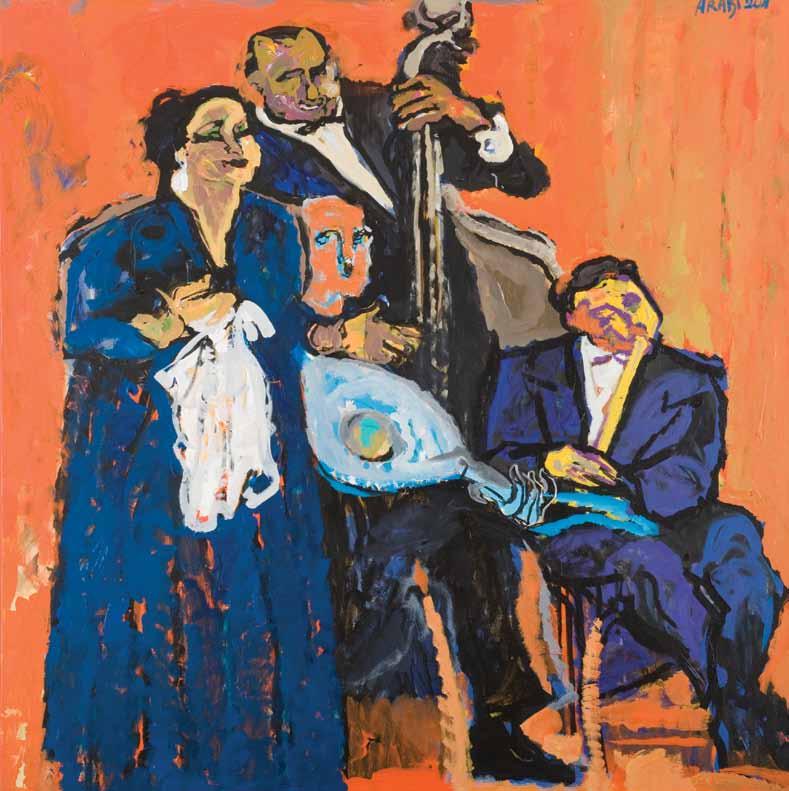
105
The Turquoise Note 150 X 150 cm. Acrylic on Canvas 2011
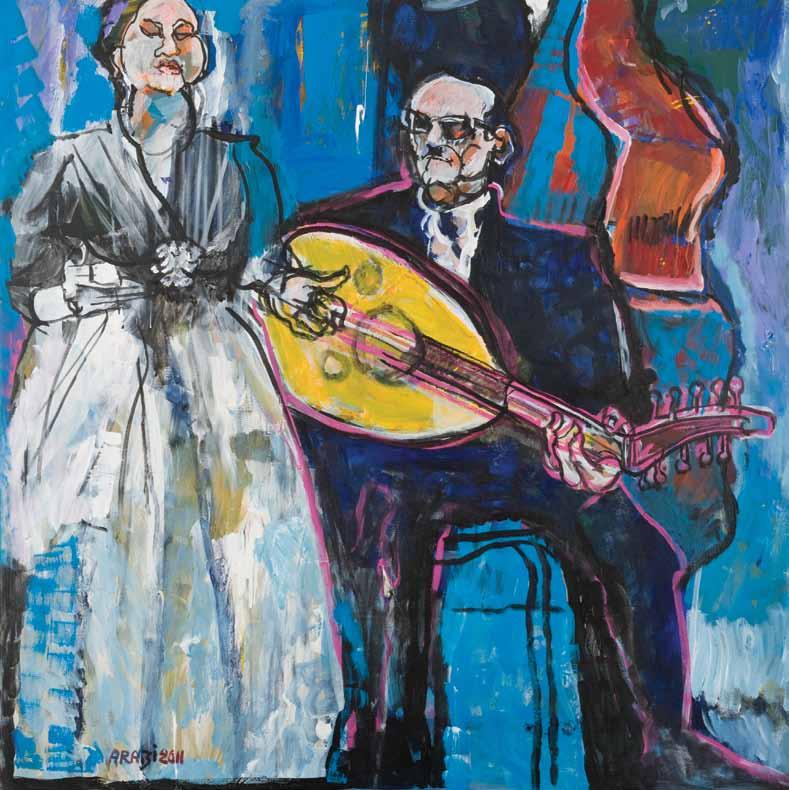
107
Talk of the Soul 150 X 150 cm. Acrylic on Canvas 2011
ةلاس�ألاا ينب قرفلا ةس�هن ريونت ةداعإلا ةيليكس�ت ةس�رف اهنأاو ةس�اخ ،يننح مدآاو يموكلا ليثاتمو فحتم نم ثركأا :قحتس�ت .ةيعبتلا يداحألاا بيرغتلاو )يس�الما س�يدقت( يس�رلما س�وكنلا ينب طللخا مدعو ،ينجهتلاو ديدجتلا ينب قرفلاو ةيلوس�ألااو .)يليكس�تلاو( يقيس�ولما لياملجا ناحتملاا بجوتس�ي ام وه :يدجولا - يعامس�لا - يقوذلا - نيافرعلا دعبلا - 3 ،اتلدلا في اهتيرق في لوس�رلل ةثلاثلا تنبلاب انميت موثلك مأاب اهتيمس�ت نم ءادتبا ةينيدلا اهتئيبو موثلك مأا ةيبرت زواتج نكيم لا ةبوهولما هتنبا لىإا ةينافرعلا هتيس�اس�ح لقن .هنآارق لترمو هبيطخو هنذؤوم عمالجا دجس�لما مامإا »يجطلبلا« اهدلاو ناك دلاولماو ةينيدلا حيس�اوتلا تارس�ح في ةكراس�م )ىثنأا اهنأاب فرعي لا ىتح( روكذلا بايث في لفرت يهو هعم لمعت تحبس�أاف مث هليترتو هتءارق نهتتم نأا لبق بلق رهظ نع هروس�و هتايآا تظفح .ةينآارق ةس�ردم في اهتس�ارد تتمأا نأا دعب ،راكذألااو انهو .زيزعلا دبع ةلئاع لثم ةرهاقلا ءايرثأا رود لس�و مث ةرواجلما ىرقلا عامس�أا ةغبانلا اهتوس� ةعمس� تقرط ىتح ،هديوتج ىلع فرس�أا دقف .فيوس�لا داس�نإلاا نم ةنس� 12 دعب لوس�رلا ةحادبم تمس�و نأا دعب اهتنهم في يس�اس�أا فطعنم لىإا لس�ن خيرات 1927 و 1922 ينب ام ةرهاقلا في اهعم س�اع ،ليوملحا هدبع ذيملت دممح لاعلا وبأا خيس�لا وهو اهل نحلم لوأا اهبيردت عباتو داؤوف كللما اهانبت مث .»بلطلاو ىنلما تنأا كقحو« :ليوملحا هدبع رود اهل نلح ،نحلمو رعاس�و نذؤومو مامإا وه .هتافو عنم امدنعو ،»يمد فيو يرطاخ في يتلا رس�م« تنغف ينيدلا بلاغي يرس�لما ينطولا اهس�ح ادب .قوراف كللما هنبا اهماركإا نم تامارهألاا عنتم لا اذالم« :بيجنل لائاق رس�انلا دبع اهرابتعا داعأا 1952 ماع ةيرس�لما ةروثلا عم بينج دممح اهيناغأا تأادب .ةعاذإلاا لىإا ةوقب تداعو عبارلا مرهلاب فس�وت اهنأاب اهلوح زاجلما عاس� ،انه نم ،»يكللما دهعلا في تناك دقف ءامس�لا قس� موثلك مأا تحبس�أاو .)ةس�ملخا ملافألاا نمس� دادو مليف تلثم( 1935 امنيس�لا اهتعبت ،1973 ماع ىتح تلظو 1934 ذنم اهيف لس�ت دق امك ،تاعاس� س�مخ لىإا اهلفامح لس�ت دقو ةعاس� للاخ اهل ةينغأا لفح عيذت رهس� لك لوأا نم س�يملخا ةرهس� لتتح ةرم لك في ترمتس�ا ينموي للاخ ينتلفح س�يراب في ايبلموألاا حرس�م في دعب اميف لاثم تيحأا .ةثلاثلا لىإا ةدحاولا نم اهتلاس�و مث ةيكبزألاا حرس�م في ترقتس�ا ىتح رخآا لىإا حرس�م نم لقنتت تناك دقف ةركبلما ةينيثلاثلا ةترفلا في امأا .احابس� ةثلاثلا ىتح .اهاوس�و اربوألاا راد مث كلامزلا ةملح توس�لاو نحللاو ةملكلا نم لعجي نم وه ،يمار دمحأا رعاس�لا ،ثلاثلا مازتلا بناج لىإا يقوذلا امهفلاتح ىلع يحورلا .اهتافو ىلع دوقع ةعبرأا نم برقي ام دعب ةيقاب تلاز لاو ،ةدحوتم ةيبلق دممح دوعلا فزاعو نحللما مهلوأا :رابكلا ةس�ملخا ءلاؤوه نم ،ينقوفتلماو نيديجلما ينفزاعلا نم ةبخن ةمحللا هذه معد نامكلا فزاع مث لماس� ديس� لوجلخا يانلا فزاع امهيلي حلاس� هدبع دممح تختلا دئاقو نوناقلا فزاع مهيناثو يجبس�قلا ذنم عربألاا برتعي يفيفع ميهاربإا وهف )ةكبردلا( عاقيإلاا براس� امأا ،ةمظع دمحأا س�ابترنوكلا فزاعو يوانفلحا دمحأا لوألاا ةمحازلما ةينفلا ةميقلا نم زيامتلا اذه س�قني لا .رونأا نس�ح بناج لىإا يموثلكلا تختلا لىإا ةيدهلما ةيرنم تخت نم لقتنا نأا .نامكلا وفزاع تايرتولا ةعوممج مث وليس�تلا ىلع يثلاثلاو عاقيإلاا يبراس� ةس�اخ ةيقبلل وبأا خيس�لا نم ءادتبا يننحللما عربأاو مهاوس�و يس�نوتلا ميربو يمار دمحأاو يقوس� دمحأا ينب ام ءارعس�لا زربأا موثلك مأا تبطقتس�ا تلائاعلا اهتمعد امك ،يطابنس�لل ةبس�لخا فافس�لا ىلع ينحلتلا بكرم وس�ري نأا لبق يجبس�قلاو دمحأا ايركزو دممح لاعلا ىلعو ،ةيروهملجا ةروثلا رس�ع في رمألاا كلذكو ،قورافو داؤوف :ةترفلا هذه يكلمو زيزعلا دبع ةلئاع لثم ةرهاقلا في ةرس�ولما ليابريللا وأا يوس�هنلا فياقثلا زمرلا مويلا ىتحو اهرابتعاب ينحلس�لما ةبكوك نم معدلا اذه تم .رس�انلا دبع ميعزلا س�خألاا في اهتيبعس� خوس�ر مغر ،ىنرس� امك ةيوبخن ةغيس� نمس�و رس�ع عس�اتلا نرقلا ةياهن في يننحللما يرطاس�أا ديلاقتو ةركاذل لثمتلما يتوس�لا يدجولا خانلما ةكايح ةداعإا ةلوامح في موثلك مأا لوح تاحوللا نيواكت »ةيفارغوبوط« ءلاؤوه مس�اقتي .تاقبطلا ىتس� .ةيليكس�تلا ةغللاو ناولألااو طوطلخا قيرط نع ةبكوك لىإاو .ةبطرق في بايرزو دادغب في يلس�ولما لىإا لس�ي دق ،رباغ يقيس�وم فياقث دمج لىإا يننح »قاوس�أا« اهثارت كليم ليج دعب لايج ةيماترم »قاوس�أا« .يلحا دبع حلاس�و نامثعب ارورم س�يورد ديس� ىتحو ليوملحا دبعو ظلمأا نم ةس�هنلا دقع جمارب نم مويلا لمهلماو )دجولاو عامس�لا بادآا في ليازغلا هحرس� امك( »يعامس�لا« فيوس�لا »قس�علا« ةرس� لبحب كس�متت ىلع( هنباو نيوتلا دمحأا خيس�لا قيرف وأا )ةيلذاس�لا ةقيرطلا ىلع( »يماهتلا« دس�نلما لاثمأا لثم هلثم ،تايئاس�فلاو تاعاذإلاا رس�ع عبارلا نرقلا ذنم رطلخا س�وقان تقد يتلا نودلخ نبا ةءوبن عم يدترلا اذه قباطتي ،)ديعس�لا في ةيرداقلا ةقيرطلا هعجارتو هللاتخا دنع نارمعلا نم عطقني ام لوأا« :ةمدقلما في لوقي ،ةيرس�لحا ةقئاذلا في ةيس�رلما رهاوظلا مهأا لىإا اهبنم .»ءانغلا ةعانس� فيهرلا اهتخت ءاس�عأا كلذكو مويلا لىإا ايح يقابلا يمار - يطابنس�لا - موثلك يثلاثلا ثايرم لاز لاو اناقيس�وم داس�ف رخأا ابم ةماعلا ةيقيس�ولما ةقئاذلا ايثرلا هذه تس�عنأا .يطابنس�لاو يجبس�قلا ىتحو دمحأا ايركزو لاعلا وبأا ذنم يننحللما ةبكوكو

تحبس�أاو هنيحلت نم اهنأا اطخ تنظف ،دممح لاعلا وبأا اهايإا اهنقل ،ليوملحا هدبعل تعطقنا اهنكلو .ةفاحس�لا في ةحيس�ف اهؤوطخ راثأا امدعب ةقدو ةيقيثوت ةيرغ دس�أا »ىنثتي ادب الم« حس�وم بولس�ملل تنغ نأا دعبو ،تانيثلاثلا ذنم راودألاا ءانغ نع كلذو ،ةيودبلا ةيفوس�لا ةقيرطلا )ةعاذإلاا حاتتفا خيرات( 1932 ماع تلجس�و .يثيللا ركذلا نم عطاقم اهئادأاب هعم فعاس�تي ،دجولا لاوحألا ةمجرتو رخأاتم يوس�هن موهفم وهف »برطلا« امأا ميس�اقتلا ةيناحور في قارغتس�لاا قيرط نع نحللا نع يلجتلما دورس�لاو حطس�لا ،)مويلا عئاس�و نهار راترجا نم يرجي ام س�كعب( راركتلا لبقت لا يتلا اهلاوحأاو ،س�كعلاب س�كعلا وأا ةينحللا اهتاقايس� في ةفيهر تايرغت عم ةيس�نلا ةلملجا دواعت دق .هتادرفم نم ينبت لا ءازجأا وأا يرعس�لا س�نلا تاملك لدبتتو نحللا تبثي ةفاهرو اهتبهوم ترذن دقف ،اهتايح ءانثأا ةيقوذلا موثلك مأا قئارح راوأا بخي لم – ةيدوجولا – ةينادجولا« :اهقاوس�أا راحب يرجفتل اهترجنح ةيس�اس�ح فيفر ،برعلا دنع نيرس�علا نرقلا ءانغ مثلكت اهتبرتج ءادس�أا ترمتس�او ،»ةيدجولا دادح في مويلا كلذ ذنم لماعلا قرغ ثيح 1975 ماع اهتافوب انباس�م دعب كلذو تماخ دممح ناك امك تابرطلما ةتماخ« :اهنأاب نانبل ءارعس� دحأا اهمس�وي ،ديدم .»ءايبنألاا :اهنم ةيرعس� ةقرحب يمار دمحأا ميتلما قس�اعلا اهتنس� في اهاثرو اهيناغأا ىجس�أا نم تعنس� يذلا دعب اــهيثرأاس� نيأا يرطاخ في لاج ام اهيكـــــبأاو يكـــــبأا ينعمـــــس�أا موــــيلاو ينبرطتف ودس�ت اهعمـس�أا تنك دق اهيراــب نوكلا عـــيدب يــــبر ناحبـــــس� هئــــــلآلا ىــــهـبأا اـــي نـــفلا ةرد اـــي للاهتس�ا -2 ةيقيس�ولما هتركاذ ينناحأا مس�اقتت ،عوس�ولما اذه مهلتس�ا نم لوأا تس�ل نيأاب كس� لا مأاوتلا اذه ةيدبأا دمتعت .يطابنس�لا دوع نالحأاو موثلك مألا ةيبهذلا ةرجنلحا بادآا ناونع تتحو »نيدلا مولع ءايحإا« هفلؤوم نم نياثلا ءزلجا في ليازغلا دماح يبأا ىدل لاس�فم هدنج ام وهو ،)ةعادرقلا( ةزجعبم ىنج يذلا يرس�يلا رذنلا لاإا اهنم قبي لمو اهعيمج ترثدنا ىقيس�ولما في ةيثاترلا انتبتكم نإاف فس�ألال .دجولاو عامس�لا .هيرغو بس�عتلاو ءافخإلااو يرمدتلا نثارب نم ثيحب ،فزاعلاو برطلما ينغلما وأا لاوقلا وأا دس�نلما حطس� في هيبس�تلاو ىنعلما بوذي ىتح يس�نلا يرثأاتلا »هيزنتلا« ةفس� زواجتت نترقي ،نافرعلاو »قوذلا ةعامج« ـب يعامس�لا توختو قرف ىعدت كلذل ،نياعلما تهاتم املك ةيحورلا ةقئاذلا ىوتس�م عفتري .ديرجتلاو ديرفتلاب داتحلااو ،ناس�حإلااب »قوذلا« عيقوت نم ادتبا ،تلاس�ولاو تابونلاو تاماقلما ىتس� رس�اعلا نرقلا ذنم هنع تس�اف يذلا عبنلا ةباثبم يعامس�لا رئاخذ برتعت ةس�هنلا ملاعأا ىدل كلذ لبق ارمتس�م ،)ىنرس� امك هس�فن يطابنس�لا س�اير هديلاقت خس�ر ام وهو( يبرعلا رعس�لا روحبو نازوأا تاحس�ولماو دودقلاو ليايللاو حئادلماو دلاولماو راودألااو ليلهتلاو يربكتلاو ناذآلاا ناولأا نم هيلع اوفرعت ،بلحو ةرهاقلا ينب ام .عقولما يرهلجا لىإا س�رخألاا يبلقلا ركذلا هيف لوحتي يذلا وه ،ركذلاو حيبس�تلا هرداس�م مهأا لعل ،لجزلاو هنكلو ،يانلا هنم عنس�ي يذلا بس�قلا ركس� ةولاحو يئافس�لا قايترلا يرثأات يس�يرقلاو ليازغلا لىإا ةبس�نلاب يعامس�لا كليم .نيرمتلا ءانثأا ةماعلا لفاحلما في ىس�ق ديرم نم مكف ،دجولا ةبرتج ىلع بردتلا يعس�اوتلما لىإا ةبس�نلاب مومس� لىإا بلقني دق ةعاطلاو ناعذإلااب ليازغلا ىدل طبتري كلذل ،درجتلاو ةاجانلماب لاوقلاو لالحاب ديرلماو ملعلاب يعامس�لا لىإا ئدتبلما يغس�ي انه نم .»نايمإلاا هبلق كليم لا انذأا كليم لا نمو ،انذأا كليم لا ىقيس�ولما س�س�حتي لا نم« نأا برتعيف يماطس�بلا امأا ،عوس�لخاو .»ةنلجا باوبأا ريرس� يعامس�لا« نأا )ةيولولما بحاس�( يمورلا نيدلا للاج انلاوم برتعي ةيقيس�وم ةركاذ ظفحي .ةيفوس�تلا يعامس�لا ديلاقت ةفاهرب س�تمخ يقيس�ومو دس�نم هنألا )يتاوكلحا س�يقن وهف( لاوقلا امأا .تختلا فيزاع ةيقب عم ةيدجولا لفاحلما تارس�حو تابس�انلما قفو ةجالحا دنع اهءارث يعدتس�ي ،بس�نت لا ةيقوذ ةيس�نو ركذي امم ،هحاون ةطبغو هنينأاو ،هيرفزو هقيهس�و هبلق تاس�بن عم ةلس�اوتم ،هنس�ح في ةيقيس�ولما هتلآا اقناعم ءانغلاب حدس�ي .ماملحا رئاطل يردس�لا س�فقلا نم اهعمس� قودنس�و »دوعلا ةلآا« لكس� اومهلتس�ا مهنأا ةدئابلا برعلا نع لاقي هنأاب لىإا ،س�وقطو لوس�أا لىإا عس�خي .ةلفلحا :رس�م في ةس�هنلا رس�ع عم تعاس� يتلا ةيمس�تلا في لس�ألاا وهف لفحلما حلطس�م امأا قفو اهبتارمو س�وقطلا هذه تلايوأات فلتخت .يعاقيإلاا ينحللا دجولا ةوبس� جيردتلاب س�ملات تارباكمو تادهامجو تاس�ايك .يطابنس�لا – موثلك يئانثلل ةيتاركاذلا ةيبترلا يه .يقوذلا بهذلما ةقيرط »برس�لا كتميس� عمدلا يس�ع كارأا« ةينغأاب ةيداس�نإلاا اهتيرس�م ةئدتبم ،دعب يطابنس�لا فرعت نكت لمو ،تانيرس�علا في تنغ

:يعامس�لاو Astre de L’extase دجولا بكوك - )Préambule(لخدم - 1 – موثلك« :يئانثلا س�وقطل ةيحورلا س�ئاس�لخا فلخ عقت يتلا يه .ةينافرعلاو ةيقوذلا ةيوبترلا ةيس�رألاا ةعجارم نم دب لا نوس�تخلما بنجتي يتلا اهميهافم س�عبو ،ةيفوس�لا قرطلا باحس�ألا ،داس�نإلاا في لفاحلما لوس�أا ةس�اخ اهنم ،»يطابنس�لا ةيدرألاا ةغللاو ةرس�لحاو ينلاوقلاو يعامس�لا :هذه تاعونملما ةمئاق نم ركذن ،ةيلوس�ألااو ةلاس�ألاا ينب مهطلخ ببس�ب اهركذ يلع تحاف ترس�ن ةغل( ةيناتس�كابلا ةيدنهلا انايحأاو ةيكترلاو ةيولهبلاو ةيبرعلا :ثلاثلا تاغللا اهتافيلوت في تحقلات يتلا تايروطابرمإلاا رس�ع ،رس�ع س�داس�لا في ترهدزاو رس�ع عبارلا نرقلا ذنم تس�س�أات يتلا يه .)امهاوس�و يبرس� ةوخألااو ناخ .اهاوس�و ةيبويألااو ةيكولملما لبق ةيقوجلس�لاو ةيس�ابعلا تابقلحا ءافلخ ،ةيلوغلماو ةينامثعلاو ةيوفس�لا )ديس�رلا نوراه دهع في( يلس�ولما ميهاربإا ذنم يأا ،لىوألاا روس�علا ديلاقت عم ةيقيس�ولما ةيئانغلا ديلاقتلا هذه لس�اوتت انيس� نبإلا »يربكلا ىقيس�ولما« يباتك ذنم ىرحألااب وأا ،س�مالخا رتولا دوعلل فاس�أاو ةبطرق في س�اع يذلا بايرز هذيملتو .نياهفس�ألاا جرفلا يبألا »نياغألاا باتكو« ةيفوس�لا يعامس�لا ىقيس�وم في ةيفس�كلا ةيبلقلا وأا ةيس�دلحا ةرس�لحا ةعيبط لىإا )اهتيدودمح وأا( طيونتلا ةداع بايغ عجري في ادمتعم ،ماعلا يعاقيإلااو ينحللا لكيهلا طوني يطابنس�لا ناك .يقس�مدلا – يواديس�لا لثم ينفورعم يننودم دوجو ليلدب .يهفس�لا ينقلتلا ىلع هتيرح س�ماوهو هليس�افتو هفراخز رس�ع ةعبس�لا اهتاماقم طابتراو ،»يعامس�لا« في ةيفوس�لا ةبرجتلا في ةيئانغلا لاوحألااو ديجاولما ةيروطتو ةيكرح دكؤوي ام وه هناكمو هيف ركذلاو يعامس�لا بادآلا س�س�أا ام وه ،)بايرز دهع في ةنس�لا مايأا ددعب اهددع ناك( هجاربأاو كلفلا مارجأاب موثلك مأ� ق�وش�أ� )1975 – 1898( موثلك مأ� دجول� بكوك ةيموقل� ةيوش�هنل� ةوبش�ل�و فيوش�ل� »يعامش�ل�« ديلاقت ينب ع�رش�ل� 2011 س�يراب ،يبارع دعس�أا ملقب
